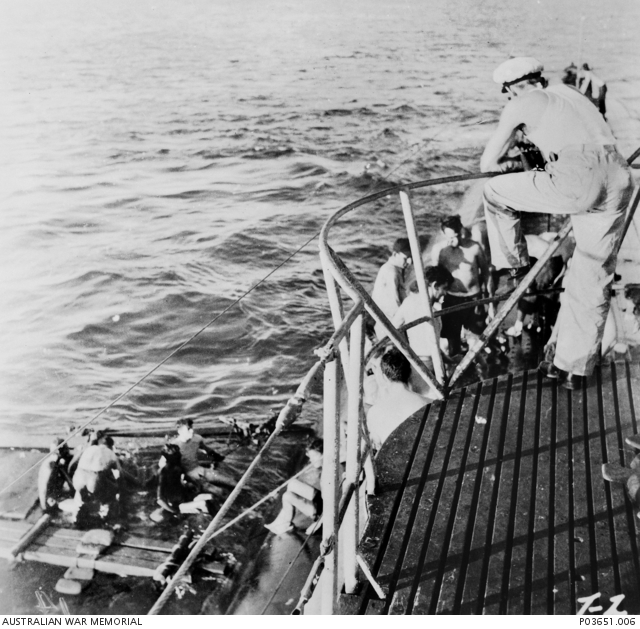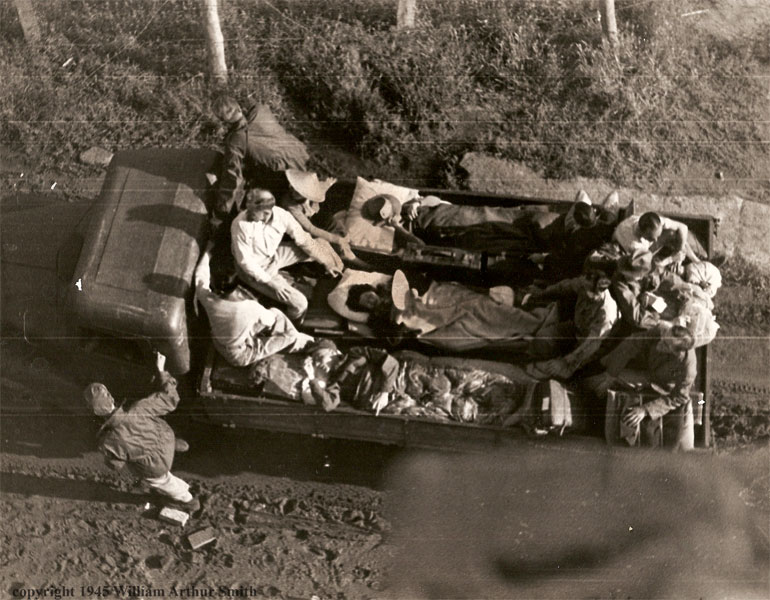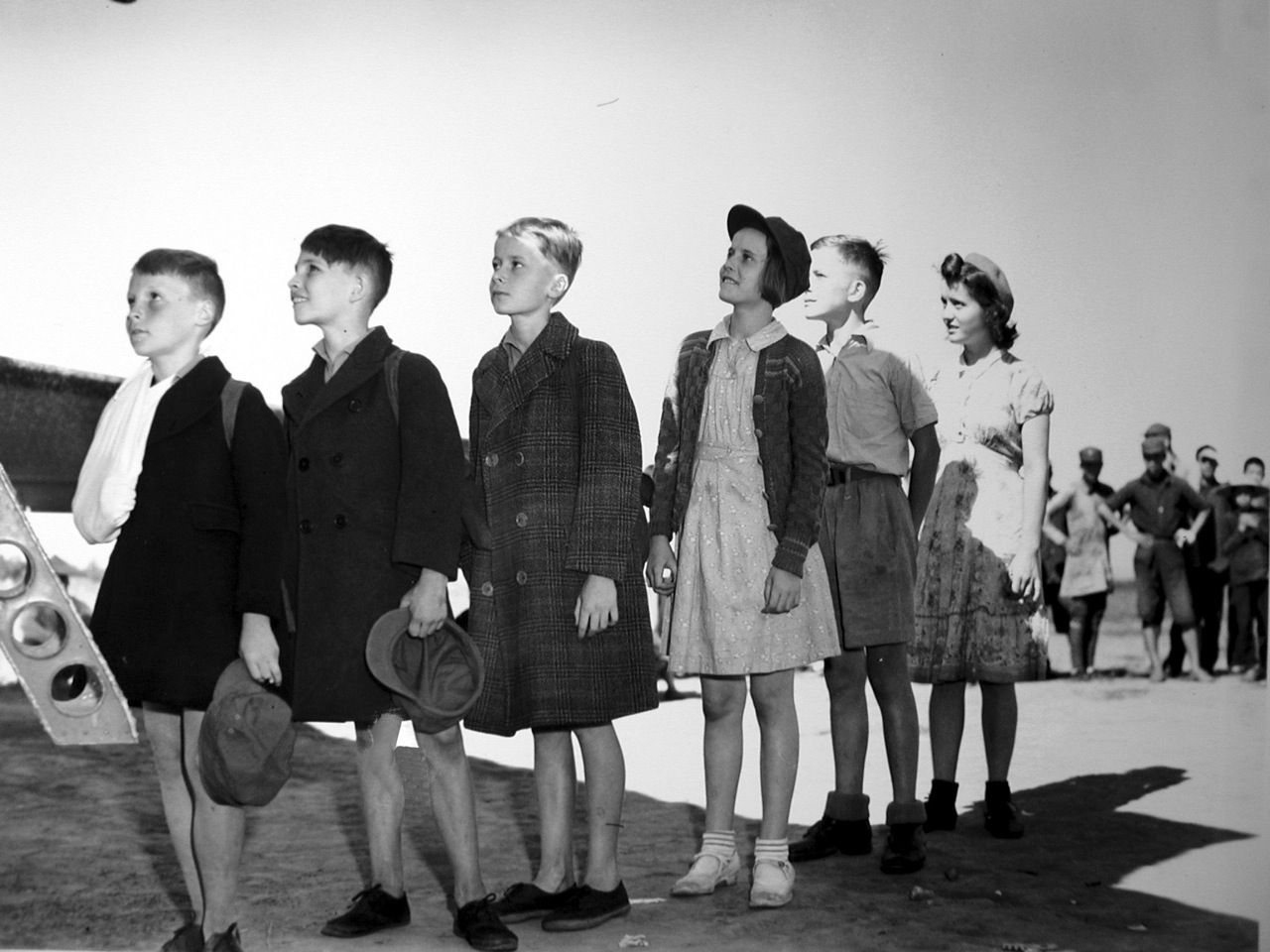From Rod Miller ...
July 27, 1944
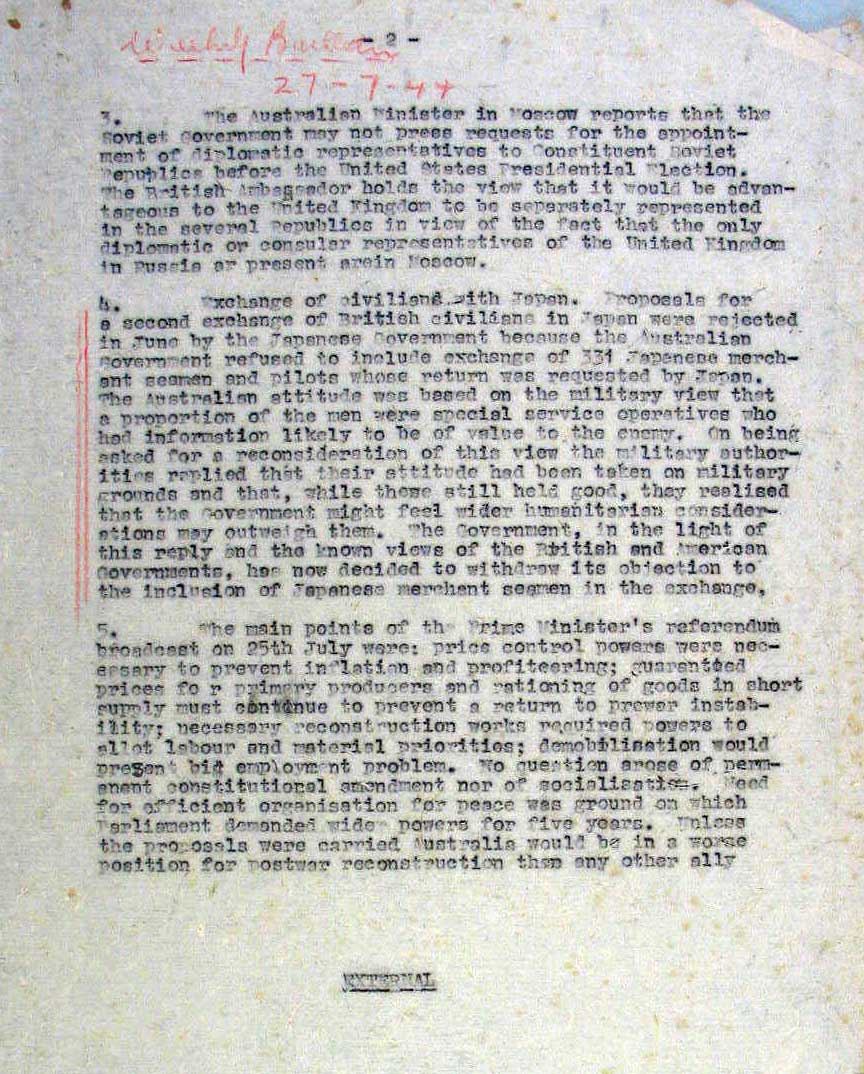
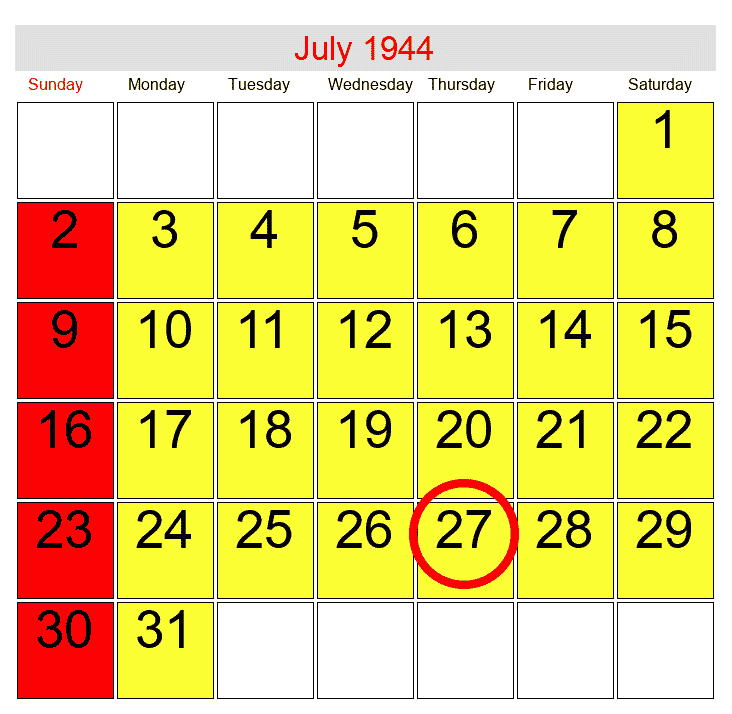
[excerpt]
4.
Exchange of civilians with Japan.
Proposals for a second exchange of British civilians in Japan were rejected in June by the Japanese Government because the Australian Government refused to include exchange of 331 Japanese merchant seamen and pilots whose return was requested by Japan.
The Australian attitude was based on the military view that a proportion of the men were special service operatives who had information likely to be of value to the enemy. On being asked for a reconsideration of this view the military authorities replied that their attitude had been taken on military grounds and that, while those still held good, they realised that the Government might feel wider humanitarian considerations may outweight them.
The Government, in the light of this reply and the known views of the British and American Governments, has now decided to withdraw its objection to the inclusion of Japanese merchant seamen in the exchange.
etc.
November 17, 1944
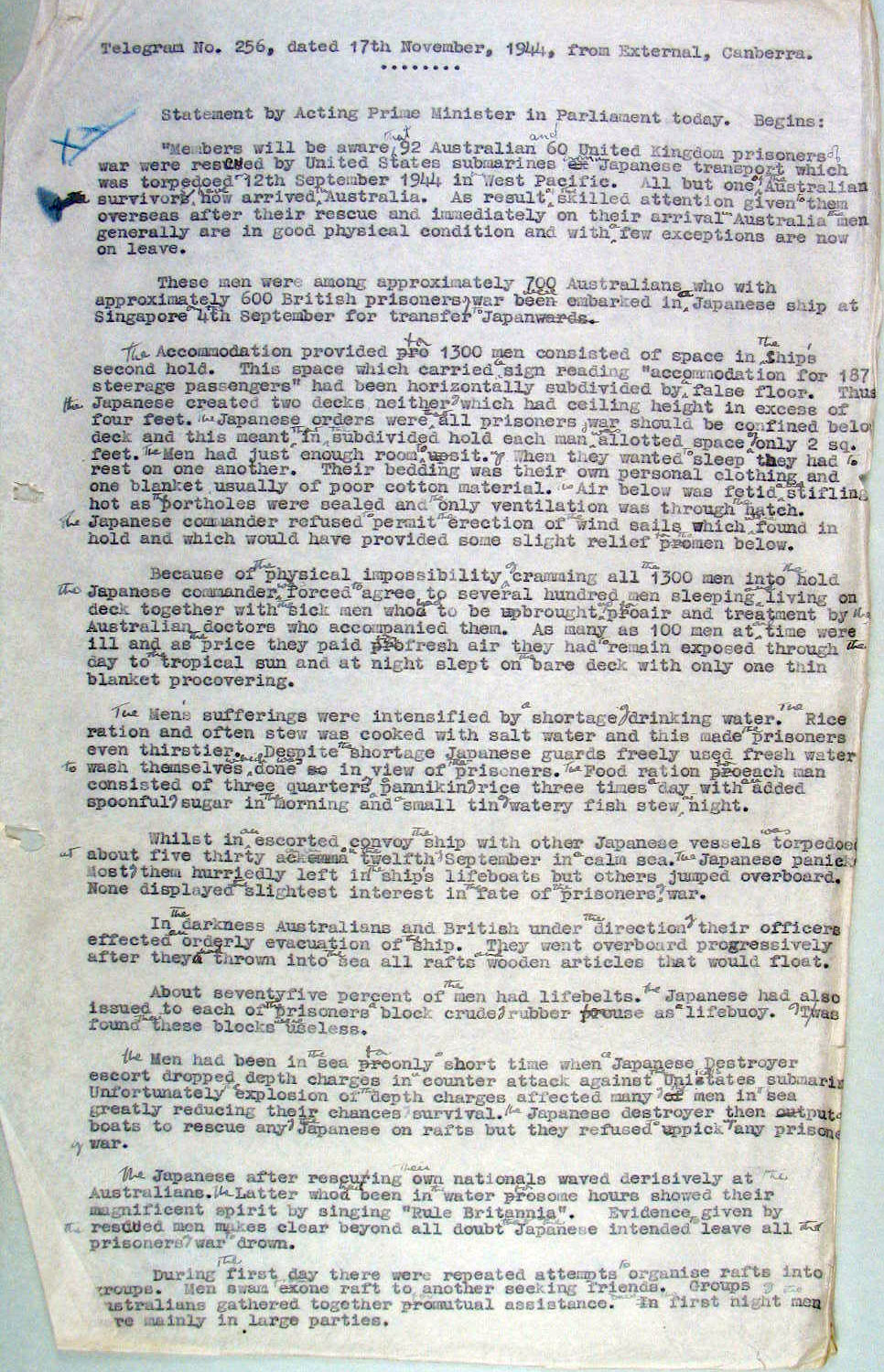
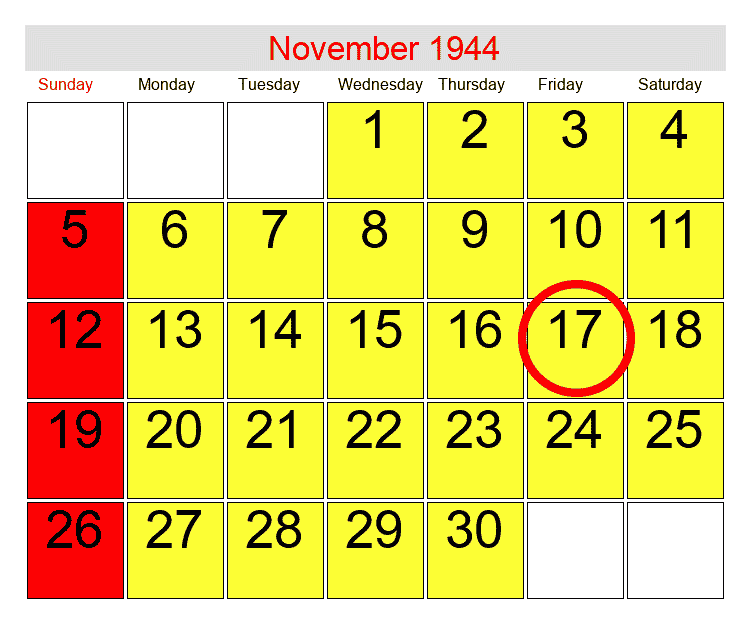
Telegram N°256, dated 17 November 1944, from external Canberra.
Statement by Acting Prime Minister in Parliament today. Begins:
“Members will be aware that 92 Australian and 60 United Kingdom prisoners of war were rescued by United States submarines from Japanese transport which was torpedoed on 12 September 1944 in West Pacific. All but one of the Australian survivors has now arrived to Australia. As result of the skilled attention given to them overseas after their rescue and immediately on their arrival in Australia, the men generally are in good physical condition and with a few exceptions are now on leave.
These men were among approximately 700 Australians who with approximately 600 British prisoners of war were embarked in a Japanese ship at Singapore on the 4th of September for transfer to Japan.
The accommodation provided for 1300 men consisted of space in the ship’s second hold. This space which carried a sign reading “accommodation for 187 steerage passengers” had been horizontally subdivided by a false floor. Thus, the Japanese created two decks neither of which had ceiling height in excess of four feet. The Japanese orders were that all prisoners of war should be confined below deck and this meant that in the subdivided hold each man was allotted space of only 2 sq. feet. The men have just enough room to sit up. When they wanted to sleep, they had to rest on one another. Their bedding was their own personal clothing and one blanket usually of poor cotton material. The air below was fetid and stifling hot as the portholes were sealed and the only ventilation was through the hatch. The Japanese commander refused to permit the erection of the wind sails which were fond in the hold and which would have provided some slight relief to the men below.
Because of the physical impossibility of cramming all the 1300 men into the hold, the Japanese commander was forced to agree to several hundred men sleeping and living on deck together with the sick men who had to be brought up and for air and treatment by the Australian doctors who accompanied them. As many as 100 men at one time were ill and as the price they paid for fresh air, they had to remain exposed through the day to the tropical sun and at night slept on the bare deck with only one thin blanket as covering.
The men’s sufferings were intensified by a shortage of drinking water. The rice ration and often stew were cooked with salt water and this made the prisoners even thirstier. Despite the shortage, Japanese guards freely used fresh water to wash themselves which was done in view of the prisoners. The food ration to each man consisted of three quarters of a pannikin of rice three times a day with an added spoonful of sugar in the morning and a small tin of watery fish stew at night.
Whilst in an escorted convoy the ship with other Japanese vessels was torpedoed at about five thirty on the twelfth of September in a calm sea. The Japanese panicked. Most of them hurriedly left in the ship’s lifeboats but others jumped overboard. None displayed the slightest interest in the face of the prisoners of war.
In the darkness Australians and British under the direction of their officers effected an orderly evacuation of the ship. They went overboard progressively after they had thrown into the sea all rafts and wooden articles that would float.
About seventy-five percent of the men had lifebelts. The Japanese had also issued to each of the prisoners a block crude of rubber for use as a lifebuoy. It was found that these blocks were useless.
The men had been in the sea for only a short time when a Japanese Destroyer escort dropped depth charges in a counter-attack against the United States submarine. Unfortunately, the explosion of the depth charges affected many of the men in the sea greatly reducing their chances of survival. The Japanese destroyer then put boats to rescue any of the Japanese on rafts but they refused to pick any prisoners of war.
The Japanese after rescuing their own nationals waved derisively at the Australians. The latter who had been in the water for some hours showed their magnificent spirit by singing, “Rule Britannia”. Evidence given by the rescued men makes clear beyond all doubt that the Japanese intended to leave all the prisoners of war to drown.
During the first day, there were repeated attempts to organize rafts into groups. Men swam from one raft to another seeking friends. Groups of the Australians gathered together for mutual assistance. During the first night, men were mainly in large parties.
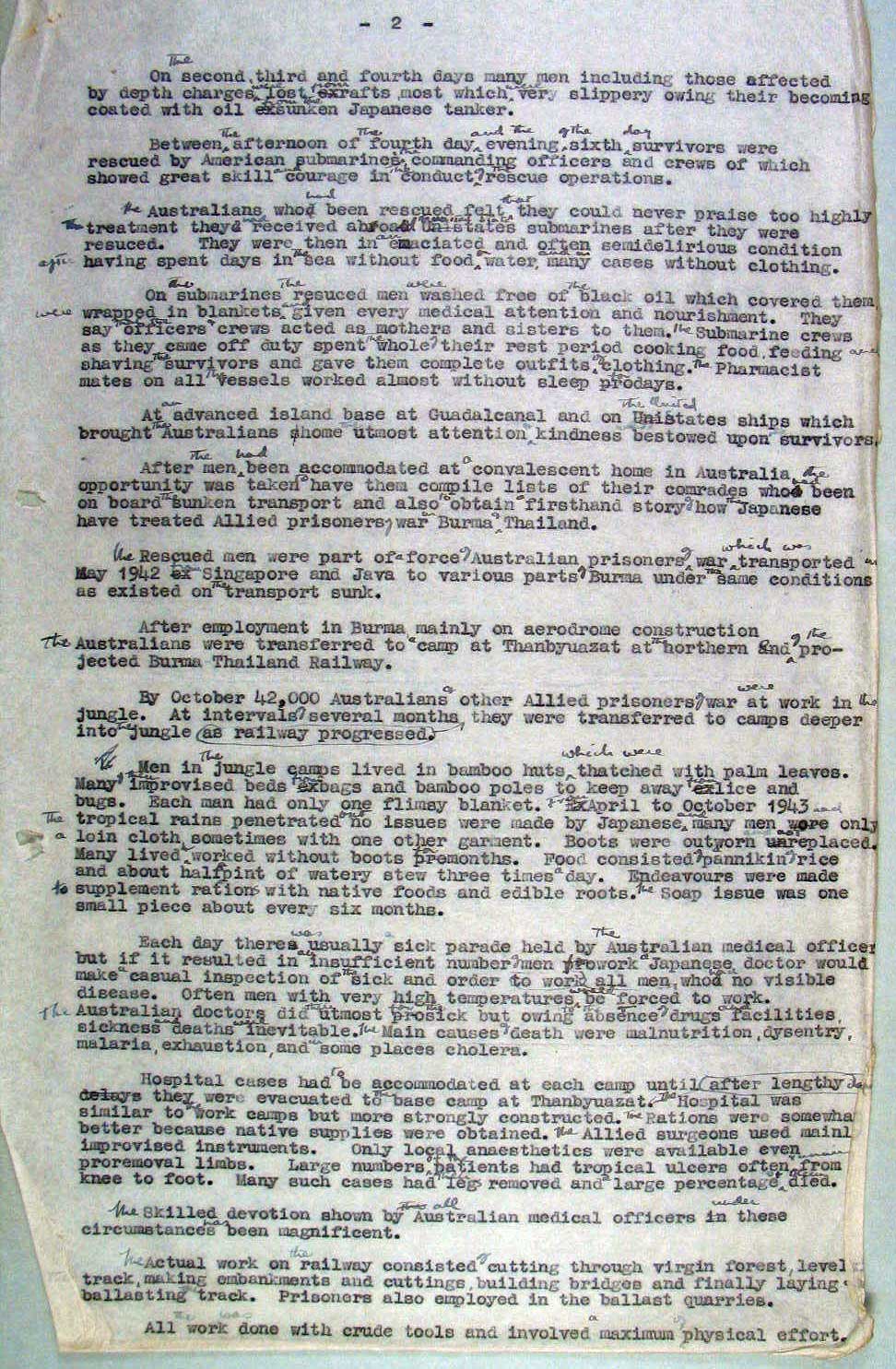
On the second, third and fourth days many men including those affected by depth charges were lost from rafts, most of which were very slippery owing their becoming coated with oil from the sunken Japanese tanker.
Between the evening of the fourth day and the evening of the sixth day, survivors were rescued by American submarines, the commanders and officers and crews of which showed great skill and courage in the conduct of the rescue operations.
The Australians who had been rescued felt that they could never praise too highly the treatment they have received aboard the United States submarines after they were rescued. They were then in an emaciated and often semi-delirious condition after having spent days in the sea without food or water, and on many cases without clothing.
Former Australian prisoners of war are rescued by the crew of USN submarine USS Pampanito (SS-383). These men survived the sinking of two Japanese troop transports, the Kachidoki Maru and the Rakuyo Maru by Pampanito and USS Sealion II (SS-315) on 12 September 1944 respectively.
© Australian War Memorial -
On the submarines the rescued men were washed free of the black oil which covered them were wrapped in blankets and given every medical attention and nourishment. They say that the officers and crews acted as mothers and sisters to them. The submarine crews as they came off duty spent the whole of their rest period cooking food, feeding and shaving the survivors and gave them complete outfits of clothing. The pharmacist mates on all the vessels worked almost without sleep for days.
At an advanced island at Guadalcanal and on the United States ships which brought the Australians home, the utmost attention and kindness were bestowed upon the survivors.
After the men had been accommodated at a convalescent home in Australia, the opportunity was taken to have them compile lists of their comrades who had been on board the sunken transport and also to obtain a firsthand story of how the Japanese have treated allied prisoners of war in Burma or Thailand.
The rescued men were part of a force of Australian prisoners of war which was transported in May 1942 from Singapore and Java to various parts of Burma under the same conditions as existed on the transport sunk.
After employment in Burma mainly on aerodrome construction, the Australians were transferred to a camp at Thanbyuazat at the Northern and of the projected Burma Thailand Railway.
By October 42,000 Australians or other allied prisoners of war were at work in the jungle. Ay intervals of several months, as the railway progressed, they were transferred to camps deeper into the jungle.
Men in the jungle camps lived in bamboo huts which were thatched with palm leaves. Many of them improvised beds from bags and bamboo poles to keep away from lice and bugs. Each man had only one flimsy blanket. From April to October 1943, the tropical rains penetrated and no issues were made by the Japanese and many men wore only a loin cloth sometimes with one other garment. Boots were outworn and unreplaced. Many lived and worked without boots for months. Food consisted of a pannikin of rice and about a half-pint of watery stew three times a day. Endeavours were made to supplement rations with native foods and edible roots. The soap issue was one small piece about every six months.
Each day there was usually a sick parade held by the Australian medical officer but if it resulted in an insufficient number of men for work, the Japanese doctor would make a casual inspection of the sick and order to work all men who had no visible disease. Often men with very high temperatures would be forced to work. The Australian doctors did the utmost for the sick but owing to the absence of drugs and facilities, sickness and deaths were inevitable. The main cause of death wee malnutrition, dysentery, malaria, exhaustion and in some places cholera.
Hospital cases had to be accommodated at each camp until they were evacuated to the base camp at Thanbyuazat after lengthy days. The Hospital was similar to the work camps but more strongly constructed. The rations were somewhat better because native supplies were obtained. The Allied surgeons used mainly improvised instruments. Only local anesthetics were available even for removal of limbs. Large numbers of the patients had tropical ulcers often from knee to foot. Many such cases had their legs removed and a large percentage died.
The skilled devotion shown by all Australian medical officers under these circumstances has been magnificent.
The actual work on the railway consisted of cutting through virgin forest, levelling track, making embankments and cuttings, building bridges and finally laying and ballasting the track. Prisoners also employed the ballast quarries.
All the work was done with crude tools and involved a maximum of physical effort.
Former Australian prisoners of war are rescued by the crew of USN submarine USS Pampanito (SS-383). These men survived the sinking of two Japanese troop transports, the Kachidoki Maru and the Rakuyo Maru by Pampanito and USS Sealion II (SS-315) on 12 September 1944 respectively.
© Australian War Memorial -
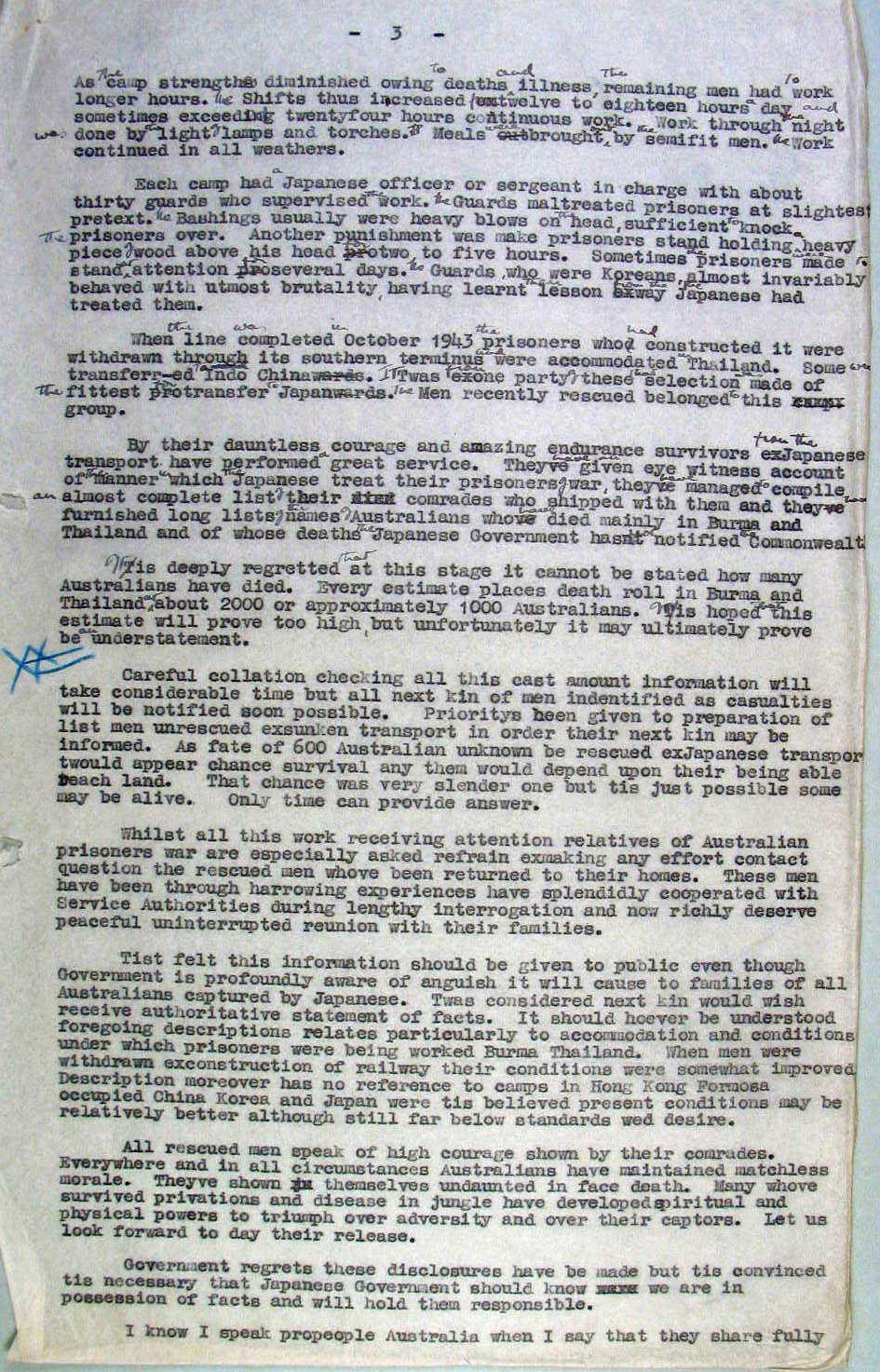
(page-3)
As the camp's strength diminished owing to deaths and illness, the remaining men had to work longer hours. The shifts thus increased from twelve to eighteen hours a day and sometimes exceeding twenty-four hours’ continuous work. Work through the night was done by the light of lamps and torches. Meals were brought out by the semi-fit men. The work continued in all weathers.
Each camp had a Japanese officer or sergeant with about thirty guards who supervised the work. The guards maltreated prisoners at the slightest pretext. The bashings usually were heavy blows on the head, sufficient to knock the prisoners over. Another punishment was to make prisoners stand holding a heavy piece of wood above his head for two to five hours. Sometimes the prisoners were made to stand at attention for several days. The guards who were Koreans, almost invariably behaved with utmost brutality having learnt their lesson from the way the Japanese had treated them.
When the railway line was completed in October 1943, the prisoners who had constructed it were withdrawn through its southern terminus and were accommodated in Thailand. Some were transferred towards Indo-China. It was from one party of these that a selection was made of the fittest for transfer to Japan. The men recently rescued belonged to this group.
By their dauntless courage and amazing endurance survivors from the Japanese transport have performed a great service. They have given an eyewitness account of the manner in which the Japanese threat their prisoners of war, they have managed to compile an almost complete list of their comrades who were shipped with them and they have furnished long lists of the names of the Australians who have died mainly in Burma and Thailand and of whose deaths the Japanese Government hasn't notified the Commonwealth.
It is deeply regretted that at this stage it cannot be stated how many Australians have died. Every estimate places death roll in Burma and Thailand at about 2000 or approximately 1000 Australians. It is hoped that this estimate will prove too high but unfortunately it may ultimately prove to be an understatement.
Careful collation checking all this cast amount information will take considerable time but all next kin of men identified as casualties will be notified soon possible. Priorities been given to preparation of list men un-rescued ex-sunken transport in order for their next kin may be informed. As fate of 600 Australian unknown be rescued ex-Japanese transport would appear chance survival any them would depend upon their being able beach land. That chance was verb slender one but tie just possible some may be alive. Only time can provide answers.
Whilst all this work receiving attention relatives of Australian prisoners war are especially asked refrain ex-making any effort contact question the rescued men who have been returned to their homes. These men have been through harrowing experiences have splendidly cooperated with Service Authorities during lengthy interrogation and now richly deserve peaceful uninterrupted reunion with their families.
It is felt that this information should be given to the public even though Government is profoundly aware of anguish it will cause to families of all Australians captured by Japanese. Twas considered next kin would wish receive authoritative statement of facts. It should, however, be understood foregoing descriptions relates particularly to accommodation and conditions under which prisoners were being worked Burma Thailand. When men were withdrawn ex-construction of railway, their conditions were somewhat improved. Description, moreover, has no reference to camps in Hong Kong Formosa occupied China Korea and Japan were tis believed present conditions may be relatively better although still far below standards wed desire.
All rescued men speak of high courage shown by their comrades. Everywhere and in all circumstances, Australians have maintained matchless morale. They have shown Sat themselves undaunted in face death. Many whose survived privations and disease in jungle have developed spiritual and physical powers to triumph over adversity and over their captors. Let us look forward to day their release.
Government regrets these disclosures have been made but tis convinced tis necessary that Japanese Government should know we are in possession of facts and will hold them responsible.
I know I speak pro-people Australia when I say that they share fully ...
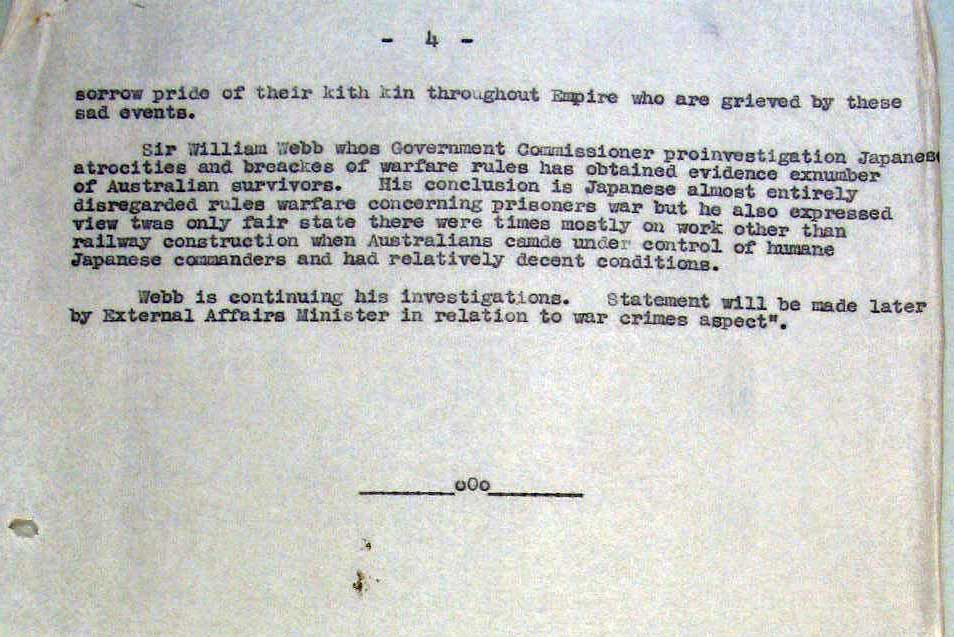
... sorrow pride of their kith kin throughout Empire who are grieved by these sad events.
Sir William Webb whose Government Commissioner pro-investigation Japanese
atrocities and breaches of warfare rules has obtained evidence ex-number of Australian survivors. His conclusion is Japanese almost entirely disregarded rules warfare concerning prisoners war but he also expressed view twas only fair state there were times mostly on work other than railway construction when Australians came under control of humane Japanese commanders and had relatively decent conditions.
Webb is continuing his investigations. Statement will be made later by External Affairs Minister in relation to war crimes aspect".
#
[excerpt]
June 13, 1945
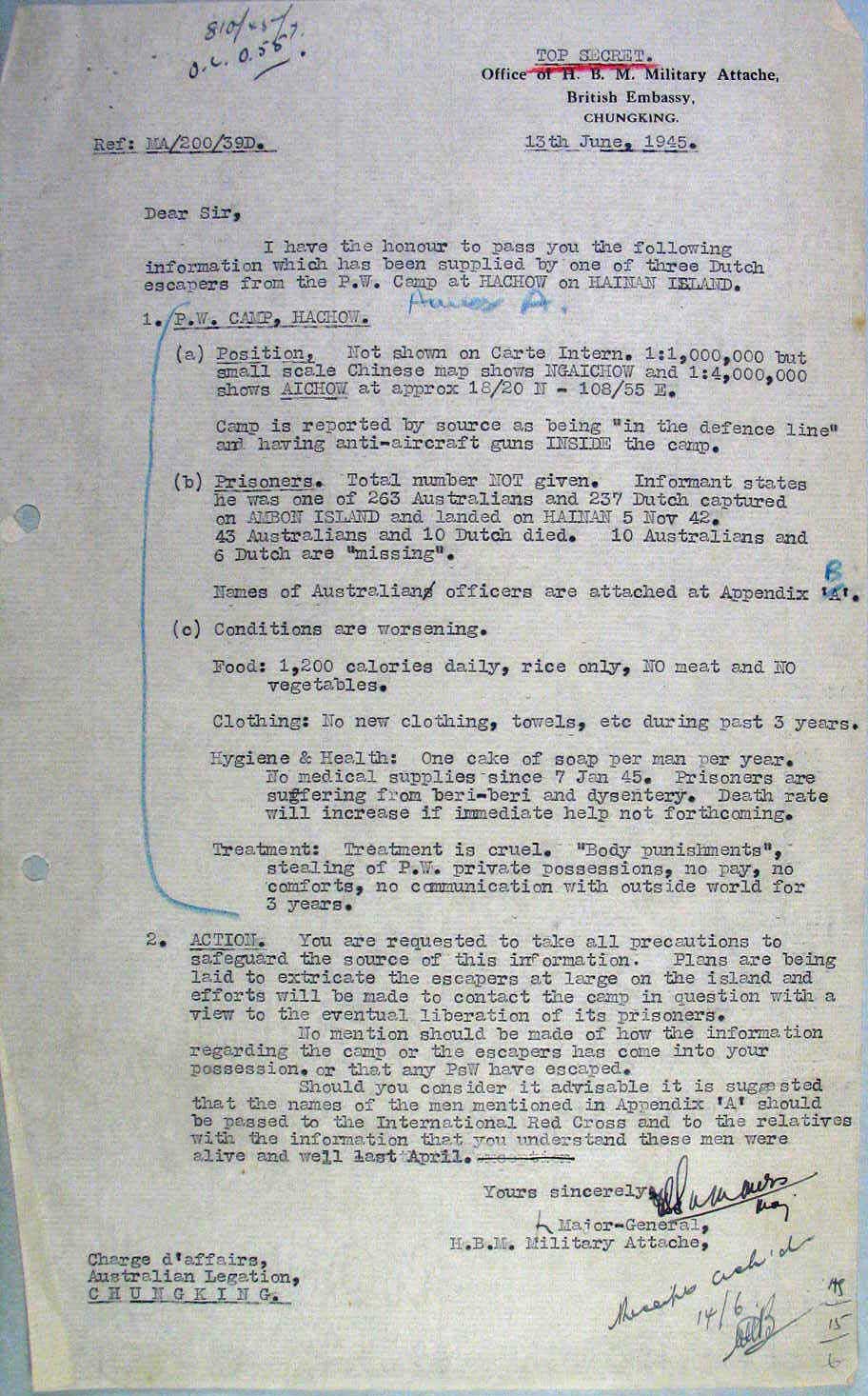
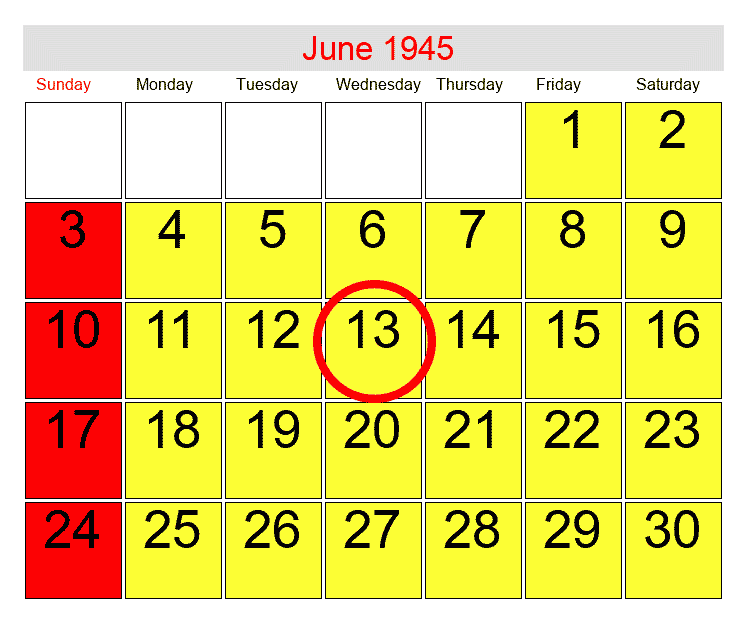
Ref: MA/200/39D.
TOP SECRET.
Office of H.B.M. Military, Attaché,
British Embassy,
CHUNGKING.
13th June, 1945
Dear Sir,
I have the honour to pass you the following information which has been supplied by one of three Dutch escapers, from the P.W. Camp at HACHOW on HAINAN ISLAND.
⇰
1. P.W.CAMP, HACHOW.
(a) Position,
Not shown on Carte Intern. 1:1,000,000 but small scale Chinese map shows NGAICHOW and 1:4,000,000 shows AICHOW at approx 18/20 N - 108/55 E.
Camp is reported by source as being "in the defence line" and having anti-aircraft guns INSIDE the camp.
(b) Prisoners.
Total number NOT given. Informant states he was one of 263 Australians and 237 Dutch captured on AMBON ISLAND and landed on HAINAN 5 Nov 42.
43 Australians and 10 Dutch died. 10 Australians and 6 Dutch are "missing".
Names of Australian officers are attached at Appendix 'B'
(c) Conditions are worsening.
Food: 1,200 calories daily, rice only, NO meat and NO vegetables.
Clothing: No new clothing, towels, etc during past 3 years.
Hygiene & Health: One cake of soap per man per year. No medical supplies since7 Jan 45. Prisoners are suffering from beri-beri and dysentery. Death rate will increase if immediate help not forthcoming.
Treatment: Treatment is cruel. "Body punishments". Stealing of P.W. private possessions, no pay, no comforts, no communication with outside world for 3 years.
⇰
2. ACTION.
You are requested to take all precautions to safeguard the source of this information. Plans are being laid to extricate the escapers at large on the island and efforts will be made to contact the camp in question with a view to the eventual liberation of its prisoners.
No mention should be made of how the information regarding the camp or the escapers has come into your possession, or that any PsW have escaped.
Should you consider it advisable it is suggested that the names of the men mentioned in Appendix 'A' should be passed to the International Red Cross and to the relatives with the information that you understand these men were alive and well last April.
Yours sincerely
For Major-General
H.B.M. Military Attache,
'Chargé d'affaires,
Australian Legation,
CHUNGKING
July 10, 1945
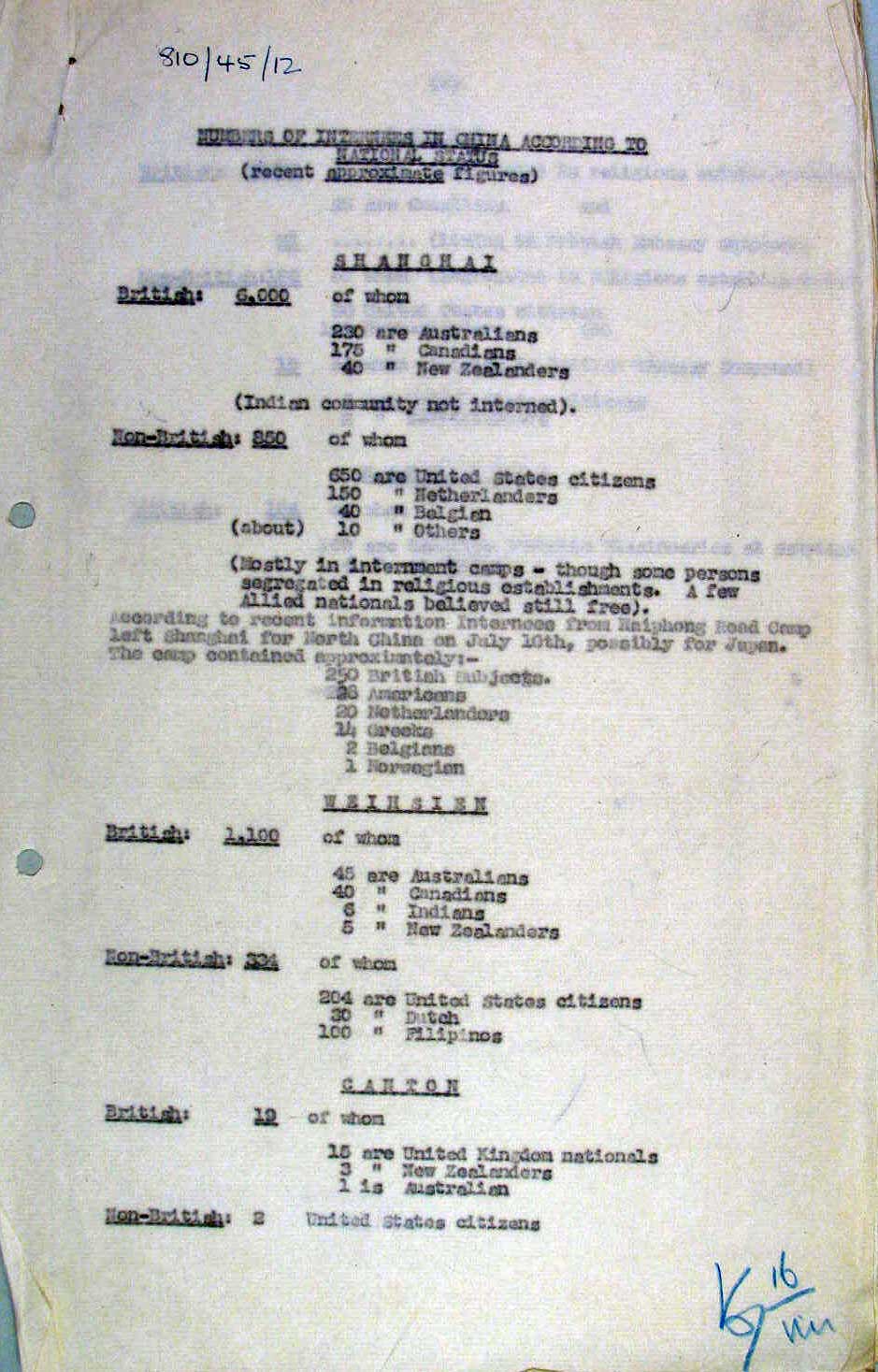
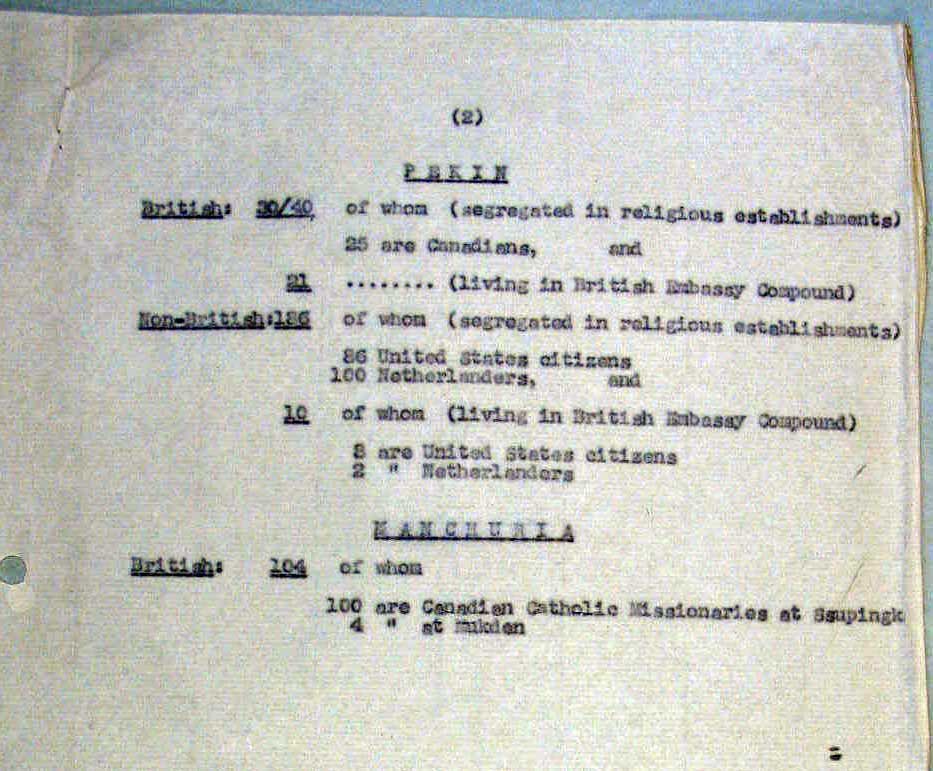
NUMBERS OF INTERNEES IN CHINA ACCORDING TO NATIONAL STATUS
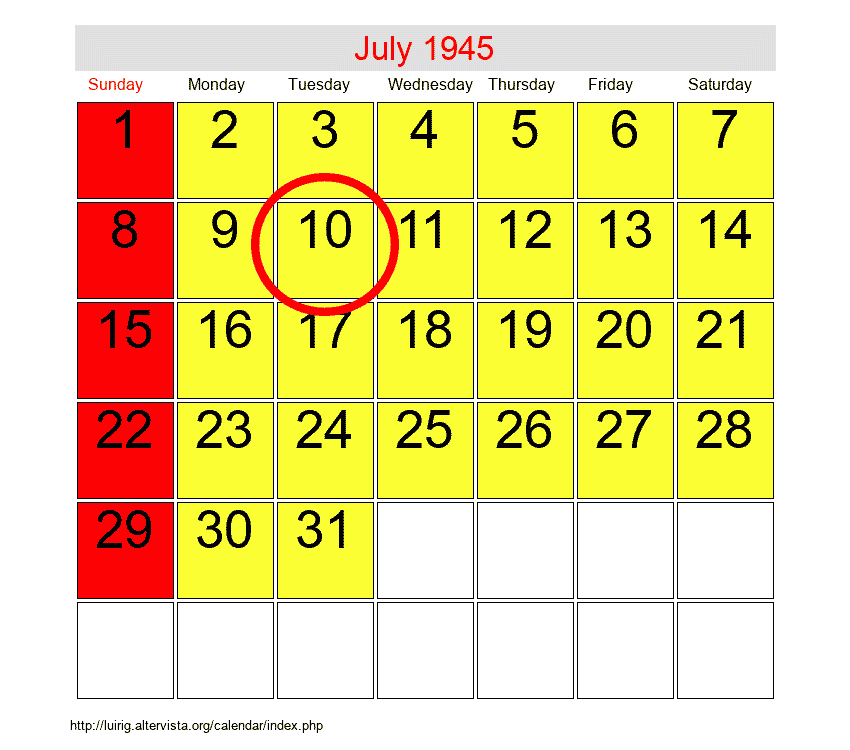 (recent approximate figures)
(recent approximate figures)
[excerpt]
WEIHSIEN
British: 1.100 of whom
45 are Australians
40 are Canadians
6 are Indians
5 are New Zealanders
Non-British: 334 of whom
204 are United States citizens
30 are Dutch
100 are Filipinos
etc.

August, 1945
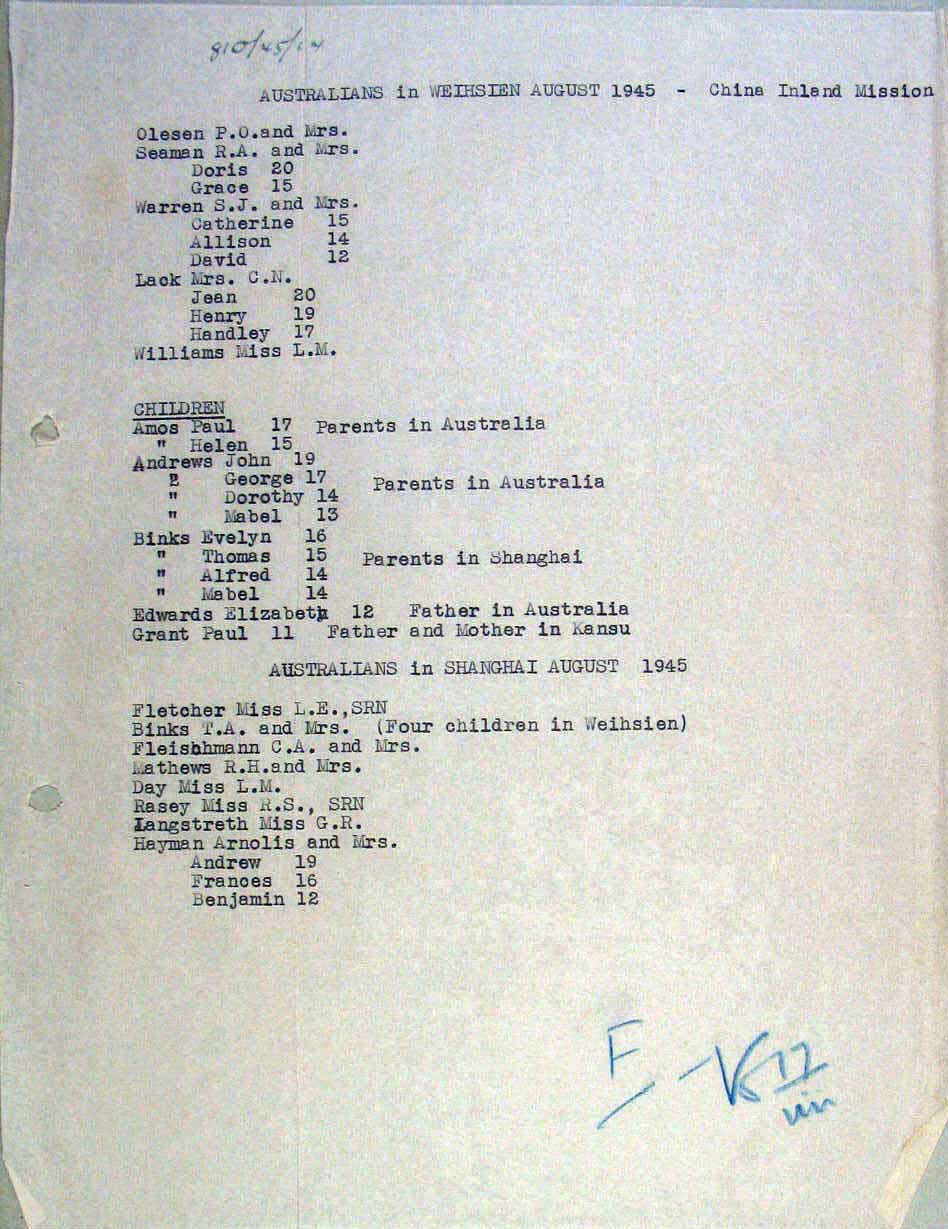
AUSTRALIANS in WEIHSIEN AUGUST 1945 - China Inland Mission
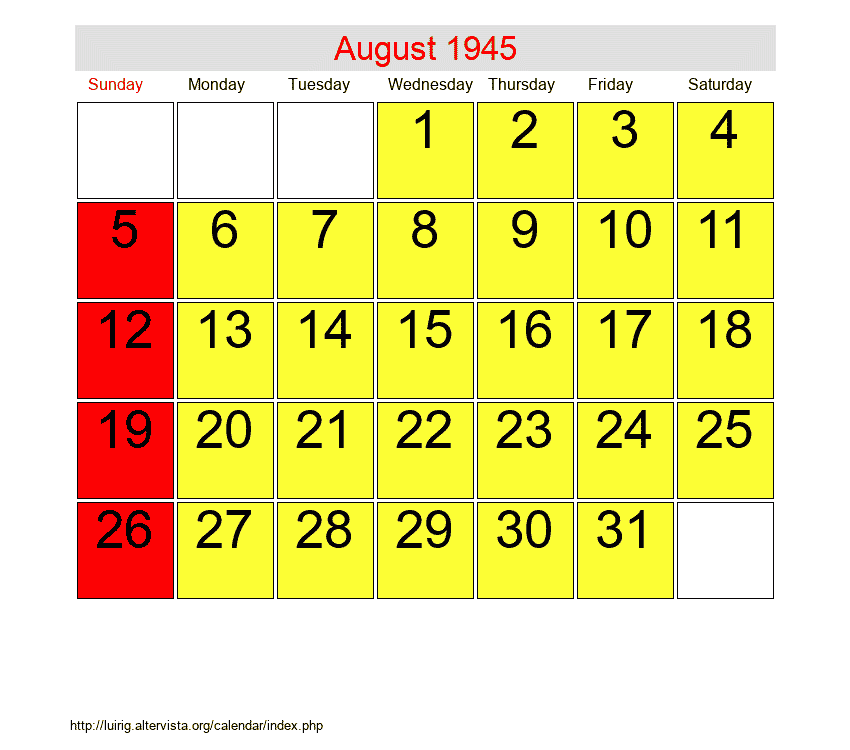 Olesen P.O. and Mrs.
Olesen P.O. and Mrs.
Seaman R.A. and Mrs.
― Doris 20
― Grace 15
Warren S.J. and Mrs.
― Catherine 15
― Allison 14
― David 12
Lack Mrs. C.N.
― Jean 20
― Henry 19
― Handley 17
Williams Miss L.M.
CHILDREN
Amos Pau1 17 ― Parents in Australia
Amos Helen 15
Andrews John 19 ― Parents in Australia
Andrews George 17
Andrews Dorothy 14
Andrews Mabel 13
Binks Evelyn 16 ― Parents in Shanghai
BinksThomas 15
Binks Alfred 14
Bnks Mabel 14
Edwards Elizabeth 12 ― Father in Australia
Grant Paul 11 ― Father and Mother in Kansu
AUSTRALIANS in SHANGHAI AUGUST 1945
Fletoher Miss L.E.,SRN
Binks T.A. and Mrs. (Four children in Weihsien)
Fleischmann C.A. and Mrs.
Mathews R.H.and Mrs.
Day Miss L.M.
Rasey Miss R.S., SRN
Langstreth Miss G.R.
Hayman Arnolis and Mrs.
― Andrew 19
― Frances 16
― Benjamin 12

August 6, 1945:
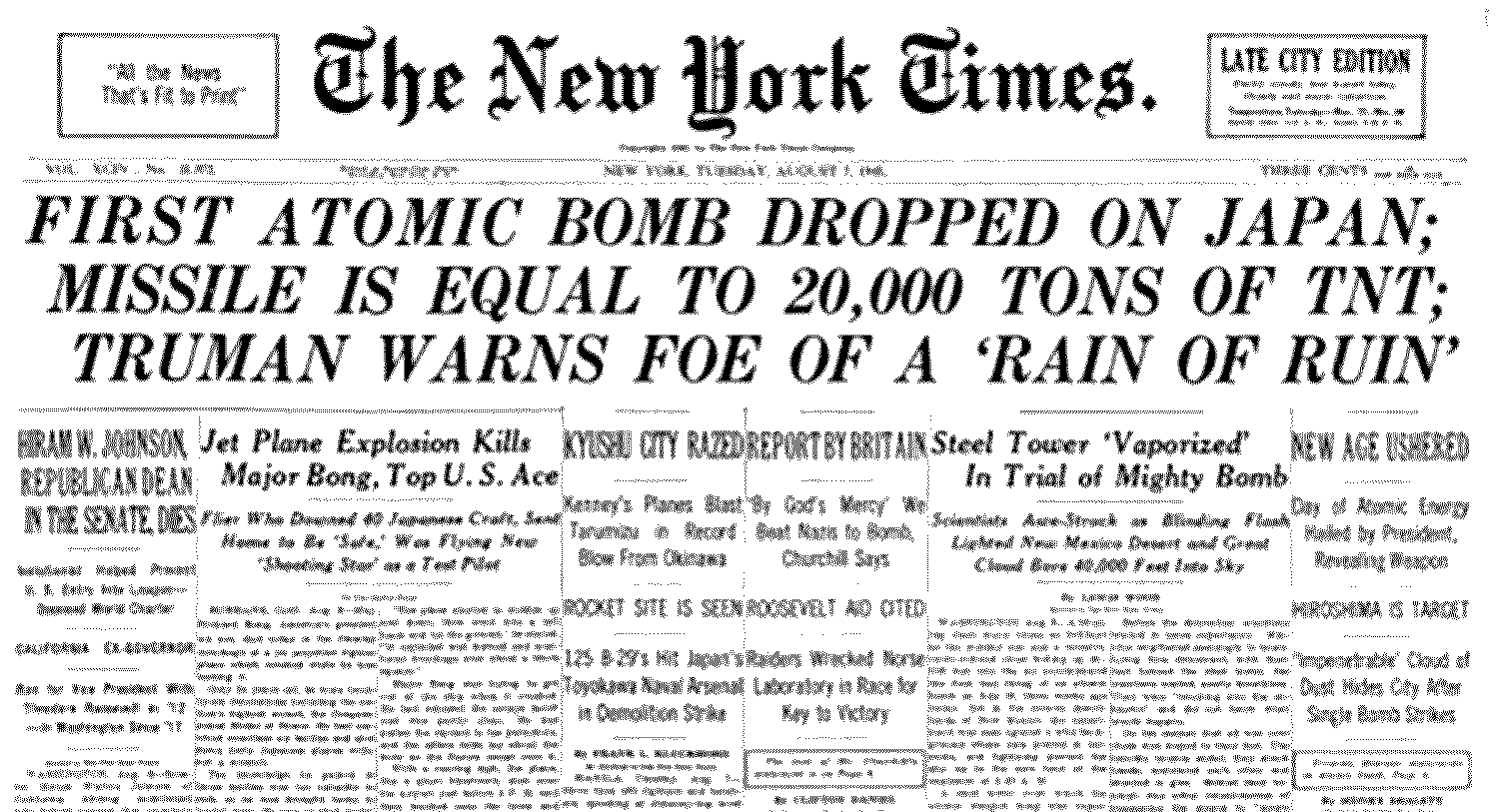
August 11, 1945
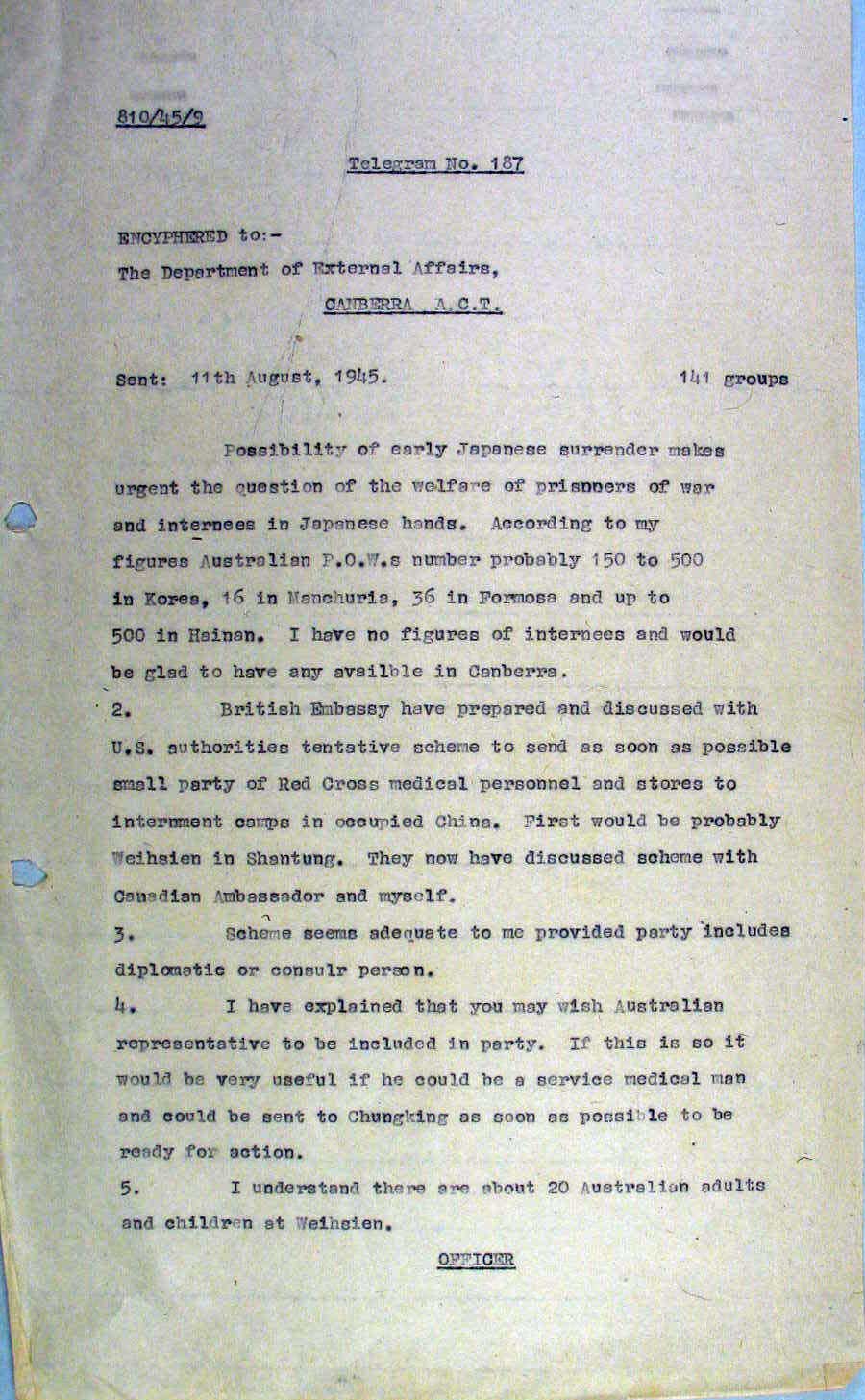
810/45/9
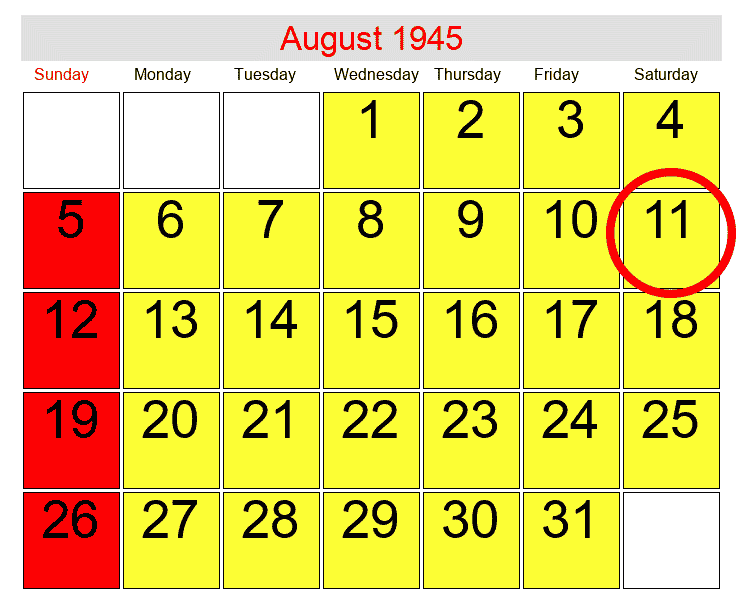 Telegram No. 187
Telegram No. 187
ENCYPHERED to: -
The Department of External Affairs,
CANBERA A.C.T.
Sent: 11th August, 1945.
141 groups.
Possibility of early Japanese surrender makes urgent the question of the welfare, of prisoners of war and internees in Japanese hands. According to my figures Australian P.0.W.s number probably 150 to 500 in Korea, 16 in Manchuria, 36 in Formosa and up to 500 in Hainan. I have no figures of internees and would be glad to have any available in Canberra.
2.
British Embassy have prepared and discussed with U.S. authorities tentative scheme to send as soon as possible small party of Red Cross medical personnel and stores to internment camps in occupied China. First would be probably Weihsien in Shantung. They now have discussed scheme with Canadian Ambassador and myself.
3 .
Scheme seems adequate to me provided party includes diplomatic or consular person.
4.
I have explained that you may wish Australian representative to be included in party. If this is so it would be very useful if he could be a service medical man and could be sent to Chungking as soon as possible to be ready for action.
5.
I understand there are about 20 Australian adults and children at Weihsien.
OFFICER

August 13, 1945
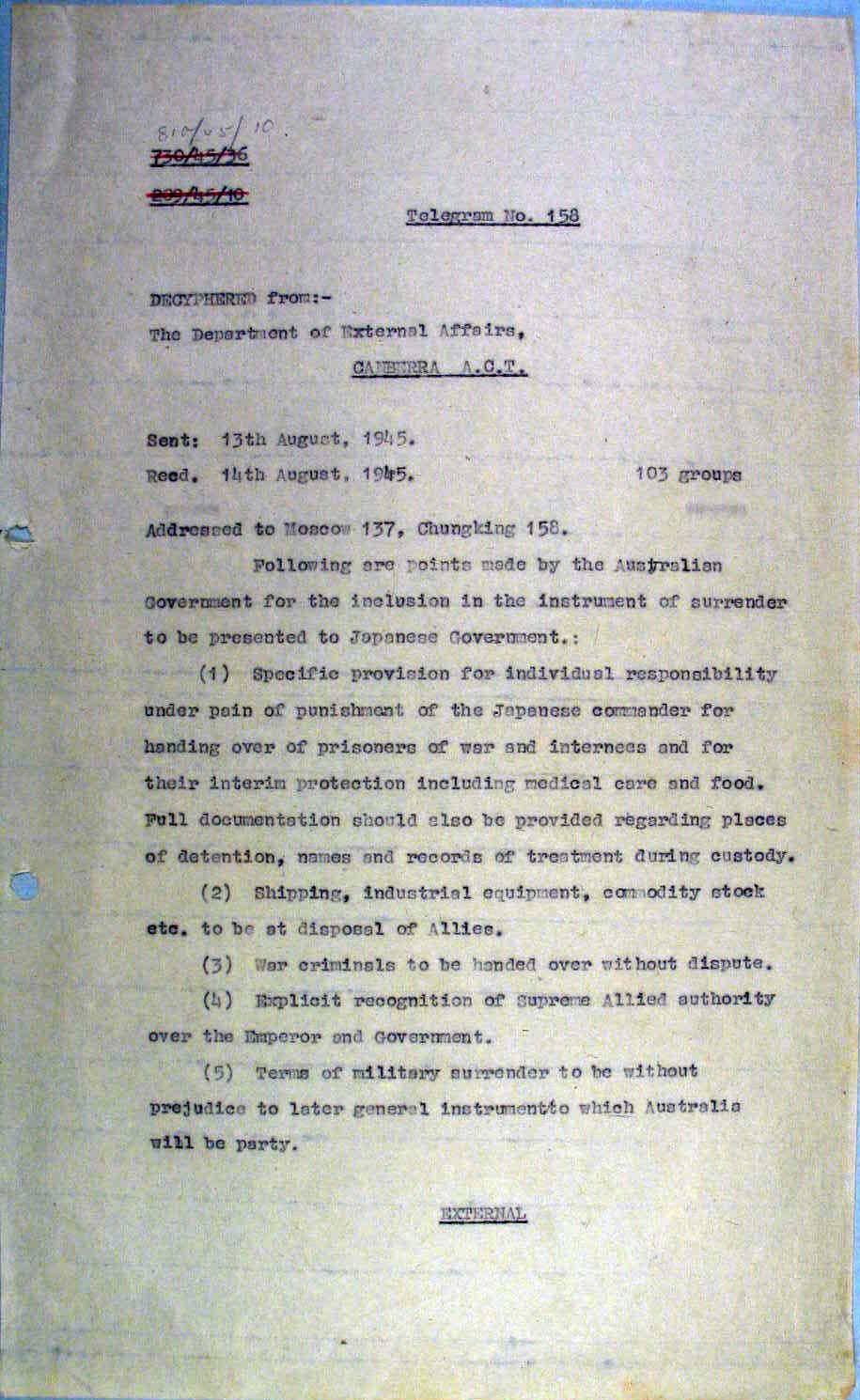
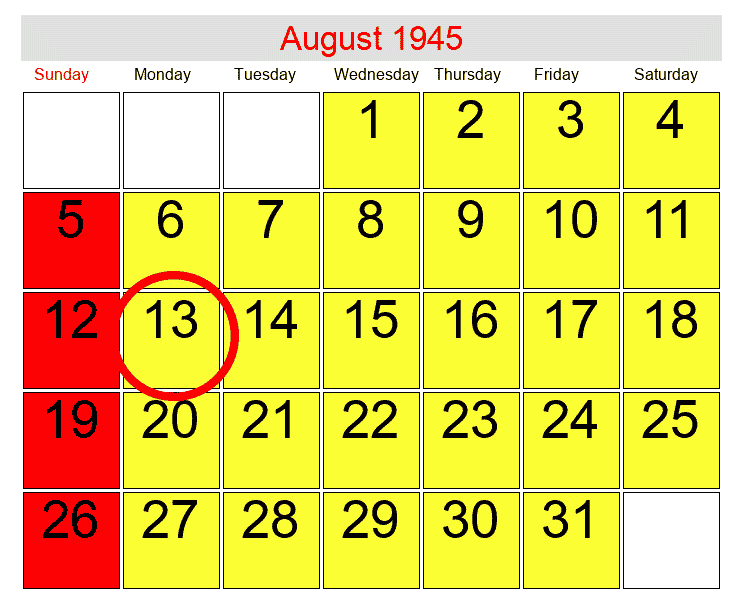
Telegram No. 158
DECYPHERED from:—
The Department of External Affairs,
CANBERA A.C.T.
Sent: 13th August, 1945
Read. 14th August, 1945.
103 groups
Addressed to Moscow 137, Chungking 158.
Following are points made by the Australian Government for the inclusion in the instrument of surrender to be presented to Japanese Government:
(1)
Specific provision for individual responsibility under pain of punishment of the Japanese commander for handing over of prisoners of war and internees end for their interim protection including medical care and food. Fu11 documentation should also be provided regarding places of detention, names and records of treatment during custody.
(2)
Shipping, industrial equipment, commodity stock etc. to be at disposal of Allies.
(3)
War criminals to be handed over without dispute.
(4)
Explicit recognition of Supreme Allied authority over the Emperor and Government.
(5)
Terms of military surrender to be without prejudice to later general instrument which Australia wi11 be party.
EXTERNAL
August 15, 1945 ...
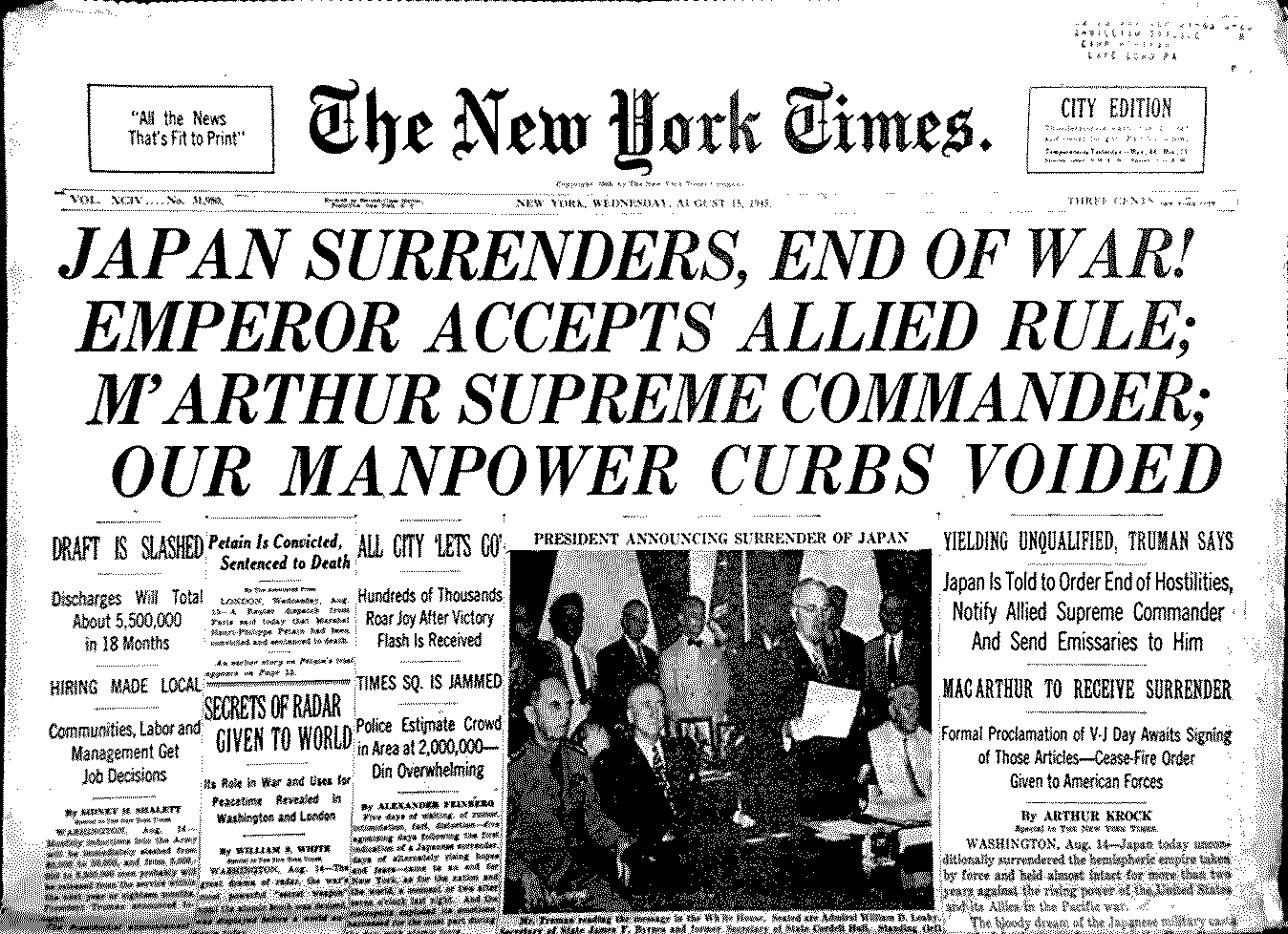
August 16, 1945
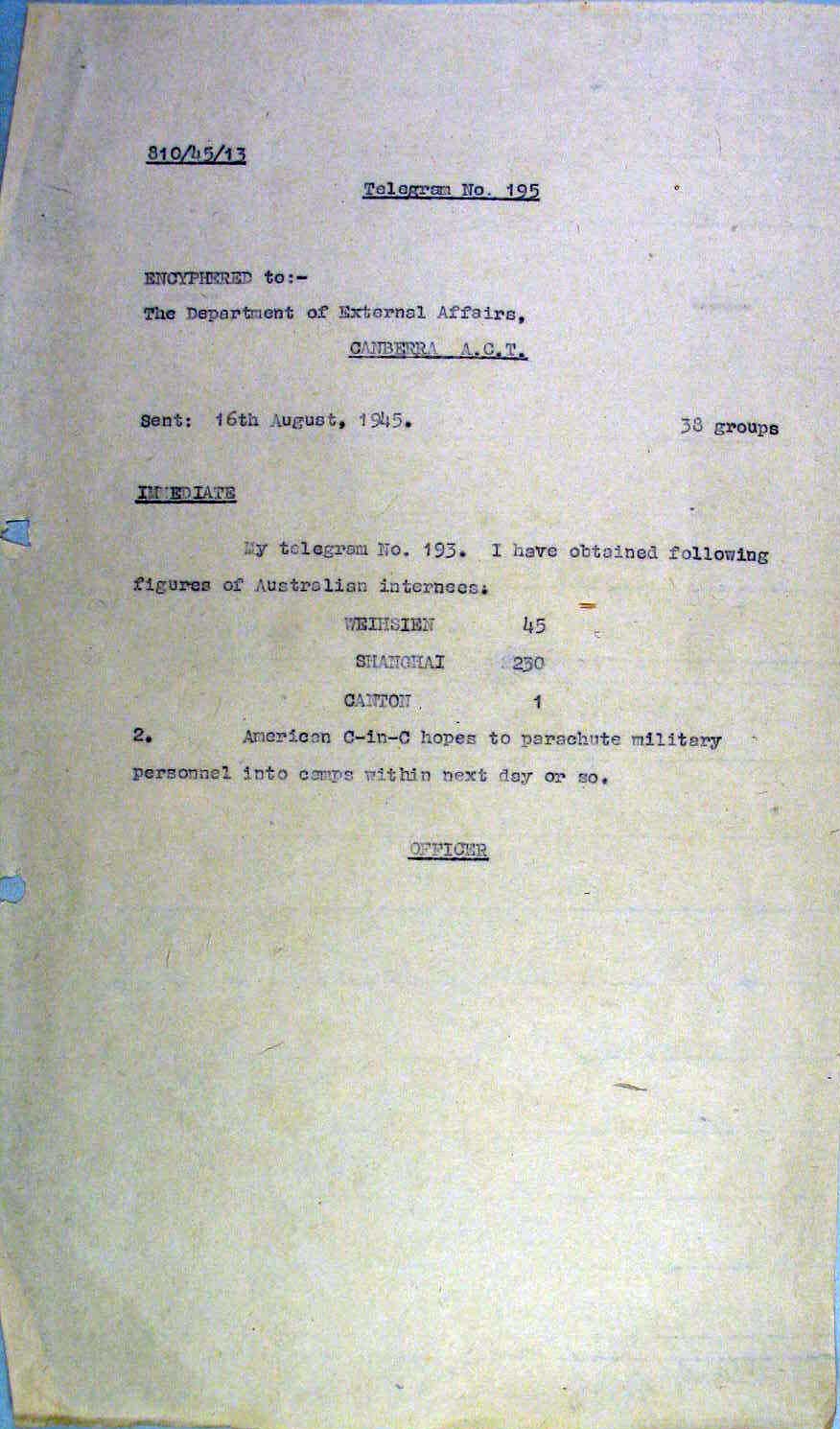
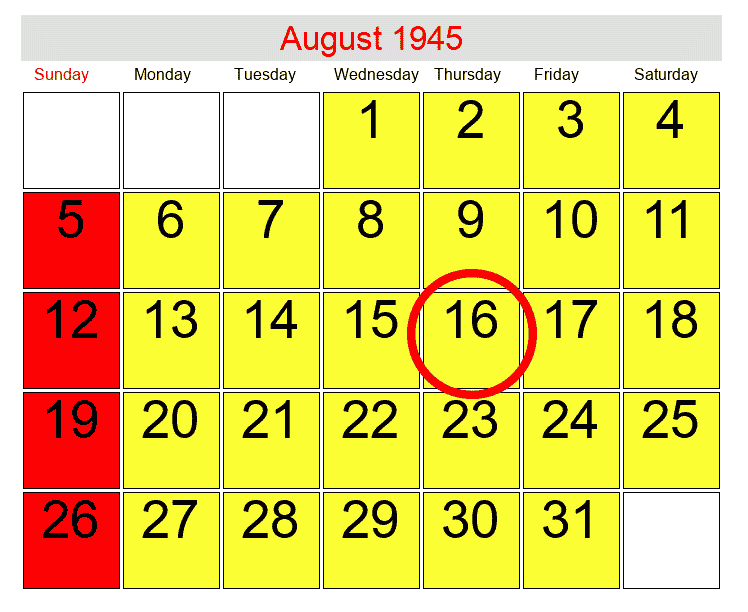
810/45/13
Telegram No. 195
ENCYPHERED to:-
The Department of External Affairs,
CANBERA A.C.T.
Sent: 16th August, 1945. 38 groups
IMMEDIATE
My telegram No. 193. I have obtained following figures of Australian internees:
WEIHSIEN 45
SHANGHAI 250
CANTON 1
2.
American C-in-C hopes to parachute military personnel into camps within next day or so.
OFFICER
August 19, 1945
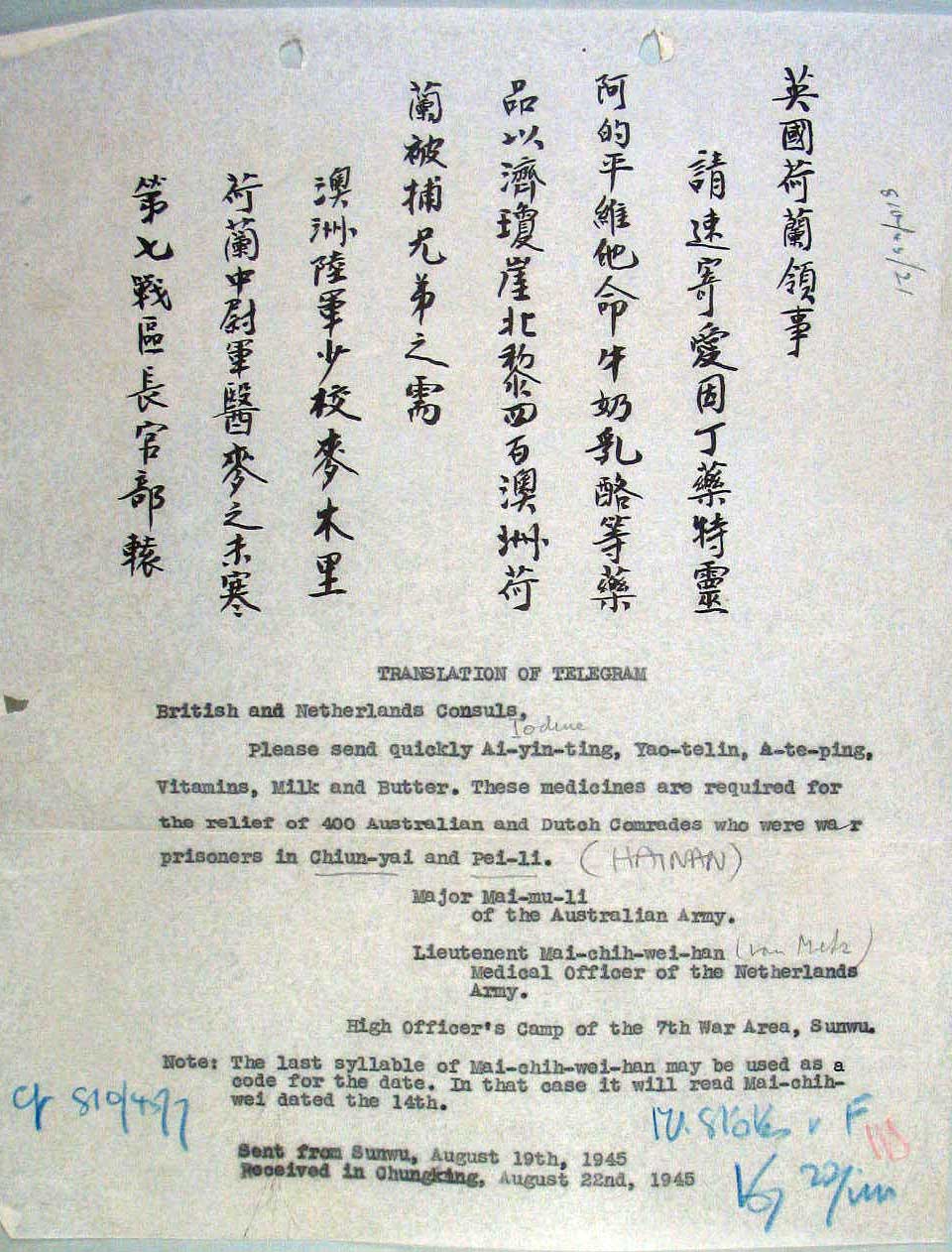
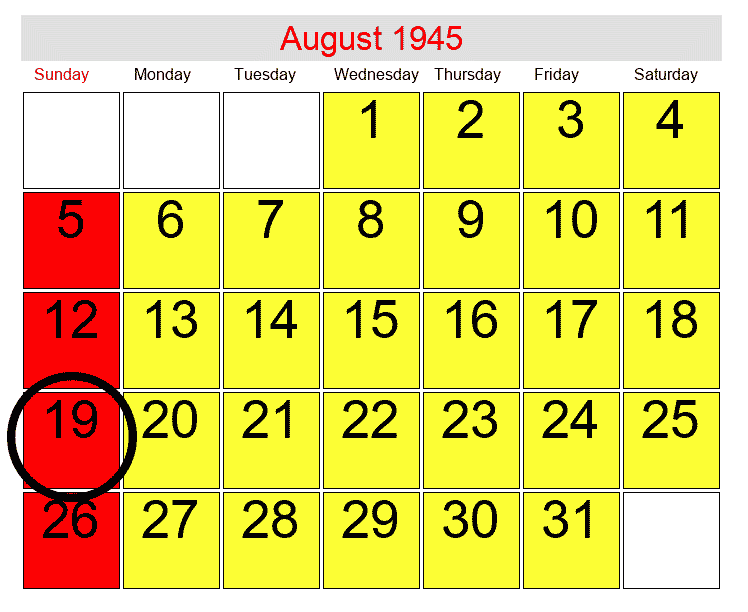
TRANSLATION OF TELEGRAM
British and Netherlands Consuls,
Please send quickly Ai-yin-ting [Iodure], Yao-telin, A-te-ping, Vitamins, Milk and Butter. These medicines are required for the relief of 400 Australian and Dutch Comrades who were war prisoners in Chiun-yai and Pei-li. [Hainan]
Major Mai-mu-li
Of the Australian Army.
Lieutenant Mai-chih-wei-han [Van Metz(?)]
Medical officer of the Netherlands Army.
High Officer's Camp of the 7th War Area, Sunwu.
Note:
The last syllable of Mai-chih-wei-han may be used as a code for the date. In that case it will read Mai-chih-wei dated the 14th.
Sent from Sunwu, August 19th, 1945
Received in Chungking, August 22nd, 1945.
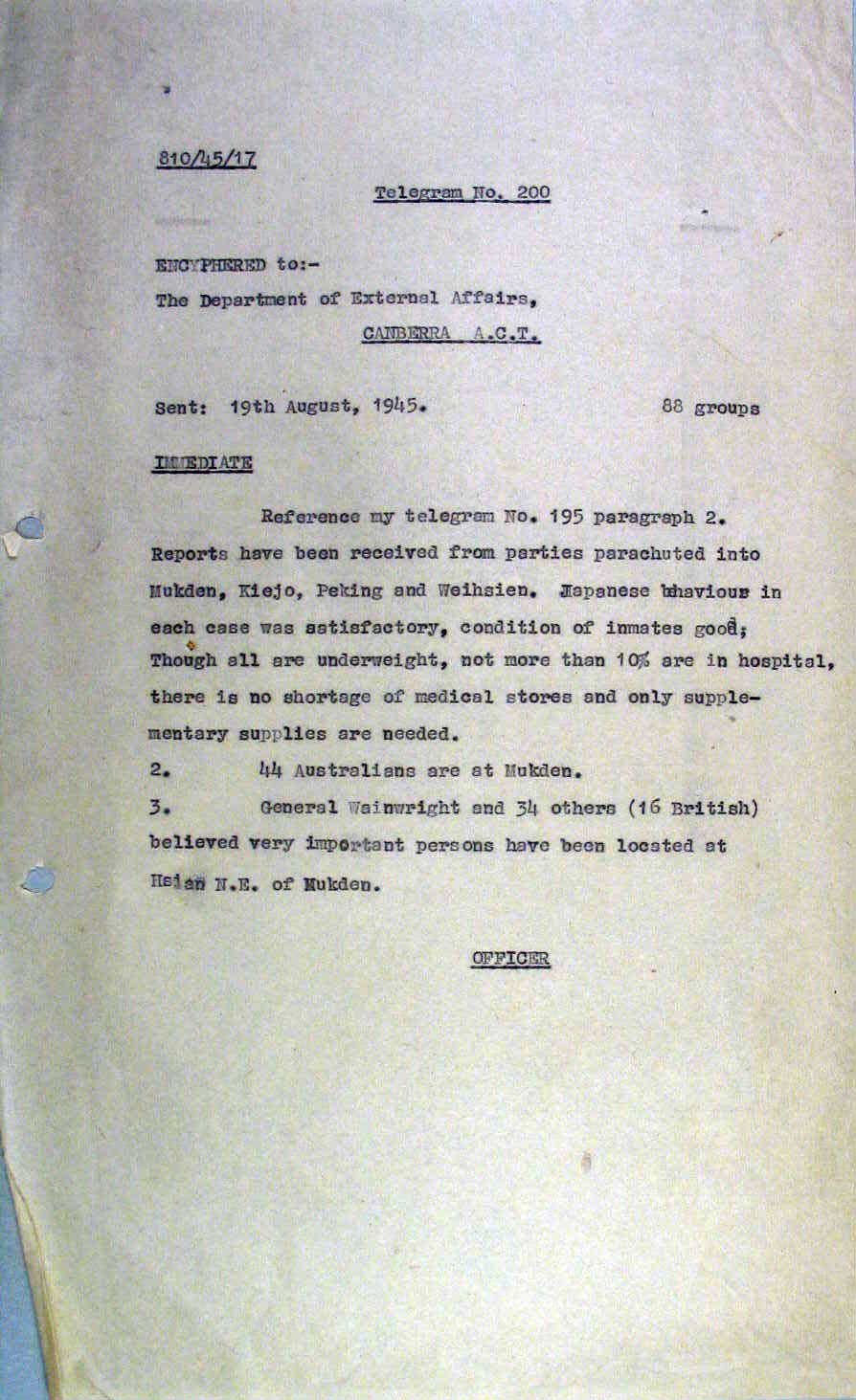
810/45/17
Telegram No. 200
ENCYPHERED to:-
The Department of External Affairs,
CANBERRA A.C.T.
Sent: 19th August 1945.
88 groups
IMMEDIATE
Reference my telegram No. 195 Paragraph 2.
Reports have been received from parties parachuted into Mukden, Kiejo, Peking and Weihsien. Japanese bevaviour in each case was satisfactory, condition of inmates good;
Though all ere underweight, not more than 10% are in hospital, there is no shortage of medical stores and only supplementary supplies are needed.
2.
44 Australians are at Mukden.
3.
General Wainwright and 34 others (16 British)
believed very important persons have been located at Hsian N.E. of Mukden.
OFFICER
August 21, 1945
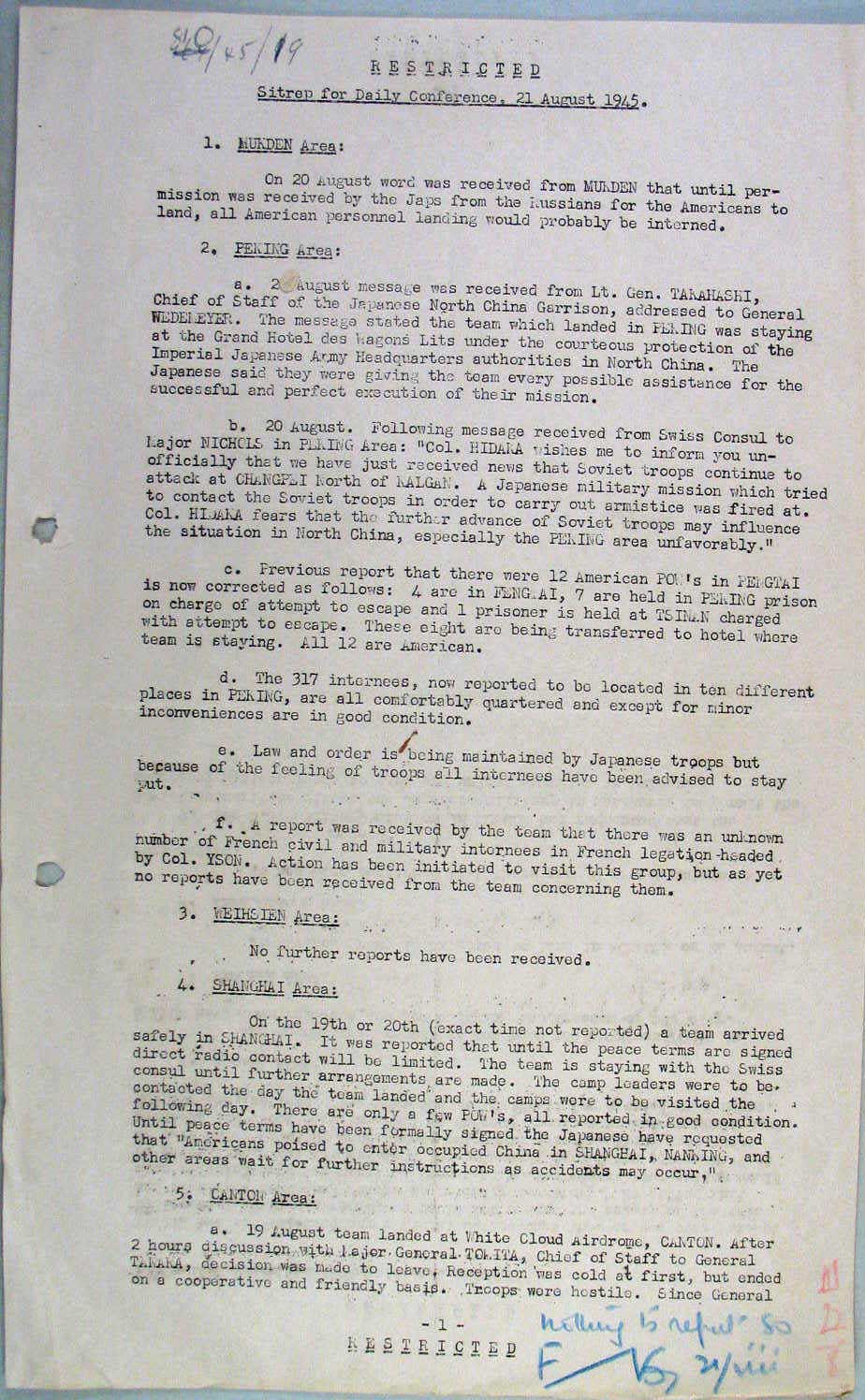
RESTRICTED
Sitrep for Daily Conference, 21 August 1945.
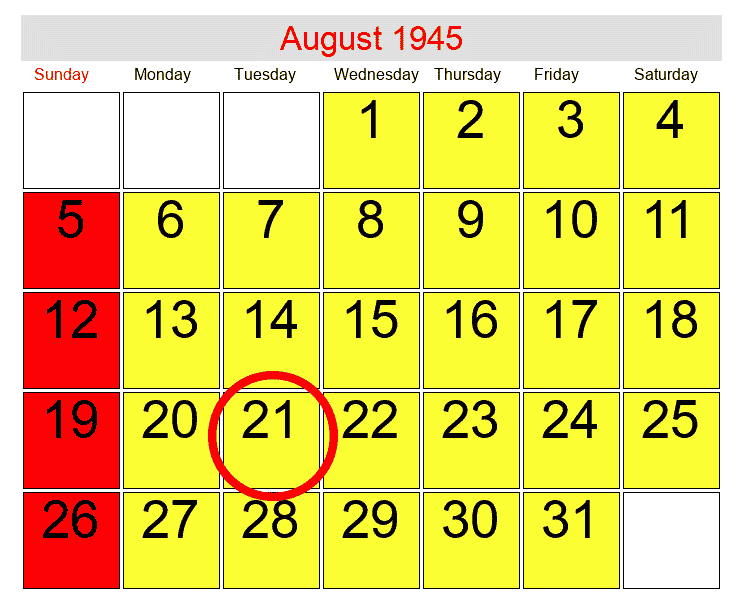 1.
1.
MUKDEN Area:
On 20 August word was received from MUKDEN that until permission was received by the Japs from the Russians for the Americans to land, all American personnel landing would probably be interned.
2.
PEKING Area:
a.
21 August: message was received from Lt. Gen. TAKAHASHI, Chief of Staff of the Japanese North China Garrison, addressed to General WEDEMEYER.
The message stated the team which landed in PEKING was staying at the Grand Hotel des Wagons Lits under the courteous protection of the Imperial Japanese Army Headquarters authorities in North China. The Japanese said they were giving the team every possible assistance for the successful and perfect execution of their mission.
b.
20 August: Following message received from Swiss Consul to Major NICHOLS in PEKING Area: "Col. HIDAKA wishes me to inform you unofficially that se have just received news that Soviet troops continue to attack at CHANGPEI North of KALGAN. A Japanese military mission which tried to contact the Soviet troops in order to carry out armistice was fired at. Col. HIDAKA fears that the further advance of Soviet troops may influence the situation in North China, especially the PEKING area unfavorably.”
c.
Previous report that there were 12 American POWs in PENGTAI is now corrected as follows: 4 are in FENGTAI, 7 are held in PEKING prison on charge of attempt to escape and 1 prisoner is held at TSINAN charged with attempt to escape. These eight are being transferred to hotel where team is staying. All 12 are American.
d.
The 317 internees, now reported to be located in ten different places in PEKING, are all comfortably quartered and except for minor inconveniences are in good condition.
e.
Law and order is being maintained by Japanese troops but because of the feeling of troops all internees have been advised to stay put.
f.
A report was received by the team that there was an unknown number of French civil and military internees in French legation - headed by Col. YSON. Action has been initiated to visit this group, but as yet no reports have been received from the teams concerning them.
3.
WEIHSIEN Area:
No further reports have been received.
4.
SHANGHAI Area:
On the 19th or 20th (exact time not reported) a team arrived safely in SHANGHAI. It was reported that until the peace terms are signed direct radio contact will be limited. The team is staying with the Swiss consul until further arrangements are made. The camp leaders were to be, contacted the day the team landed and the camps were to be visited the following day. There are only a few POWs, all reported in good condition. Until peace terms have been formally signed. the Japanese have requested that "Americans poised to enter occupied China in SHANGHAI, NANKING, and other areas wait for further instructions as accidents may occur."
5:
CANTON Area :
a.
19 August: team landed at White Cloud Airdrome, CANTON. After 2 hours discussion with Major General TOHITA, Chief of Staff to General TANAKA, decision was made to leave. Reception was cold at first, but ended on a cooperative and friendly basis. Troops were hostile. Since General …
RESTRICTED

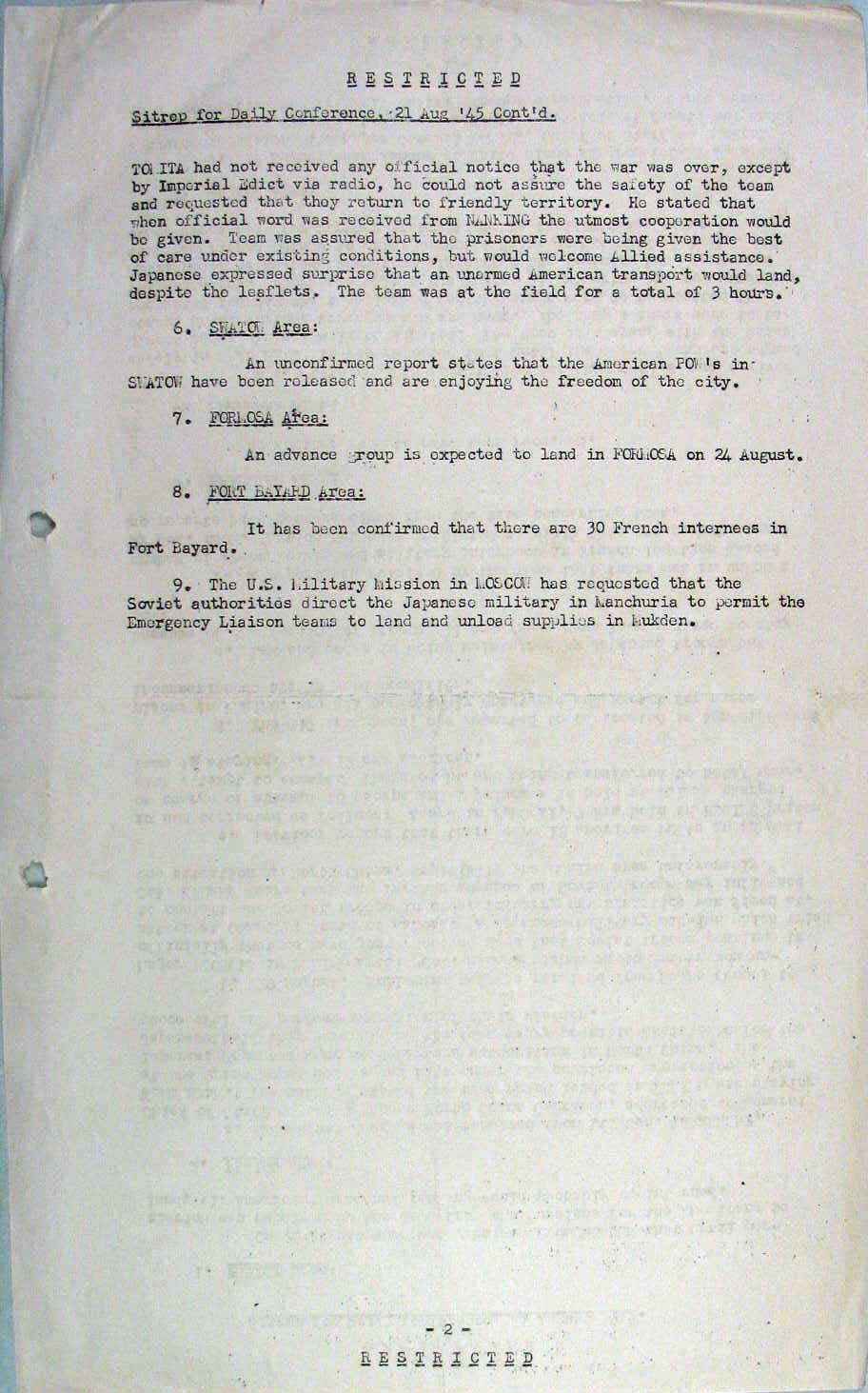
RESTRICTED
Sitrep for Daily Conference, 21 Aug '45 Cont'd.
TOKITA had not received any official notice that the war was over, except by Imperial Edict via radio, he could not assure the safety of the team and requested that they return to friendly territory. He stated that when official word was received from NANKING the utmost cooperation would be given. Team was assured that the prisoners more being given the best of care under existing conditions, but would welcome Allied assistance. Japanese expressed surprise that an unarmed American transport would land, despite the leaflets. The team was at the field for a total of 3 hours.
6.
SWATOW Area:
An unconfirmed report states that the American POW's in SWATOW have been released and are enjoying the freedom of the city.
7.
FORMOSA Area:
An advance group is expected to land in FORMOSA on 24 August.
8.
FORT BAYARD Area:
It has been confirmed that there are 30 French internees in Fort Bayard.
9.
The U.S. Military Mission in MOSCOW has requested that the Soviet authorities direct the Japanese military in Manchuria to permit the Emergency Liaison teams to land and unload supplies in Mukden.
RESTRICTED
August 22, 1945
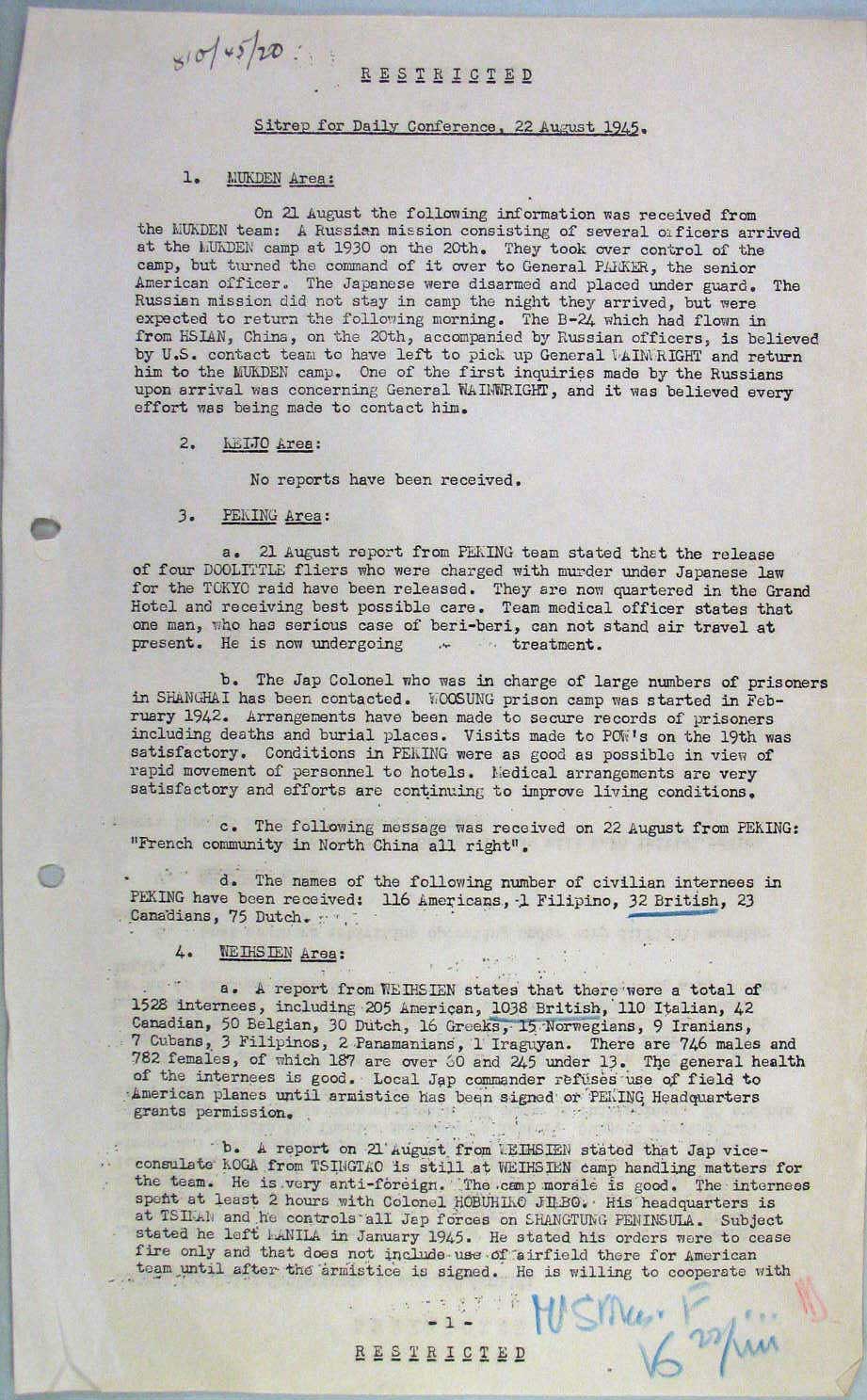
RESTRICTED
Sitrep for Daily Conference, 22 August 1945.
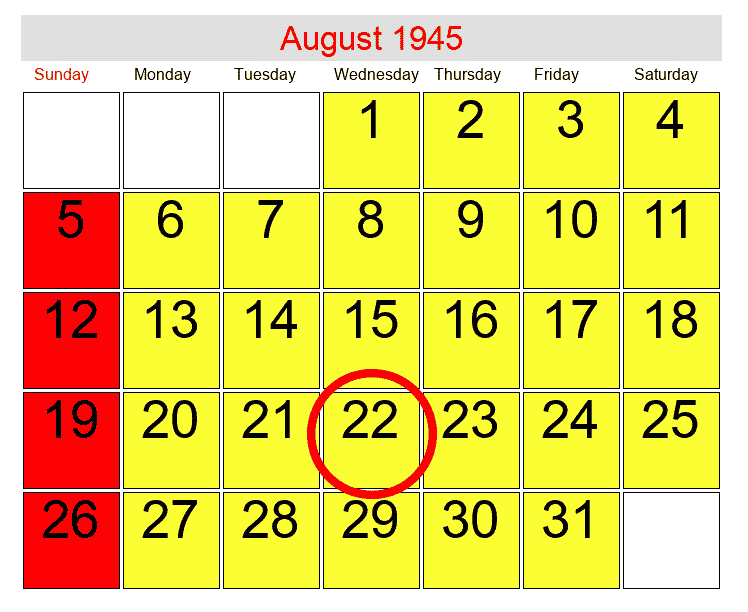 1.
1.
MUKDEN Area:
On 21 August the following information was received from the MUKDEN team:
A Russian mission consisting of several officers arrived at the MUKDEN camp at 19:30 on the 20th. They took over control of the camp, but turned the command of it over to General PARKER., the senior American officer. The Japanese were disarmed and placed under guard. The Russian mission did not stay in camp the night they arrived, but were expected to return the following morning. The B-24 which had flown in from HSIAN, China, on the 20th, accompanied by Russian officers, is believed by U.S. contact team to have left to pick up General WAINWRIGHT and return him to the MUKDEN camp. One of the first inquiries made by the Russians upon arrival has concerning General WAINWRIGHT, and it was believed every effort was being made to contact him.
2.
KEIJO Area:
No reports have been received.
3.
PEKING Area:
a.
21 August report from PEKING team stated that the release of four DOOLITTLE fliers who were charged with murder under Japanese law for the TOKYO raid have been released. They are now quartered in the Grand Hotel and receiving best possible care. Team medical officer states that one man, who has serious case of beriberi, cannot stand air travel at present. He is now undergoing treatment.
b.
The Jap Colonel who was in charge of large numbers of prisoners in SHANGHAI has been contacted. WOOSUNG prison camp was started in February 1942. Arrangements have been made to secure records of prisoners including deaths and burial places. Visits made to POW 's on the 19th was satisfactory. Conditions in PEKING were as good as possible in view of rapid movement of personnel to hotels. Medical arrangements are very satisfactory and efforts are continuing to improve living conditions.
c.
The following message was received on 22 August from PEKING:
"French community in North China all right".
d.
The names of the following number of civilian internees in PEKING have been received: 116 Americans, 1 Filipino, 32 British, 23 Canadians, 75 Dutch.
4.
WEIHSIEN Area:
a.
A report from WEIHSIEN states that there were a total of 1528 internees, including 205 American, 1038 British, 110 Italian, 42 Canadian, 50 Belgian, 30 Dutch, 16 Greeks, 15 Norwegians, 9 Iranians, 7 Cubans, 3 Filipinos, 2 Panamanians, 1 Uruguayan. There are 746 males and 782 females, of which 187 are over 60 and 245 under 13. The general health of the internees is good. Local Jap commander refuses use of field to American planes until armistice has been signed or PEKING Headquarters grants permission.
b.
A report on 21' August from WEIHSIEN stated that Jap vice-consulate KOGA from TSINGTAO is still at WEIHSIEN camp handling matters for the team. He is very anti-foreign. The camp morale is good. The internees spent at least 2 hours with Colonel HOBUHIKO JILBO. His headquarters is at TSINAN and he controls all Jap forces on SHANTUNG PENINSULA. Subject stated he left MANILA in January 1945. He stated his orders were to cease fire only and that data not include use of airfield there for American team until after the armistice is signed. He is willing to cooperate with ...
RESTRICTED

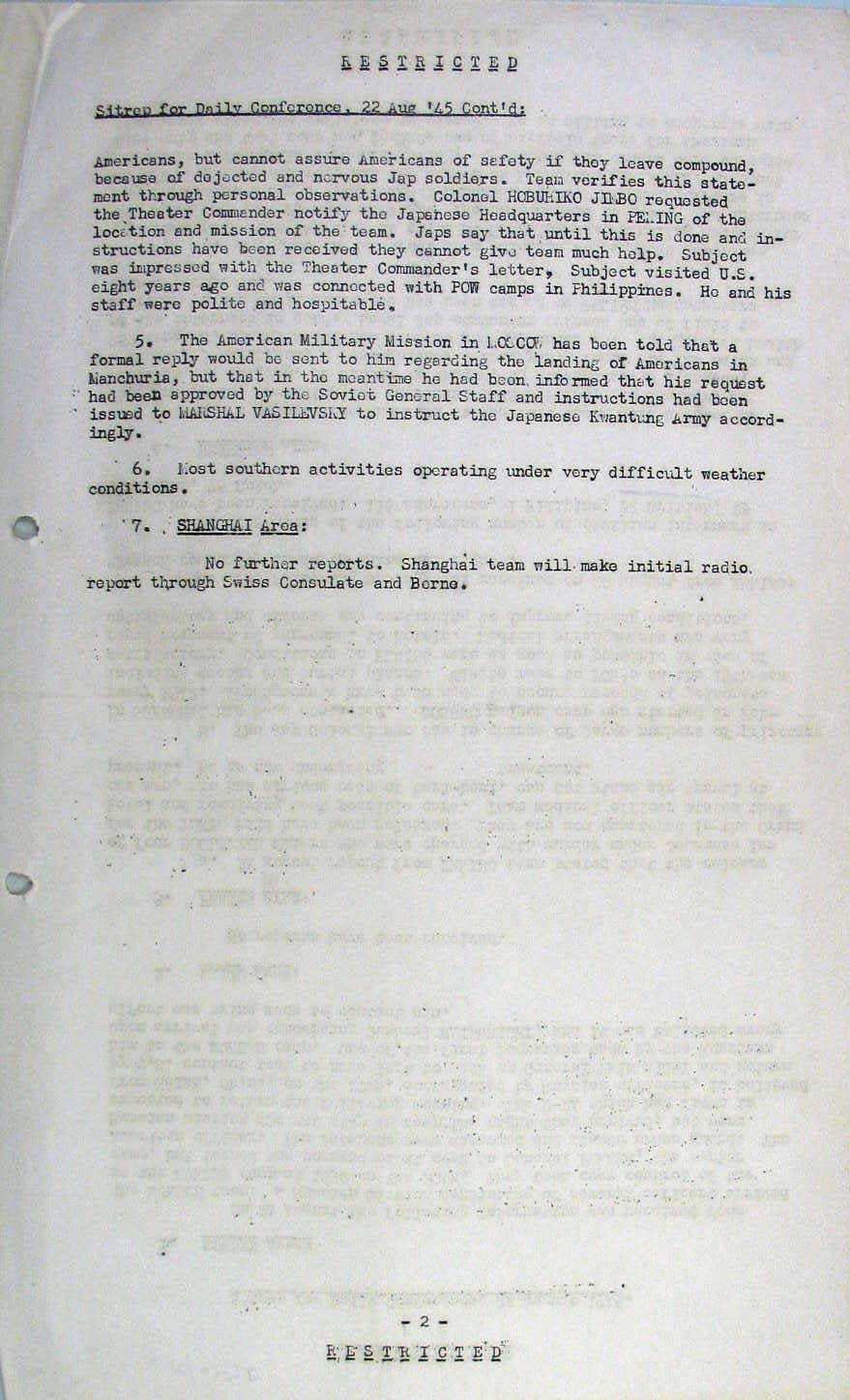
RESTRICTED
Sitrep for Daily Conference. 22 Aug '45 Cont'd:
Americans, but cannot assure Americans of safety if they leave compound, because of dejected and nervous Jap soldiers. Team verifies this statement through personal observations. Colonel HOBUHIKO JIMBO requested the Theater Commander notify the Japanese Headquarters in PEKING of the location and mission of the team. Japs say that until this is done and instructions have been received they cannot give team much help. Subject was impressed with the Theater Commander's letter; Subject visited U.S. eight years ago and was connected with POW camps in Philippines. Ho and his staff were polite and hospitable.
5.
The American Military Mission in MOSCOW, has been told that a formal reply would be sent to him regarding the landing of Americans in Manchuria, but that in the meantime he had been informed that his request had been approved by the Soviet General Staff and instructions had been issued to MARSHAL VASILEVSKY to instruct the Japanese Kwantung Army accordingly.
6.
Most southern activities operating under very difficult weather conditions.
7.
SHANGHAI Area:
No further reports. Shanghai team sill make initial radio report through Swiss Consulate and Berne.
RESTRICTED
August 23, 1945
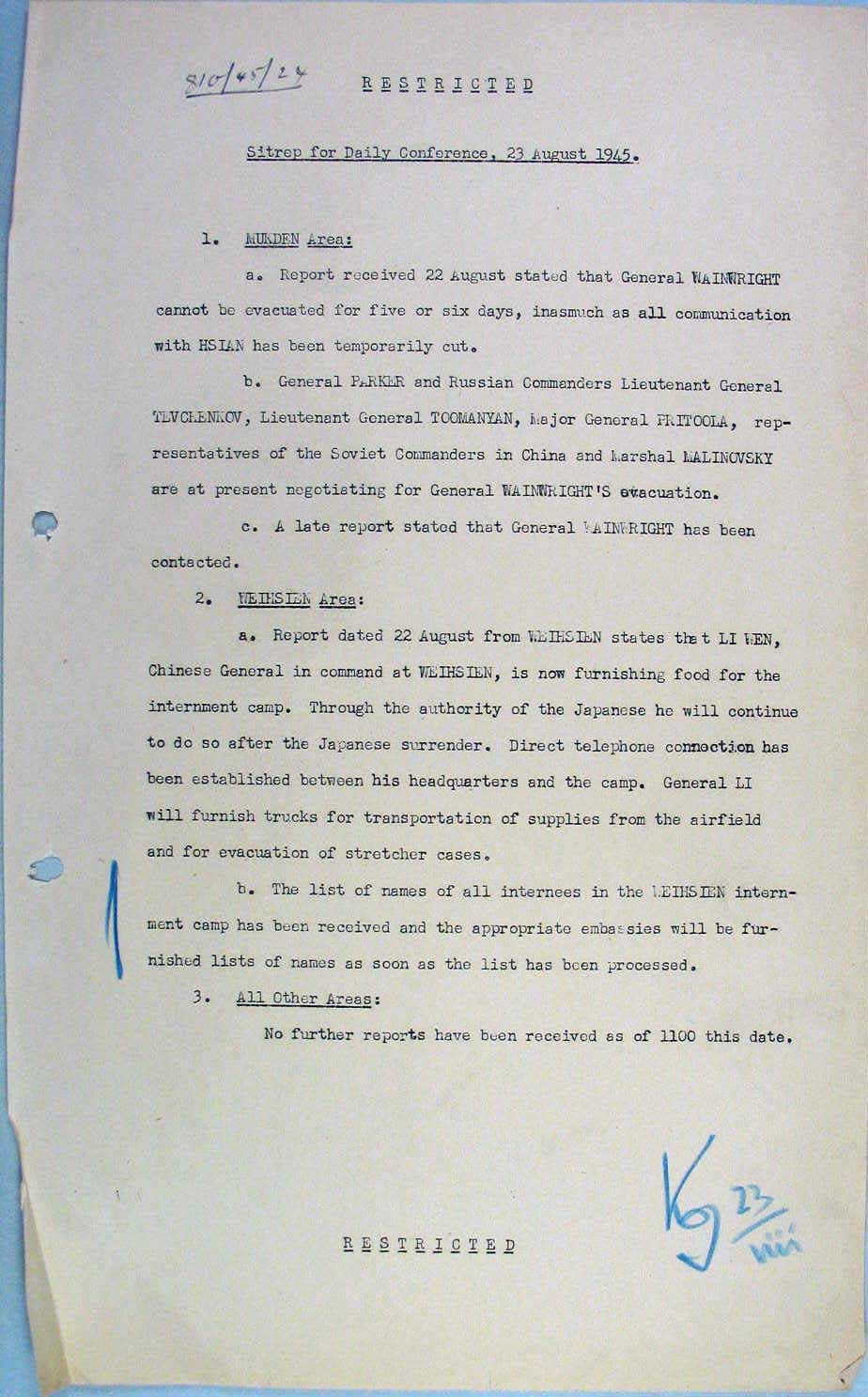
RESTRICTED
Sitrep for Daily Conference, 23 August 1945.
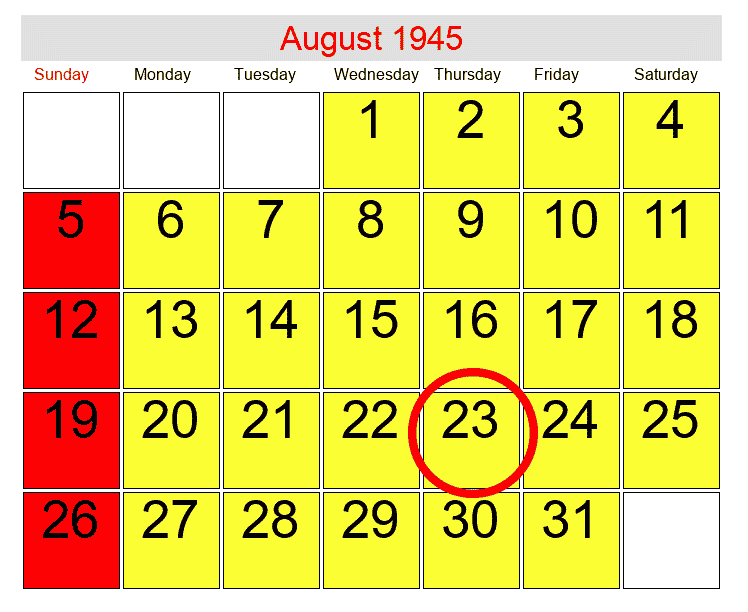 1.
1.
MUKDEN Area:
a.
Report received 22 August stated that General WAINWRIGHT cannot be evacuated for five or six days, inasmuch as all communication with HSIAN has been temporarily cut.
b.
General PARKER and Russian Commanders Lieutenant General TEVCHENKOV, Lieutenant General TOOMANYAN, major General PRITOOLA, representatives of the Soviet Commanders in China and Marshal MALINOVSKY are at present negotiating for General WAINWRIGHT'S evacuation.
c. A late report stated that General WAIWRIGHT has been contacted.
2.
WEIHSIEN Area,
a.
Report dated 22 August from WEIHSIEN states that LI WEN, Chinese General in command at WEIHSIEN, is now furnishing food for the internment camp. Through the authority of the Japanese he will continue to do so after the Japanese surrender. Direct telephone connection has been established between his headquarters and the camp. General LI will furnish trucks for transportation of supplies from the airfield and for evacuation of stretcher cases.
b.
The list of names of all internees in the WEIHSIEN internment camp has been received and the appropriate embassies will be furnished lists of names as soon as the list has been processed.
3.
All Other Areas:
No further reports have been received as of 11:00 this date.
RESTRICTED

August 24, 1945
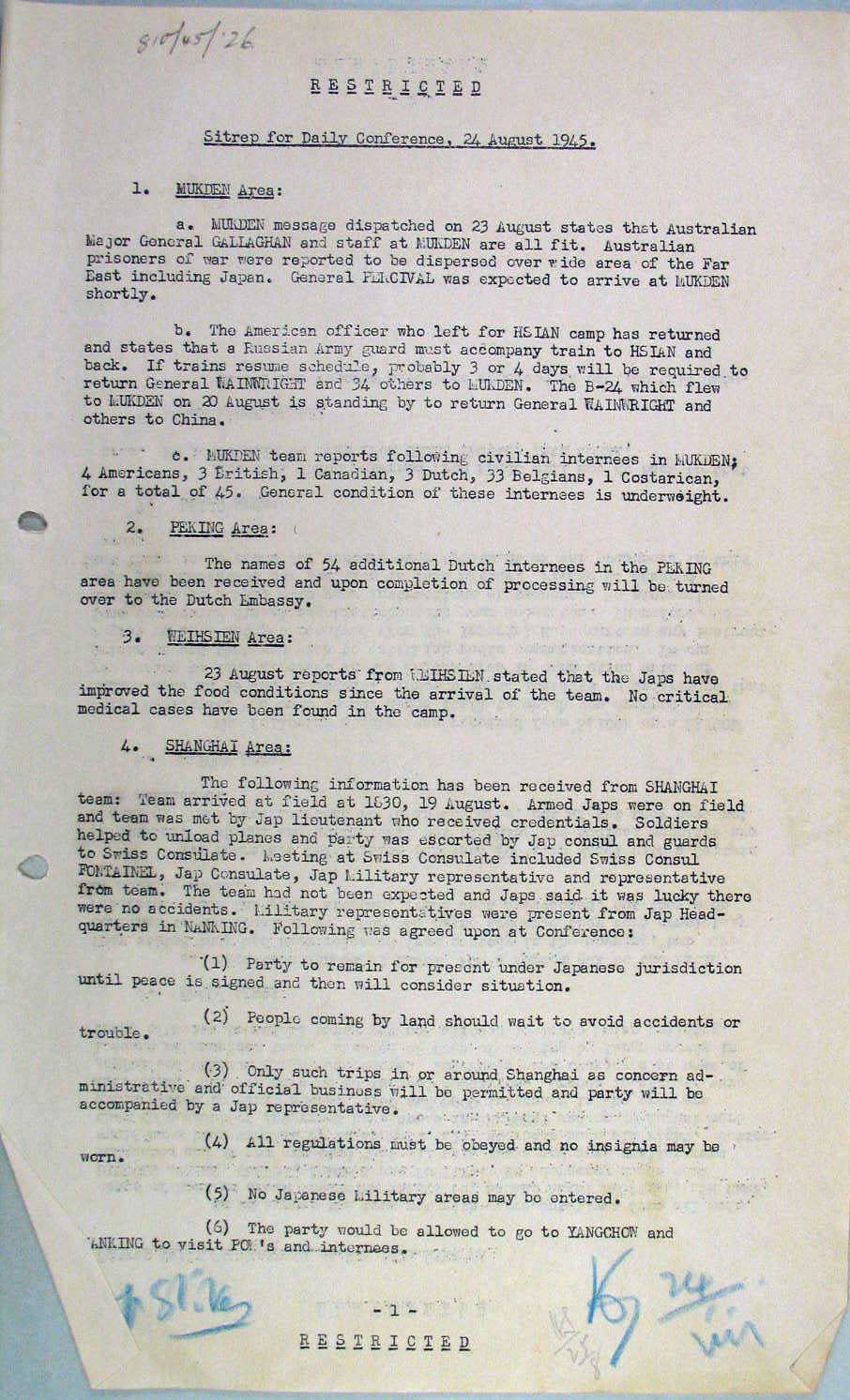
RESTRICTED
Sitrep for Daily Conference, 24 August 1945.
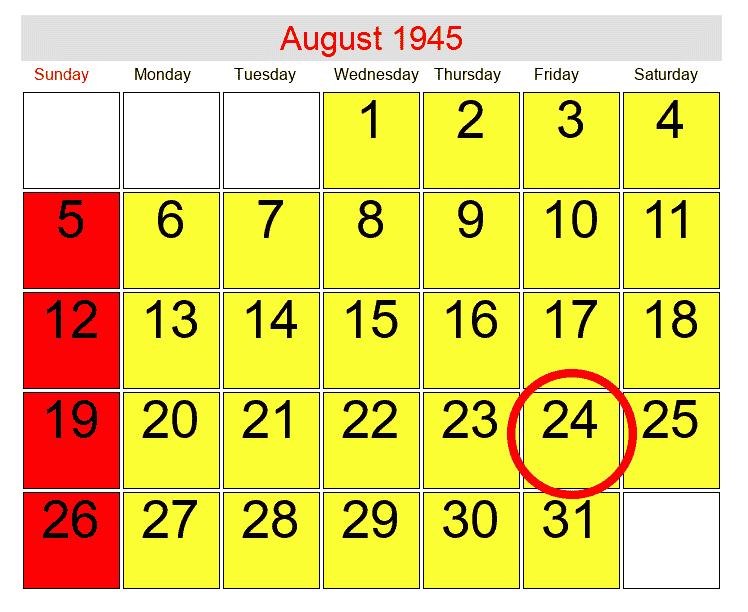 1.
1.
MUKDEN Area:
a.
MUKDEN message dispatched on 23 August states that Australian Major General GALLAGHAN and staff at MUKDEN are all fit. Australian prisoners of war were reported to be dispersed over wide area of the Far East including Japan. General PERCIVAL was expected to arrive at MUKDEN shortly.
b.
The American officer who left for HSIAN camp has returned and states that a Russian Army guard must accompany train to HSIAN and hack. If trains resume schedule, probably 3 or 4 days, will be required to return General WAINWRIGHT and 34 others to MUKDEN. The B-24 which flew to MUKDEN on 20 August is standing by to return General WAINWRIGHT and others to China.
c.
MUKDEN team reports following civilian internees in MUKDEN; 4 Americans, 3 British, 1 Canadian, 3 Dutch, 33 Belgians, 1 Costarican, for a total of 45. General condition of these internees is underweight.
2.
PEKING Area:
The names of 54 additional Dutch internees in the PEKING area have been received and upon completion of processing will be turned over to the Dutch Embassy.
3.
WEIHSIEN Area:
23 August reports from WEIHSIEN stated that the Japs have improved the food conditions since the arrival of the team. No critical medical cases have been found in the camp.
4.
SHANGHAI Area:
The following information has been received from SHANGHAI team: Team arrived at the field at 18:30, 19 August. Armed Japs were on the field and team were met by Jap lieutenant who received credentials. Soldiers helped to unload planes and Party was escorted by Jap consul and guards to Swiss Consulate. Meeting at Swiss Consulate included Swiss Consul FONTAINEL, Jap Consulate, Jap Military representative and representative from the team. The team had not been expected and Japs said it was lucky there were no accidents. Military representatives were present from Jap Headquarters in NANKING. Following was agreed upon at Conference:
(1)
Party to remain for present Under Japanese jurisdiction until peace is signed and then will consider the situation.
(2)
People coming by land should wait to avoid accidents or trouble.
(3)
Only such trips in or around Shanghai as concern administrative and official business will be permitted and party will be accompanied by a Jap representative.
(4)
All regulations must be obeyed and no insignia may be worn.
(5)
No Japanese Military areas may be entered.
(6)
The party would be allowed to go to YANGCHOW and NANKING to visit POWs and internees.
RESTRICTED

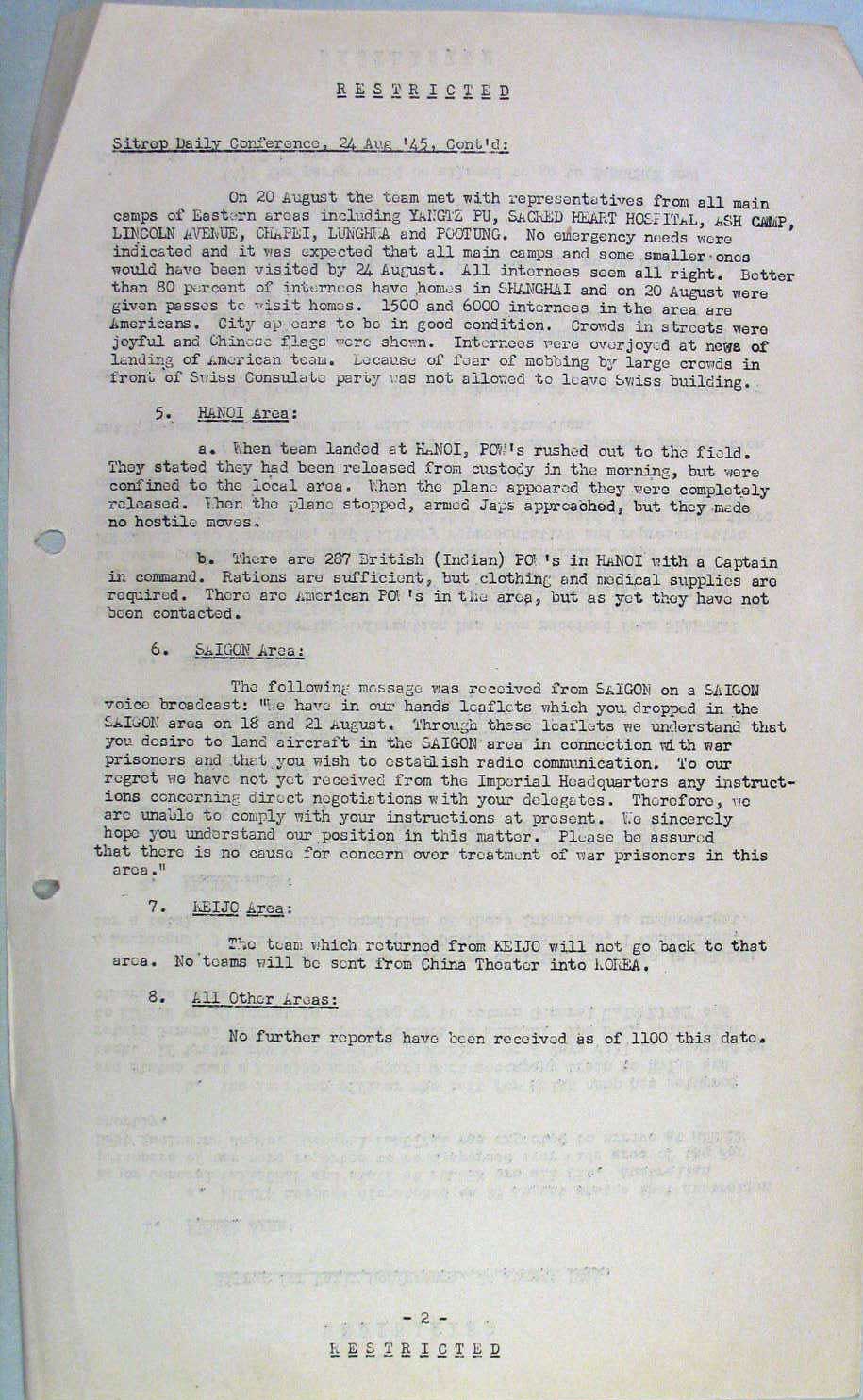
RESTRICTED
Sitrep Daily Conference 24Aug '45, Cont'd:
On 20 August the team met with representatives from all main camps of Eastern areas including YANGTZ PU, SACRED HEART HOSPITAL, ASH CAMP, LINCOLN AVENUE, CHAPEI, LUNGHUA and POOTUNG. No emergency needs were indicated and it was expected that all main camps and some smaller ones would have been visited by 24 August. All internees seem all right. Better than 80 percent of internees have homes in SHANGHAI and on 20 August were given passes to visit homes. 1500 and 6000 internees in the area are Americans. City appears to ho in good condition. Crowds in streets were joyful and Chinese flags were shown. Internees were overjoyed at news of landing of American team. Because of fear of mobbing by large crowds in front of Swiss Consulate party was not allowed to leave Swiss building.
5.
HANOI Area:
a.
When team landed at HANOI, POWs rushed out to the field.
They stated they had been released from custody in the morning, but were confined to the local area. When the plane appeared, they wore completely released. When the plane stopped, armed Japs approached, but they made no hostile moves.
b.
There are 287 British (Indian) POWs in HANOI with a Captain in command. Rations are sufficient, but clothing and medical supplies are required. There are American POWs in the area, but as yet they have not been contacted.
6.
SAIGON Area:
The following message vas received from SAIGON on a SAIGON voice broadcast: "We have in our hands leaflets which you dropped in the SAIGON area on 18 and 21 August. Through these leaflets we understand that you desire to land aircraft in the SAIGON area in connection with war prisoners and that you wish to establish radio communication. To our regret we have not yet received from the Imperial Headquarters any instructions concerning direct negotiations with your delegates. Therefore, we are unable to comply with your instructions at present. We sincerely hope you understand our position in this matter. Please be assured that there is no cause for concern over treatment of war prisoners in this area."
7.
KEIJO Area:
The team which returned from KEIJO will not go back to that area. No teams will be sent from China Theater into KOREA.
8.
All Other Areas:
No further reports have been received as of 11:00 this date.
RESTRICTED
August 25, 1945
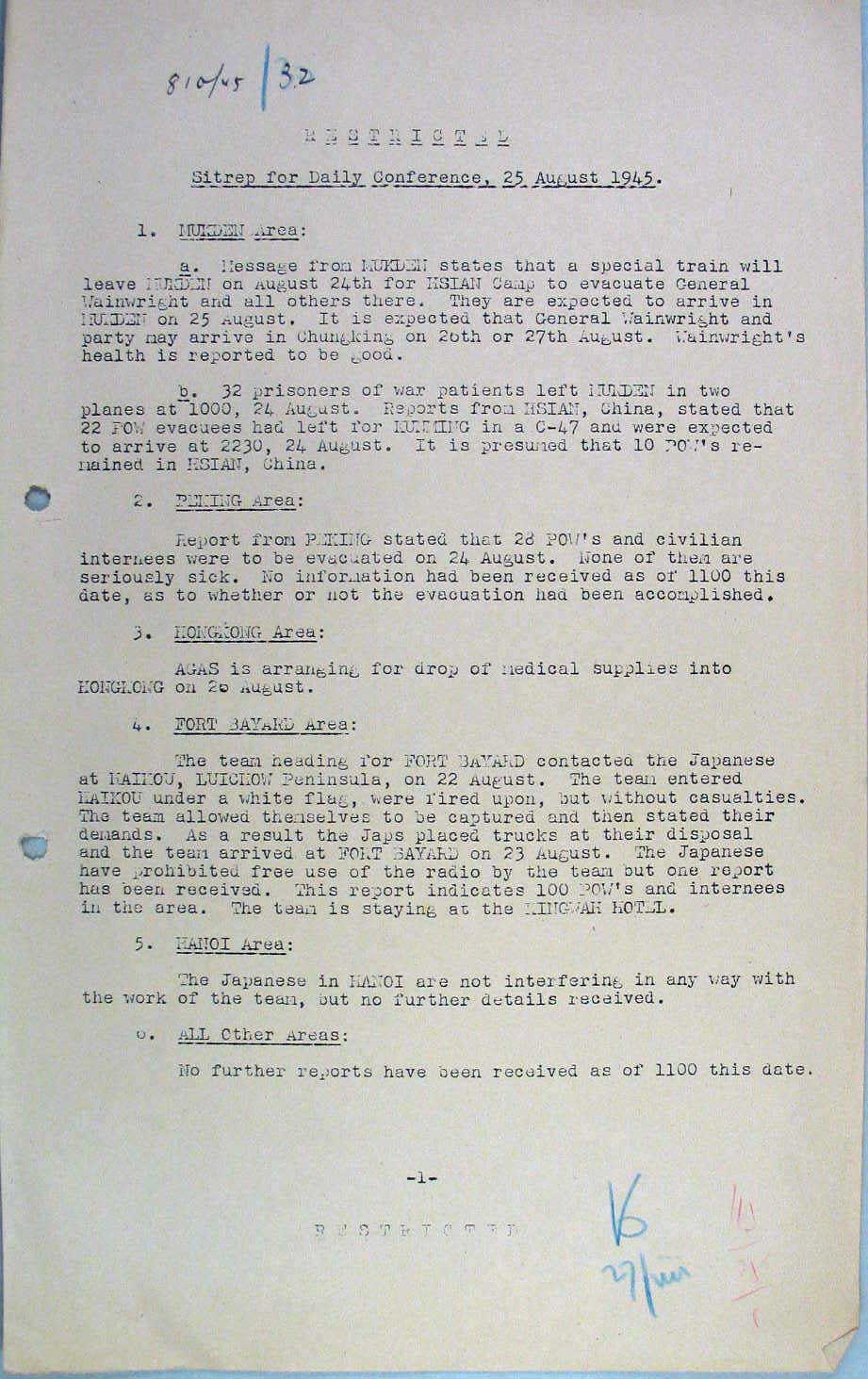
810/45/32
RESTRICTED
Sitrep for Daily Conference, 25 August 1945.
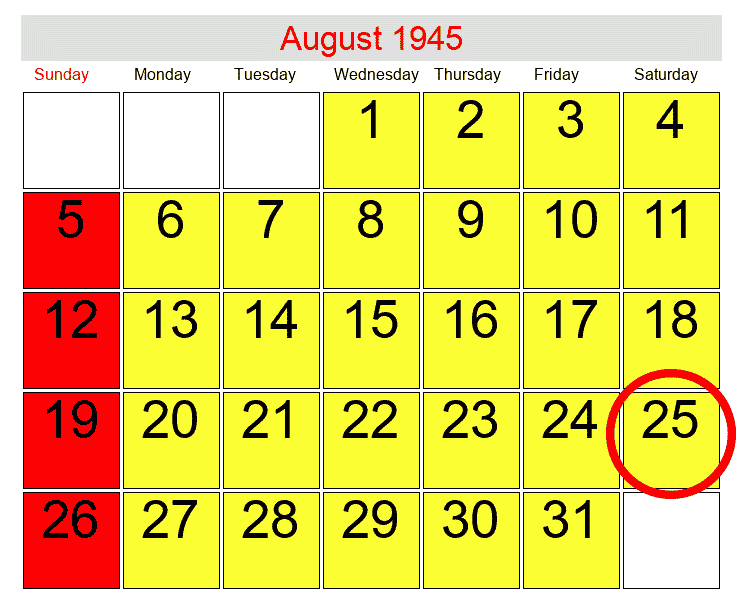 1.
1.
MUKDEN Area:
a.
Message from MUKDEN states that a special train will leave MUKDEN on August 24th for HSIAN camp to evacuate General Wainwright and all others there. They are expected to arrive in MUKDEN on 25 August. It is expected that General Wainwright and party may arrive in Chungking on 26th or 27th August. Wainwright's health is reported to be good.
b.
32 prisoners of war patients left MUKDEN in two planes at 10:00, 24 August. Reports from HSIAN, China, stated that 22 POW evacuees had left for KUNMING in. a C-47 and were expected to arrive at 22:30, 24 August. It is presumed that 10 POWs remained in HSIAN, China.
2.
PEKING Area:
Report from PEKING stated that 28 POWs and civilian internees were to be evacuated on 24 August. None of them are seriously sick. No information had been received as of 11:00 this date, as to whether or not the evacuation had been accomplished.
3.
HONG KONG Area:
AGAS (?) is arranging for drop of Medical supplies into HONG KONG on 26 August.
4.
FORT BAYARD Area:
The team heading FORT BAYARD contacted the Japanese at HAIKOU, LUICHOW Peninsula, on 22 August. The team entered HAIKOU under a white flag were fired upon, but without casualties. The team allowed themselves to be captured and then stated their demands. As a result the Japs placed trucks at their disposal and the team arrived at FORT BAYARD on 23 August. The Japanese have prohibited free use of the radio by the team but one report has been received. This report indicates 100 POWs and internees in the area. The team is staying at the KINGWAH HOTEL
5.
HANOI Area:
The Japanese in HANOI are not interfering, in any way with the work of the team, but no further details received.
6.
All Other Areas:
No further reports have been received as of 11:00 this date.
RESTRICTED

August 26, 1945
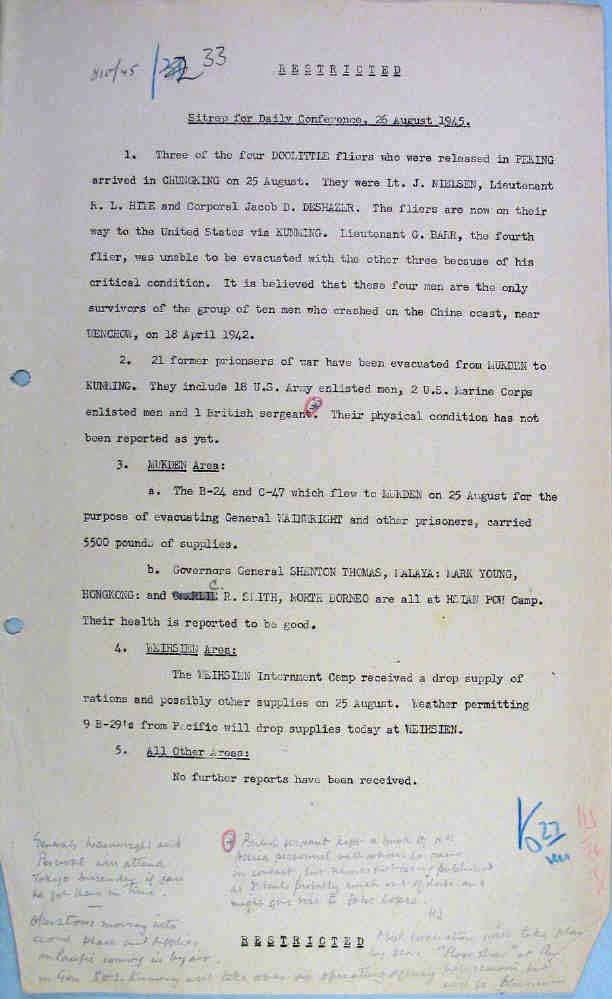
RESTRICTED
Sitrep for Daily Conference, 26 August 1945.
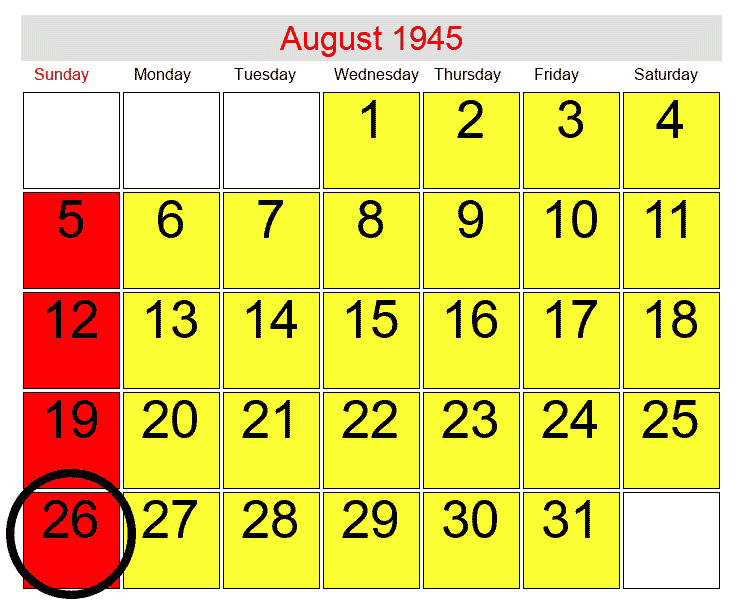 1.
1.
Three of the four DOOLITTLE fliers who were released in PEKING arrived in CHUNGKING on 25 August. They were Lt. J. NIELSEN, Lieutenant R.L. HITE and Corporal Jacob D. DESHAZER. The fliers are now on their way to the United States via KUNMING. Lieutenant G. BARR, the fourth flier, was unable to be evacuated with the other three because of his critical condition. It is believed that these four men are the only survivors of the group of ten men who crashed on the Chinese coast, near WENCHON, on 18 April 1942.
2.
21 former prisoners of war have been evacuated from MUKDEN to KUNMING. They include 18 U.S. Army enlisted men, 2 U.S. Marine Corps enlisted men and 1 British sergeant. Their physical condition has not been reported as yet.
3.
MUKDEN Area:
a.
The B-24 and the C-47 which flew to MUKDEN on 25 August for the purpose of evacuating General Wainwright and other prisoners, carried 5500 pounds of supplies.
b.
Governors General SHENTON THOMAS, MALAYA: MARK YOUNG, HONG KONG: C.R. SMITH, NORTH BORNEO are all at HAINAN POW camp. Their health is reported to be good.
4.
WEIHSIEN Area:
The WEIHSIEN Internment Camp received a drop supply of rations and possibly other supplies on 25 August. Weather permitting 9 B-29s from Pacific will drop supplies today at WEIHSEIN.
5.
All Other Areas:
No further reports have been received.
RESTRICTED

August 27, 1945
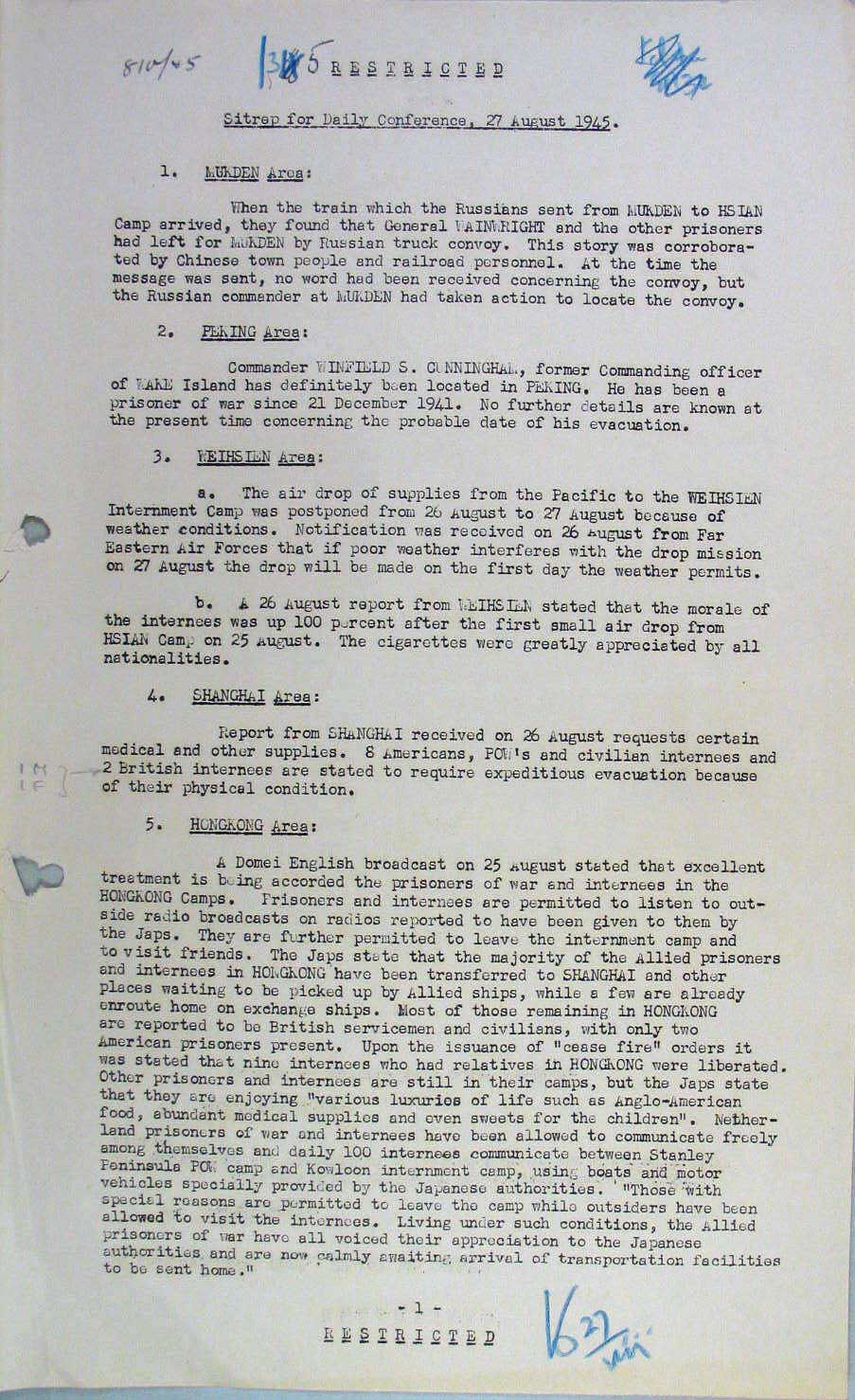
RESTRICTED
Sitrep for Daily Conference, 27 August 1945.
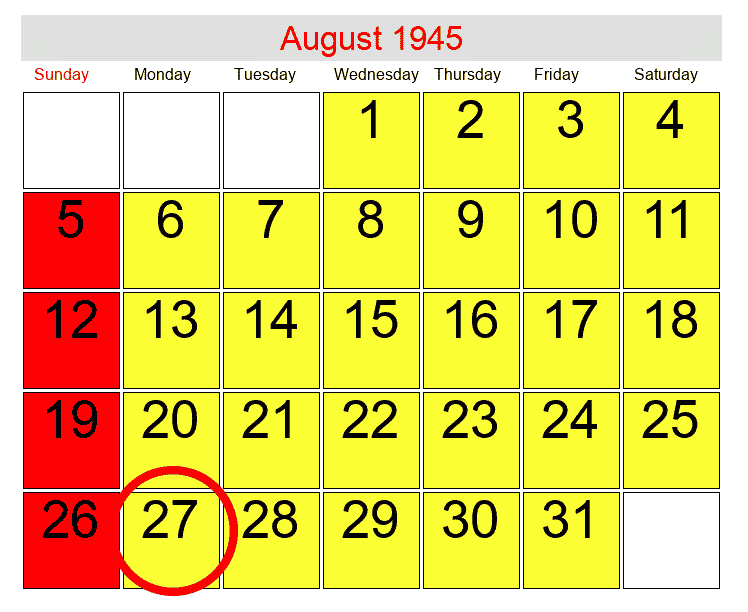 1.
1.
MUKDEN Area:
when the train which the Russians sent from MUKDEN to HSIAN Camp arrived, they found that General WAINWRIGHT and the other prisoners had left for MUKDEN by Russian truck convoy. This story was corroborated by Chinese town people and railroad personnel. At the time the message was sent, no word had been received concerning the convoy, but the Russian commander at MUKDEN had taken action to locate the convoy.
2.
PEKING Area:
Commander WINFIELD S. CUNNINGHAM, former Commanding officer of WAKE Island has definitely been located in PEKING. He has been a prisoner of war since 21 December 1941. No further details are known at the present time concerning the probable date of his evacuation.
3.
WEIHSIEN Area:
a.
The air drop of supplies from the Pacific to the WEIHSIEN Internment Camp was postponed from 26 August to 27 August because of weather conditions. Notification vas received on 26 August from Far Eastern Air Forces that if poor weather interferes with the drop mission on 27 August the drop will be made on the first day the weather permits.
b.
A 26 August report from WEIHSIEN stated that the morale of the internees was up 100 percent after the first small air drop from HSIAN Camp on 25 August. The cigarettes were greatly appreciated by all nationalities.
4.
SHANGHAI Area:
Report from SHANGHAI received on 26 August requests certain medical and other supplies. 8 Americans, POWs and civilian internees and 2 British internees are stated to require expeditious evacuation because of their physical condition.
5.
HONG KONG Area:
A Domei English broadcast on 25 August stated that excellent treatment is being accorded the prisoners of war end internees in the HONG KONG Camps. Prisoners and internees are permitted to listen to outside radio broadcasts on radios reported to have been given to them by the Japs. They are further permitted to leave the internment camp and to visit friends. The Japs state that the majority of the Allied prisoners and internees in HONG KONG have been transferred to SHANGHAI and other places waiting to be picked up by Allied ships, while a few are already enroute home on exchange ships. Most of those remaining in HONG KONG are reported to be British servicemen and civilians, with only two American prisoners present. Upon the issuance of "cease fire" orders it was stated that nine internees who had relatives in HONG KONG were liberated. Other prisoners and internees are still in their camps, but the Japs state that they are enjoying "various luxuries of life such as Anglo-American food, abundant medical supplies and even sweets for the children". Netherland prisoners of war and internees have been allowed to communicate freely among themselves and daily 100 internees communicate between Stanley Peninsula POW camp and Kowloon internment camp, using boats and motor vehicles specially provided by the Japanese authorities."Those with special reasons are permitted to leave the camp while outsiders have been allowed to visit the internees. Living under such conditions, the Allied prisoners of war have all voiced their appreciation to the Japanese authorities and are now calmly awaiting arrival of transportation facilities to be sent home."
RESTRICTED

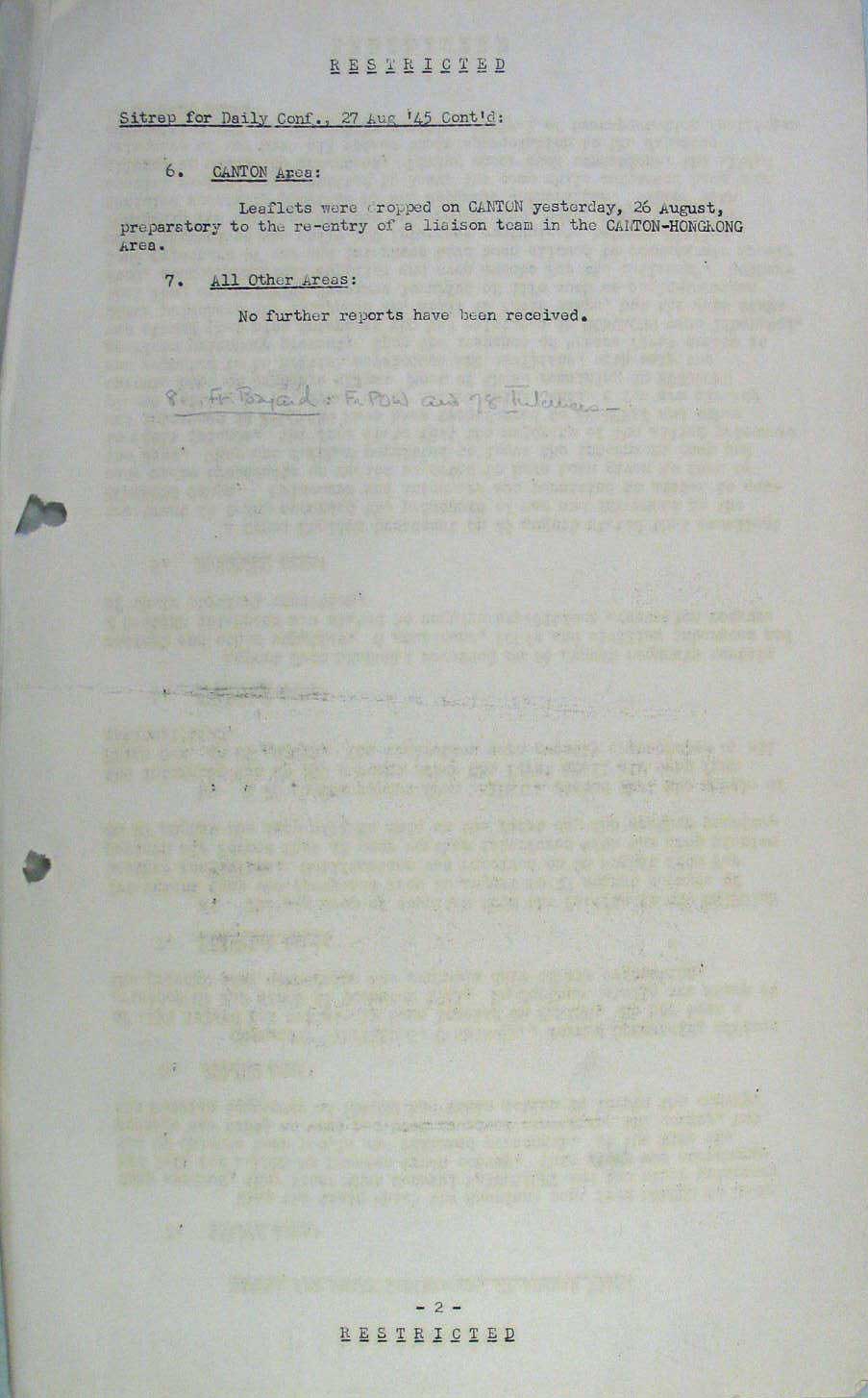
RESTRICTED
Sitrep for Daily Conf., 27 Aug., '45 Cont'd:
6.
CANTON Area:
Leaflets were dropped on CANTON yesterday, 26 August, preparatory to the re-entry of a liaison team in the CANTON-HONG KONG Area.
7.
All Other Areas.
No further reports have been received.
RESTRICTED
August 28, 1945
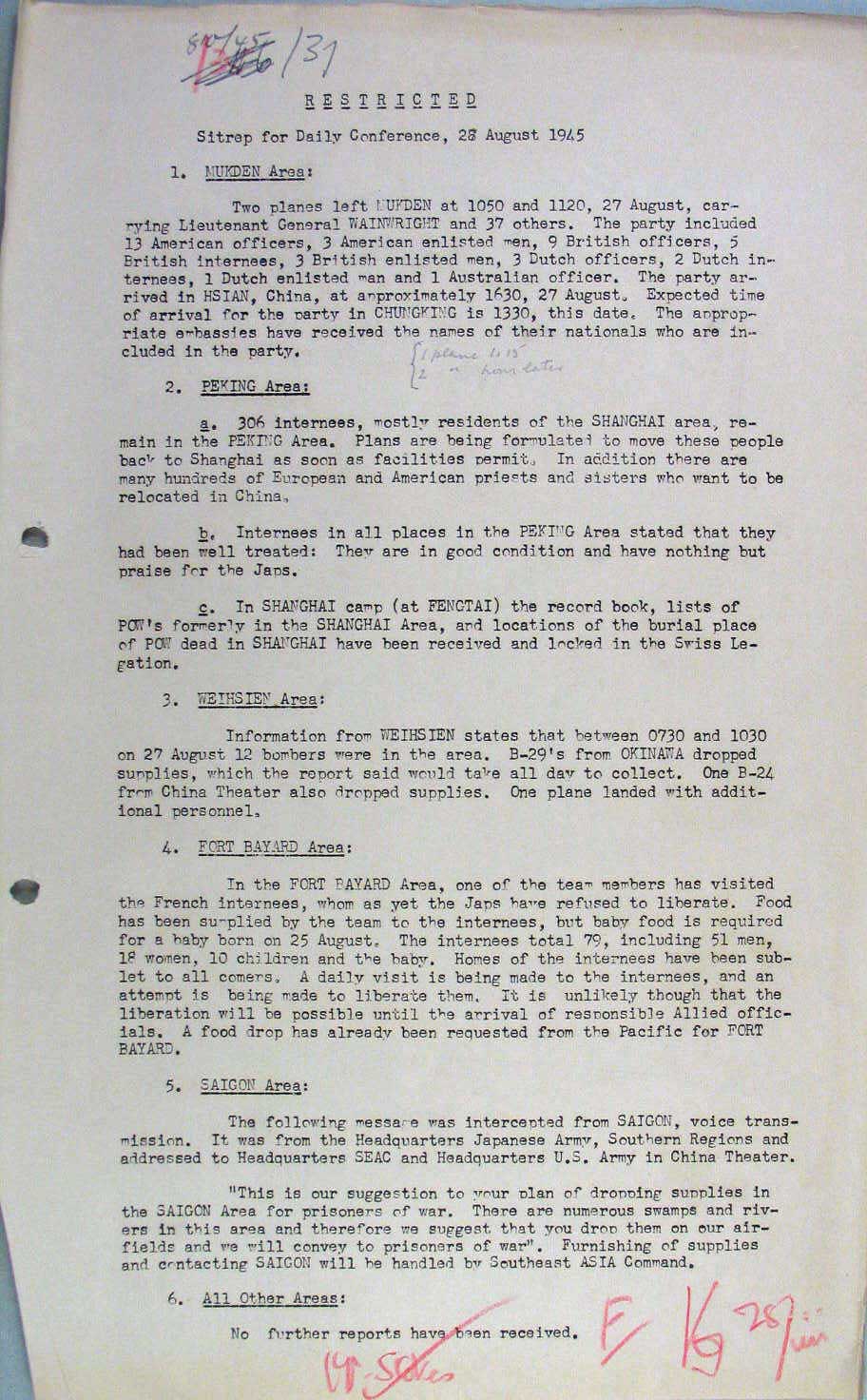
RESTRICTED
Sitrep for Daily Conference, 27 August 1945
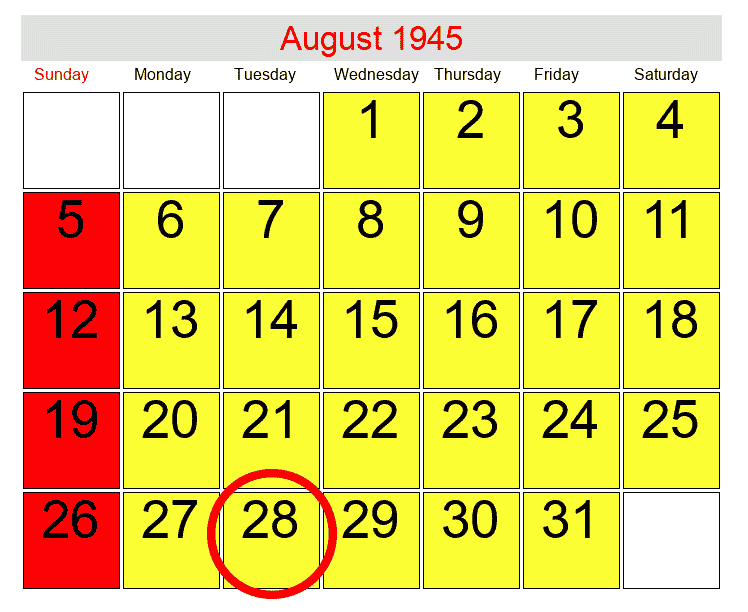 1.
1.
MUKDEN Area:
Two manes left MUKDEN at 10:50 and 11:20, 27 August, carrying Lieutenant General WAINWRIGHT and 37 others. The party included 13 American officers, 3 American enlisted men, 9 British officers, 5 British internees, 3 British enlisted men, 3 Dutch officers, 2 Dutch internees, 1 Dutch enlisted man and 1 Australian officer. The party arrived in HSIAN, China, at approximately 16:30, 27 August. Expected time of arrival con the party in CHUNGKING is 13:30, this date, The appropriate embassies have received the names of their nationals who are included in the party.
2.
PEKING Area:
a.
306 internees, mostly residents of the SHANGHAI area, remain in the PEKING Area. Plans are being formulated to move these people back to Shanghai as soon as facilities permit. In addition there are many hundreds of European and American priests and sisters who want to be relocated in China.
b.
Internees in all places in the PEKING Area stated that they had been well treated: They are in good condition and have nothing but praise for the Japs.
c.
In SHANGHAI camp (at FENGTAI) the record book, lists of POWs formerly in the SHANGHAI Area, and locations of the burial place of POWs dead in SHANGHAI have been received and locked in the Swiss Legation.
3.
WEIHSIEN Area:
Information from WEIHSIEN states that between 07:30 and 10:30 on 27 August 12 bombers were in the area. B-29s from OKINAWA dropped supplies, which the report said would take all day to collect. One B-24 from China Theater also dropped supplies. One plane landed with additional personnel.
4.
FORT BAYARD Area:
In the FORT BAYARD Area, one of the team members has visited the French internees, whom as yet the Japs have refused to liberate. Food has been supplied by the team to the internees, but baby food is required for a baby born on 25 August. The internees total 79, including 51 men, 18 women, 10 children and the baby. Homes of the internees have been sublet to all comers. A daily visit is being made to the internees, and an attempt is being made to liberate them. It is unlikely though that the liberation will be possible until the arrival of responsible Allied officials. A food drop has already been requested from the Pacific for FORT BAYARD .
5.
SAIGON Area:
The following message was intercepted from SAIGON, voice transmission. It was from the Headquarters Japanese Army, Southern Regions and addressed to Headquarters SEAC and Headquarters U.S. Army in China Theater.
"This is our suggestion to your plan of dropping supplies in the SAIGON Area for prisoners of war. There are numerous swamps and rivers in this area and therefore we suggest that you drop them on our airfields and we will convey to prisoners of war". Furnishing of supplies and contacting SAIGON will be handled by Southeast ASIA Command.
6.
All Other Areas:
No further reports have been received.
RESTRICTED

August 30, 1945
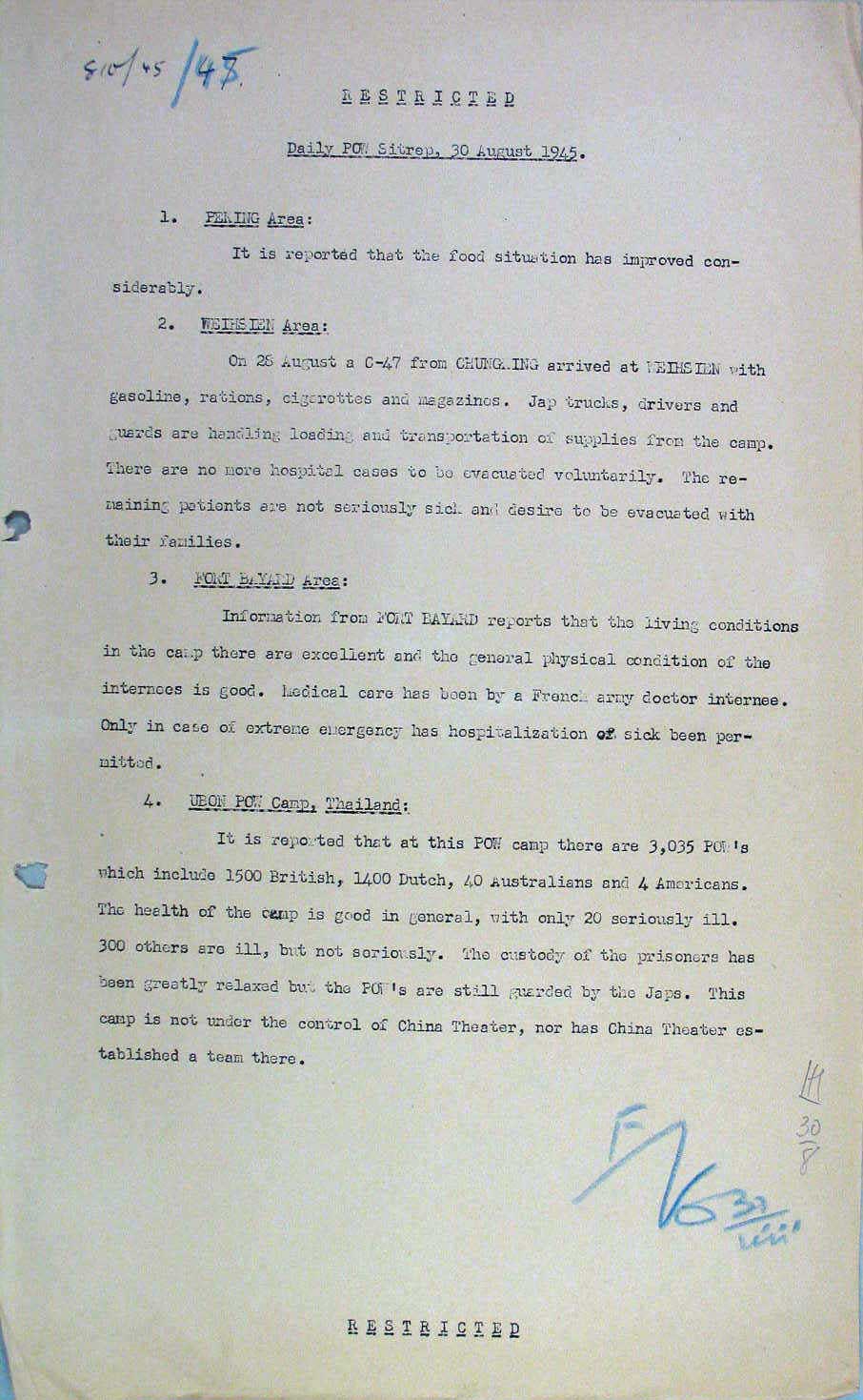
RESTRICTED
Daily POW Sitrep, 30 August 1945.
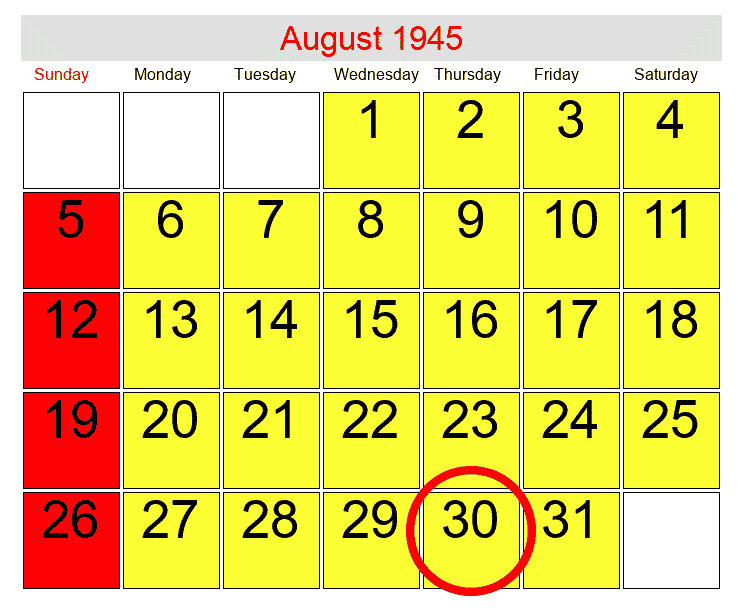 1.
1.
PEKING Area:
It is reported that the food situation has improved considerably.
2.
WEIHSIEN Area:
On 28 August, a C-47 from CHUNGKING; arrived at WEIHSIEN with gasoline, rations, cigarettes and magazines. Jap trucks, drivers and guards are handling loading and transportation of supplies from the camp.
There are no more hospital cases to be evacuated voluntarily. The remaining patients are not seriously sick and desire to be evacuated with their families.
3.
FORT BAYARD Area:
Information from FORT BAYARD reports that the living conditions in the camp are excellent and the general physical condition of the internees is good. Medical care has been by a French army doctor internee. Only in case of extreme emergency has hospitalization of sick been permitted.
4.
UBON POW Camp, Thailand:
It is reported that at this POW camp there are 3,035 POWs which include 1500 British, 1400 Dutch, 40 Australians and 4 Americans. The health of the camp is good in general, with only 20 seriously ill. 300 others are ill, but not seriously. The custody of the prisoners has been greatly relaxed but, the POWs are still guarded by the Japs. This camp is not under the control of China Theater, nor has China Theater established a team there.
RESTRICTED

August 31, 1945
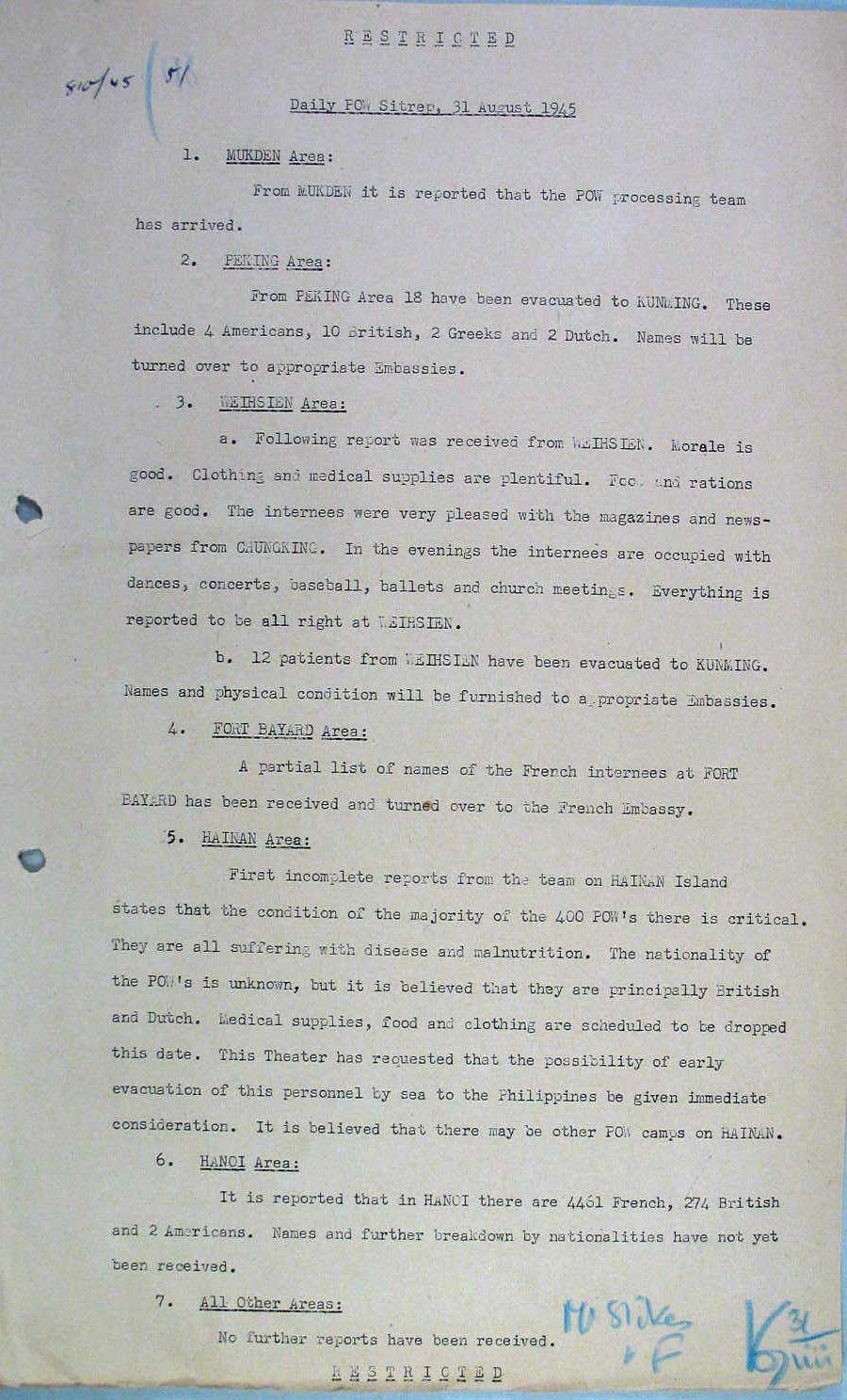
RESTRICTED
Daily POW Sitrep, 31 August 1945
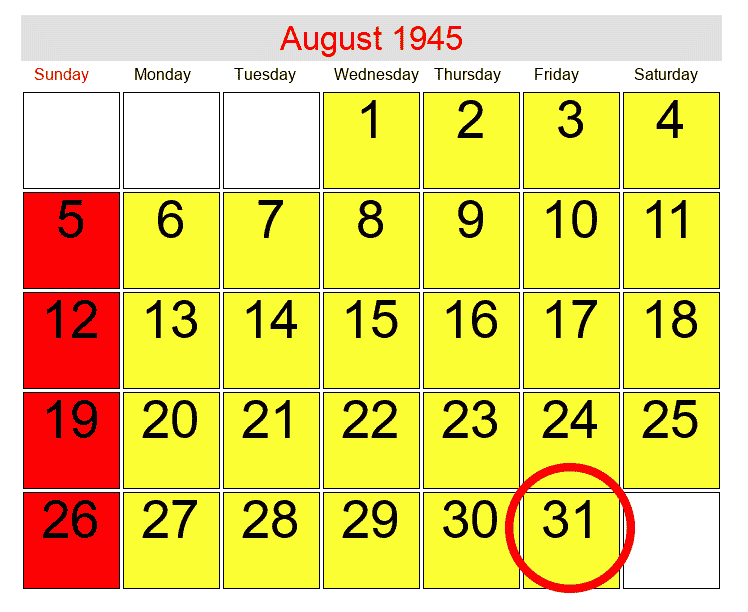 1.
1.
MUKDEN Area:
From MUKDEN it is reported that the POW processing team has arrived.
2.
PEKING Area:
From PEKING Area, 18 have been evacuated to KUNMING. These include 4 Americans, 10 British, 2 Greeks and 2 Dutch. Names will be turned over to appropriate Embassies.
3.
WEIHSIEN Area:
a.
Following report was received from WEIHSIEN. Morale is good. Clothing and medical supplies are plentiful. Food and rations are good. The internees were very pleased with the magazines and newspapers from CHUNGKING. In the evenings the internees are occupied with dances, concerts, baseball, ballets and church meetings. Everything is reported to be all right at WEIHSIEN.
b.
12 patients from WEIHSIEN have been evacuated to KUNMING. Names and physical condition will be furnished to appropriate Embassies.
4.
FORT BAYARD Area:
A partial list of names of the French internees at FORT BAYARD has been received and turned over to the French Embassy.
5.
HAINAN Area:
First incomplete reports from the team on HAINAN Island states that the condition of the majority of the 400 POWs there is critical. They are all suffering with disease and malnutrition. The nationality of the POWs is unknown, but it is believed that they are principally British and Dutch. Medical supplies, food and clothing are scheduled to be dropped this date. This Theatre has requested that the possibility of early evacuation of this personnel by sea to the Philippines be given immediate consideration. It is believed that there may be other POW camps on HAINAN.
6.
HANOI Area:
It is reported that in HANOI there are 4461 French, 274 British and 2 Americans. Names and further breakdown by nationalities have not yet been received.
7.
All Other Areas:
No further reports have been received.
RESTRICTED

September 1, 1945
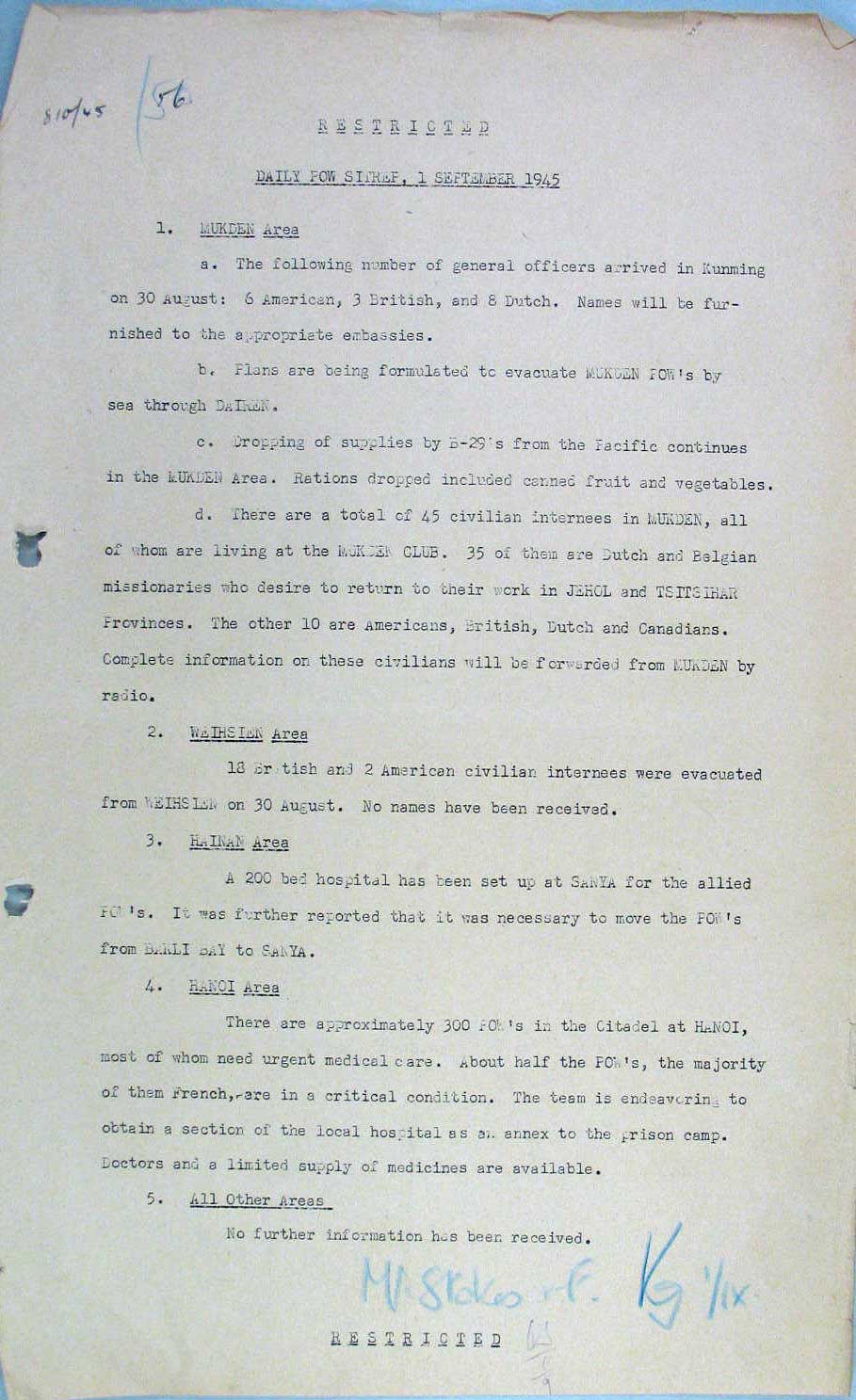
RESTRICTED
DAILY POW SITREP, 1 SEPTEMBER 1945
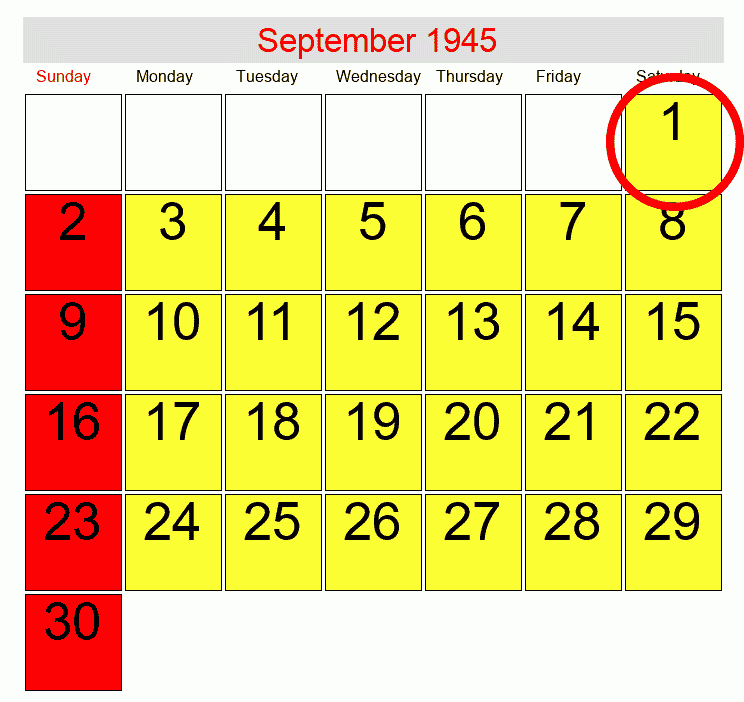 1.
1.
MUKDEN Area:
a.
The following number of general officers arrived in Kunming on 30 August: 6 American, 3 British, and 8 Dutch. Names will be furnished to the appropriate embassies.
b.
Plans are being formulated to evacuate MUKDEN POWs by sea through DAIREN.
c.
Dropping of supplies by B-29s from the Pacific continues in the MUKDEN Area. Rations dropped included canned fruit and vegetables.
d.
There are a total of 45 civilian internees in MUKDEN, all of whom are living at the MUKDEN CLUB. Thirty-five of them are Dutch and Belgian missionaries who desire to return to their work in JEHOL and TSITSIHAR Provinces. The other 10 are Americans, British, Dutch and Canadians. Complete information on these civilians will be forwarded from MUKDEN by radio.
2.
WEIHSIEN Area:
18 British and 2 American civilian internees were evacuated from WEIHSIEN on 30 August. No names have been received.
3.
HAINAN Area:
A 200-bed hospital has been set up at SANYA for the allied POWs. It was further reported that it was necessary to move the POWs from BAKLI BAY to SANYA.
4.
HANOI Area:
There are approximately 300 POWs in the Citadel at HANOI, most of whom need urgent medical care. About half the POWs, the majority of them French, are in a critical condition. The team is endeavouring, to obtain a section of the local hospital as an annexe to the prison camp. Doctors and a limited supply of medicines are available.
5.
All Other Areas:
No further information has been received.
RESTRICTED

September 4, 1945
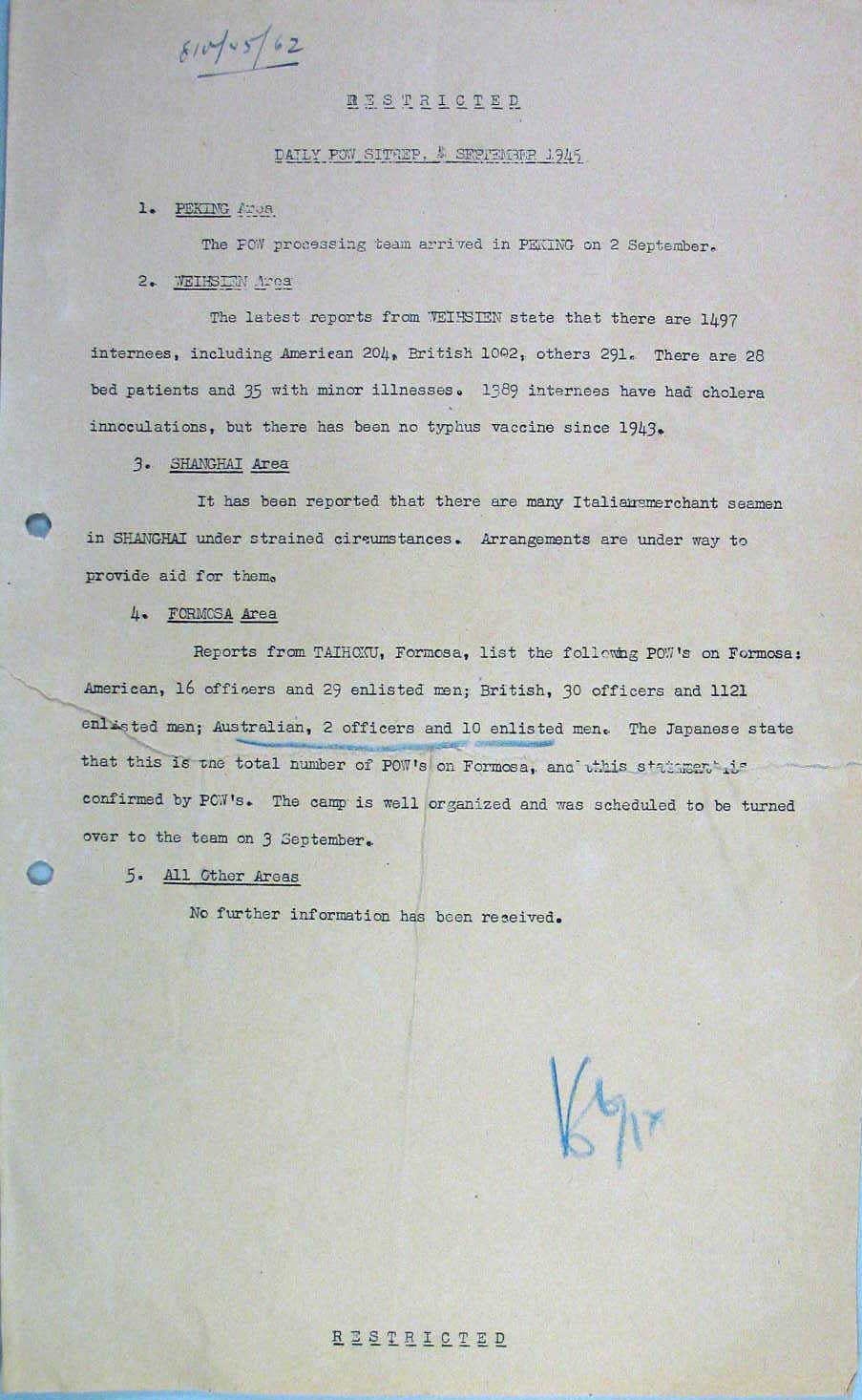
RESTRICTED
DAILY POW SITREP, 4 SEPTEMBER 1945
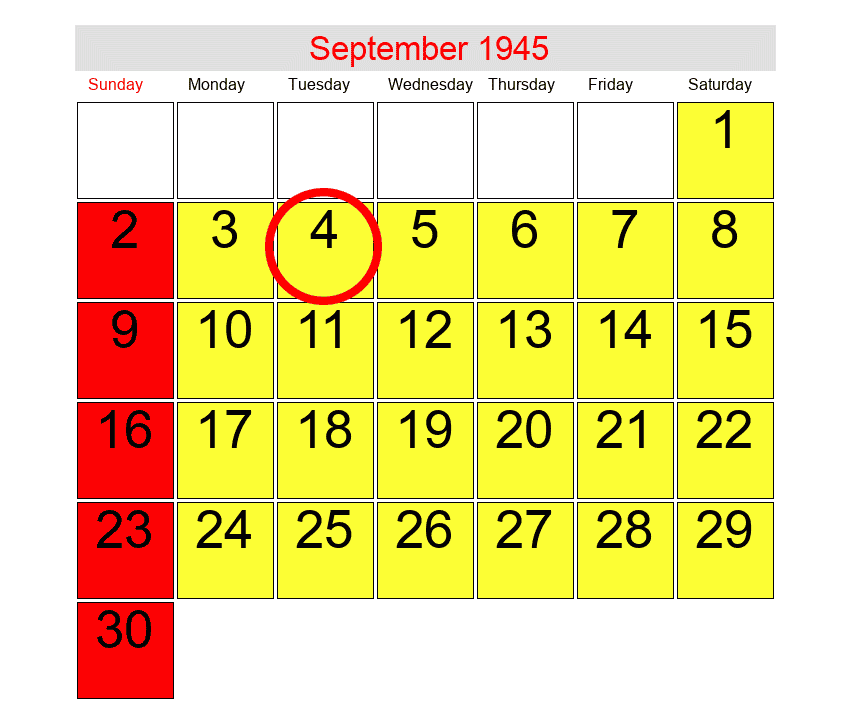 1.
1.
PEKING Area:
The POW processing team arrived in PEKING on 2 September.
2.
WEIHSIEN Area:
The latest reports from WEIHSIEN state that there are 1497 internees, including American 204, British 1002, other 291. There are 28 bed patients and 35 with minor illnesses. 1389 internees have had cholera inoculations, but there has been no typhus vaccine since 1943.
3.
SHANGHAI Area:
It has been reported that there are many Italian merchant seamen in SHANGHAI under strained circumstances. Arrangements are under way to provide aid for them.
4.
FORMOSA Area:
Reports from TAIHOXU, Formosa, list the following POWs on Formosa: American, 16 officers and 29 enlisted men; British, 30 officers and 1121 enlisted men; Australian, 2 officers and 10 enlisted men. The Japanese state that this is the total number of POWs on Formosa, and this statement is confirmed by POWs. The camp is well organized and was scheduled to be turned over to the team on 3 September.
5.
All Other Areas:
No further information has been received.
RESTRICTED

September 5, 1945
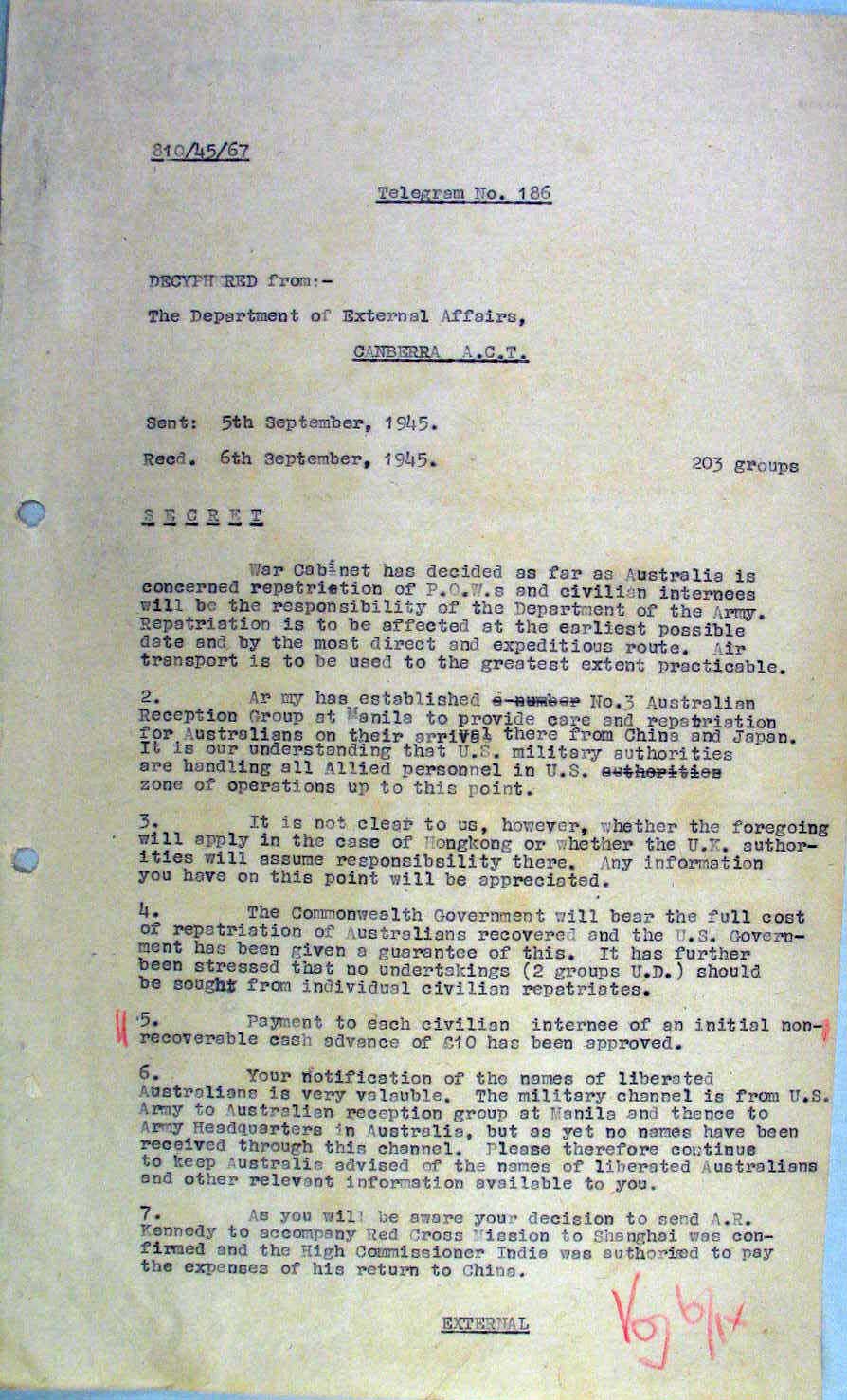
810/45/67
Telegram No. 186
DECYPHERED from:-
The Deportment of External Affairs,
CANBERRA A.C.T.
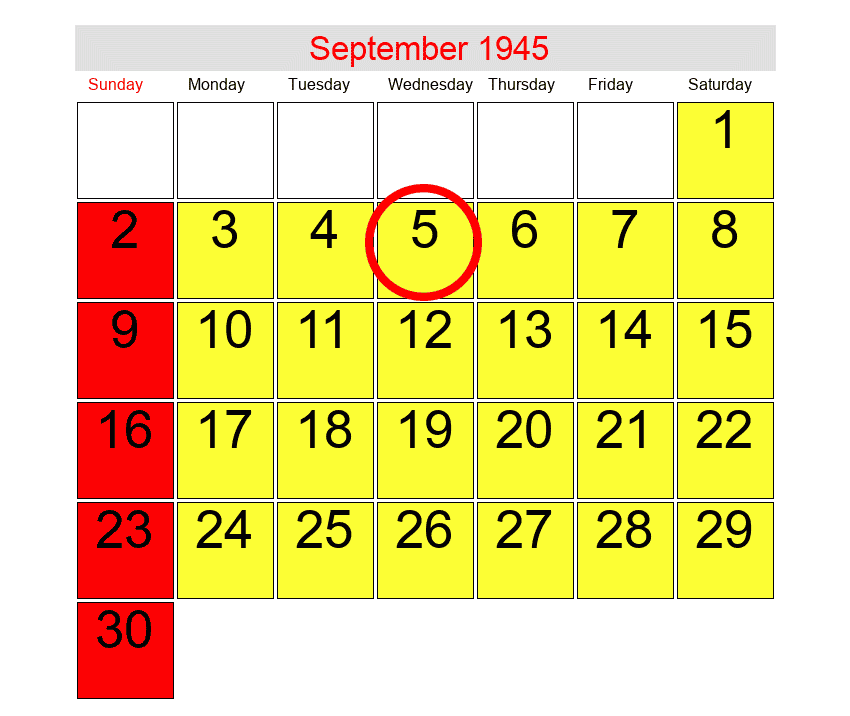 Sent: 5 September 1945.
Sent: 5 September 1945.
Read. 6 September 1945.
203 groups
SECRET
War Cabinet has decided as far as Australia is concerned repatriation of POWs and civilian internees will be the responsibility of the Department of the Army. Repatriation is to be affected at the earliest possible date and by the most direct and expeditious route. Air transport is to be used to the greatest extent practicable.
2.
Army has established No. 3 Australian Reception Camp at Manila to provide care and repatriation for Australians on their arrival there from China and Japan. It is our understanding that U.S. military authorities are handling all Allied personnel in the U.S. zone of operations up to this point.
3.
It is not clear to us, however, whether the foregoing will apply in the case of Hong Kong or whether the U.K. authorities will assume responsibility there. Any information you have on this point will be appreciated.
4.
The Commonwealth Government will bear the full cost of repatriation of Australians recovered and the U.S. Government has been given a guarantee of this. It has further been stressed that no undertakings (2 groups U.D.) should be sought from individual civilian repatriates.
5.
Payment to each civilian internee of an initial non-recoverable cash advance of £10 has been approved.
6.
Your notification of the names of liberated Australians is very valuable. The military channel is from U.S. Army to Australian reception group at Manila and thence to Army Headquarters in Australia, but as yet no names have been received through this channel. Please therefore continue to keep Australia advised of the names of liberated Australians and other relevant information available to you.
7.
As you will be aware, your decision to send A.R. Kennedy to accompany Red Cross Mission to Shanghai was confirmed and the High Commissioner India was authorised to pay the expense of his return to China.
EXTERNAL

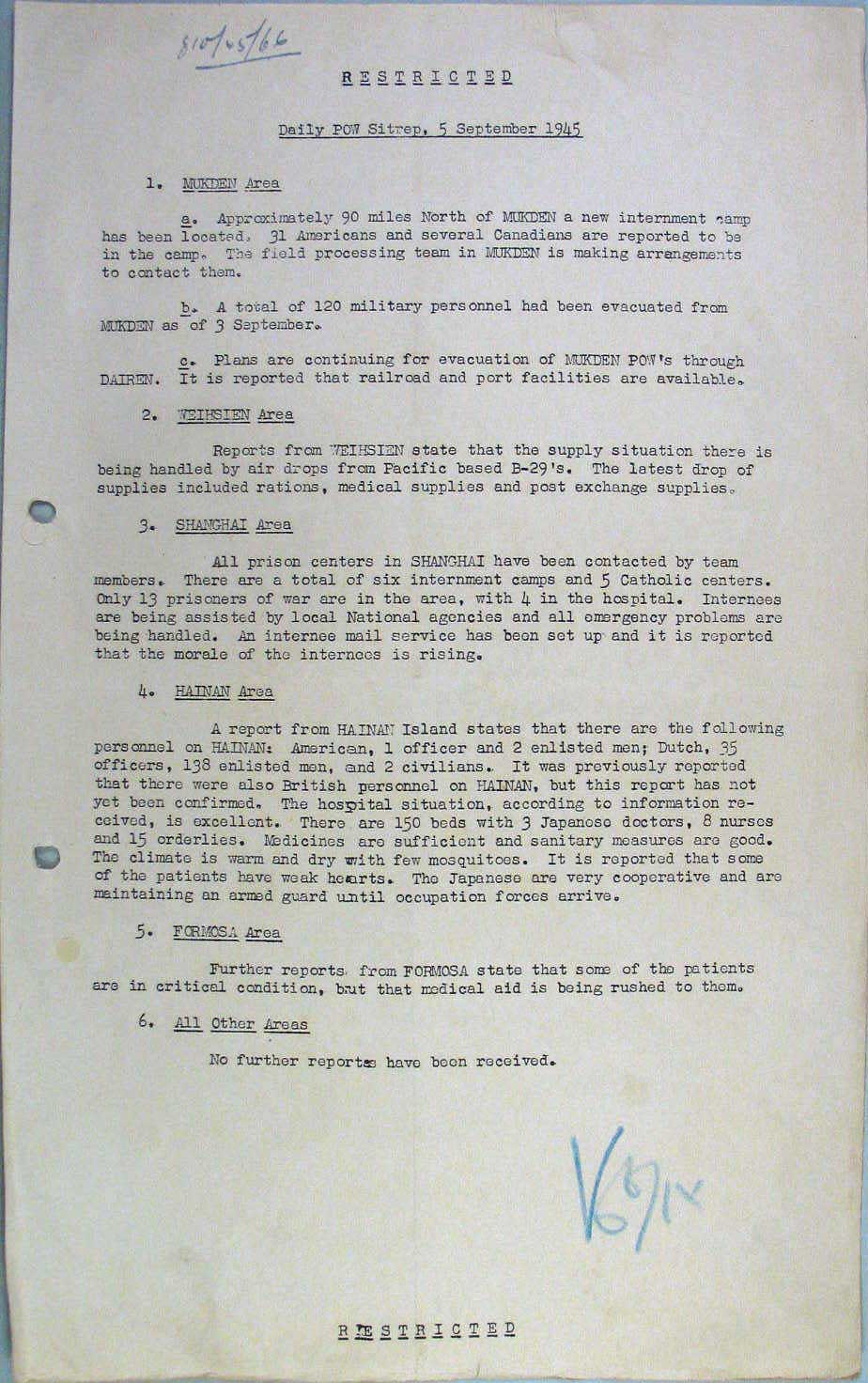
RESTRICTED
Daily POW Sitrep, 5 September 1945
1.
MUKDEN Area
a.
Approximately 90 miles North of MUKDEN a new internment camp has been located. Thirty-one Americans and several Canadians are reported to be in the camp. The field processing team in MUKDEN is making arrangements to contact them.
b.
A total of 120 military personnel had been evacuated from MUKDEN as of 3 September.
c.
Plans are continuing for evacuation of MUKDEN P0Ws through DAIREN. It is reported that railroad and port facilities are available.
2.
WEIHSIEN Area
Reports from WEIHSIEN state that the supply situation there is being handled by air drops from Pacific based B-29s. The latest drop of supplies included rations, medical supplies and post exchange supplies.
3.
SHANGHAI Area
All prison centres in SHANGHAI have been contacted by team members. There are a total of six internment camps and 5 Catholic centres. Only 13 prisoners of war are in the area, with 4 in the hospital. Internees are being assisted by local National agencies and all emergency problems are being handled. An internee mail service has been set up and it is reported that the morale of the internees is rising.
4.
HAINAN Area
A report from HAINAN Island states that there is the following personnel on HAINAN: American, 1 officer and 2 enlisted men; Dutch, 35 officers, 138 enlisted men, and 2 civilians. It was previously reported that there was also British personnel on HAINAN, but this report has not yet been confirmed. The hospital situation, according to information received, is excellent. There are 150 beds with 3 Japanese doctors, 8 nurses and 15 orderlies. Medicines are sufficient and sanitary measures are good. The climate is warm and dry with few mosquitoes. It is reported that some of the patients have weak hearts. The Japanese are very cooperative and are maintaining an armed guard until occupation forces arrive.
5.
FORMOSA Area
Further reports, from FORMOSA state that some of the patients are in critical condition, but that medical aid is being rushed to them.
6.
All Other Areas
No further reports have been received.
EXTERNAL
September 6, 1945
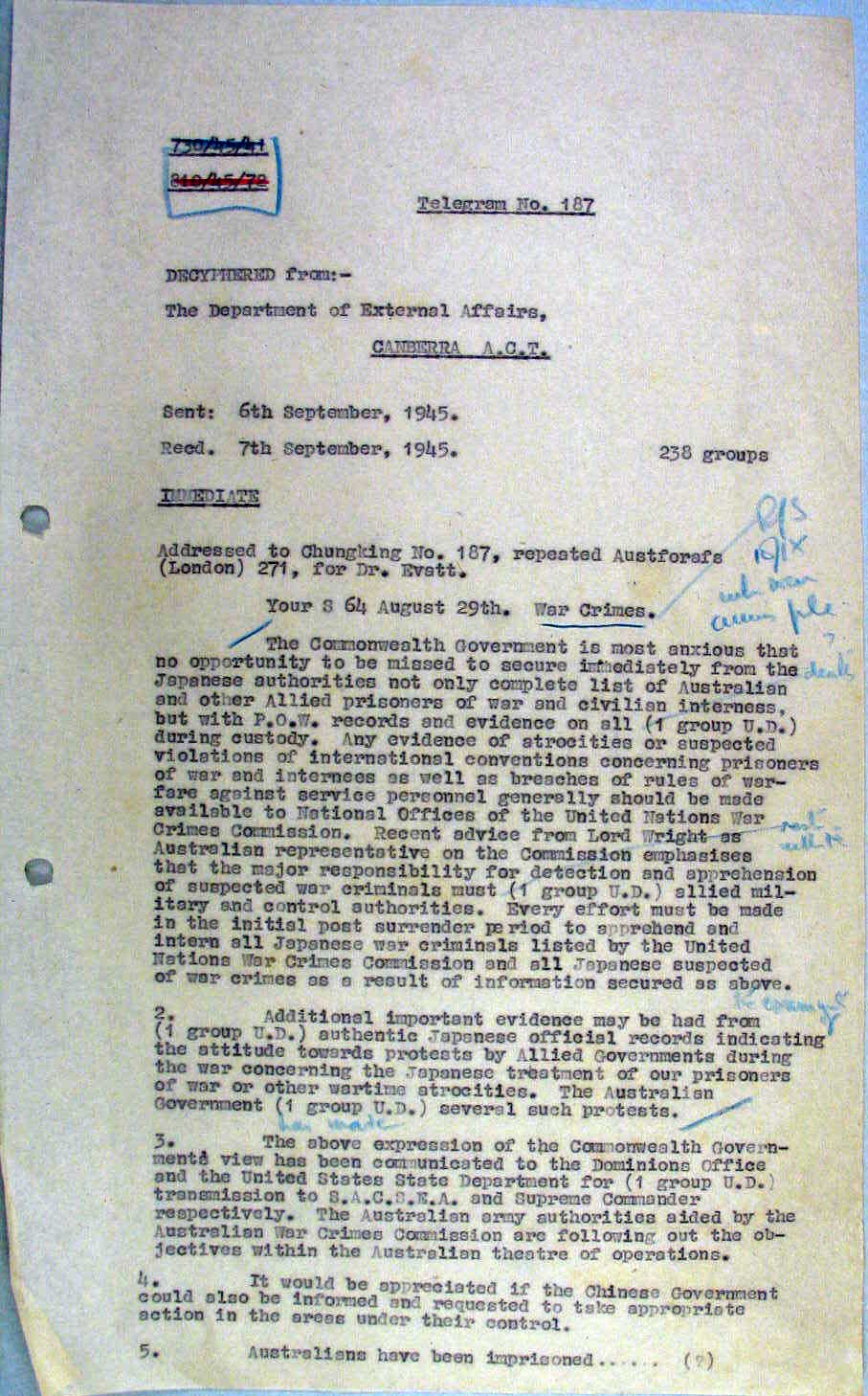
Telegram No. 187
DECYPHERED from:-
The Department of External Affairs,
CANBERRA A.C.T.
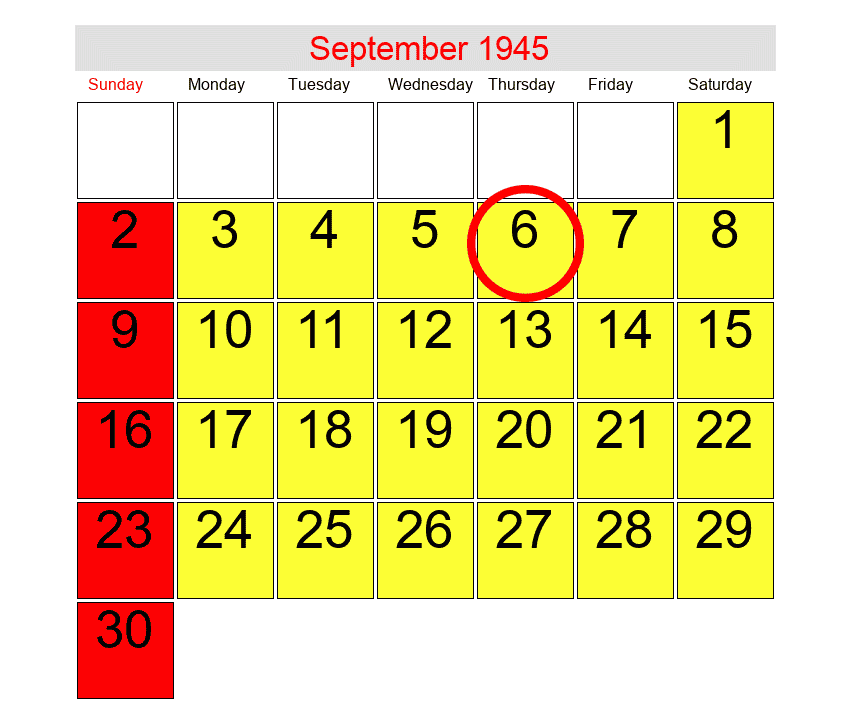 Sent: 6 September 1945.
Sent: 6 September 1945.
Recd. 7 September 1945.
238 groups
IMMEDIATE
Addressed to Chungking No. 187, repented Austforafs (London) 271, for Dr. Evatt.
Yours 64, August 29th. War Crimes.
The Commonwealth Government is most anxious that no opportunity to be missed to secure immediately from the Japanese authorities not only complete list of Australian and other Allied prisoners of war and civilian internees, but with P.O.W. records and evidence on all (1 group U.D.) during custody. Any evidence of atrocities or suspected violations of international conventions concerning prisoners of war and internees as well as breaches of rules of warfare against service personnel generally should be made available to National Offices of the United Nations War Crimes Commission. Recent advice from Lord Wright as Australian representative on the Commission emphasises that the major responsibility for detection and apprehension of suspected war criminals must (1 group U.D.) allied military and control authorities. Every effort must be made in the initial post surrender period to apprehend and intern all Japanese war criminals listed by the United Nations War Crimes Commission and all Japanese suspected of war crimes as a result of information secured as above.
2.
Additional important evidence may be had from (1 group U.D.) authentic Japanese official records indicating the attitude towards protests by Allied Governments during the war concerning the Japanese treatment of our prisoners of war or other wartime atrocities. The Australian Government (1 group U.D.) several such protests.
3.
The above expression of the Commonwealth Government's view has been communicated to the Dominions Office and the United States State Department for (1 group U.D.) transmission to S.A.C.S.E.A. and Supreme Commander respectively. The Australian army authorities aided by the Australian War Crimes Commission are following out the objectives within the Australian theatre of operations.
4.
It would be appreciated if the Chinese Government could also be informed and requested to take appropriate action in the areas under their control.
5.
Australians have been imprisoned . . . (?)

September 8, 1945
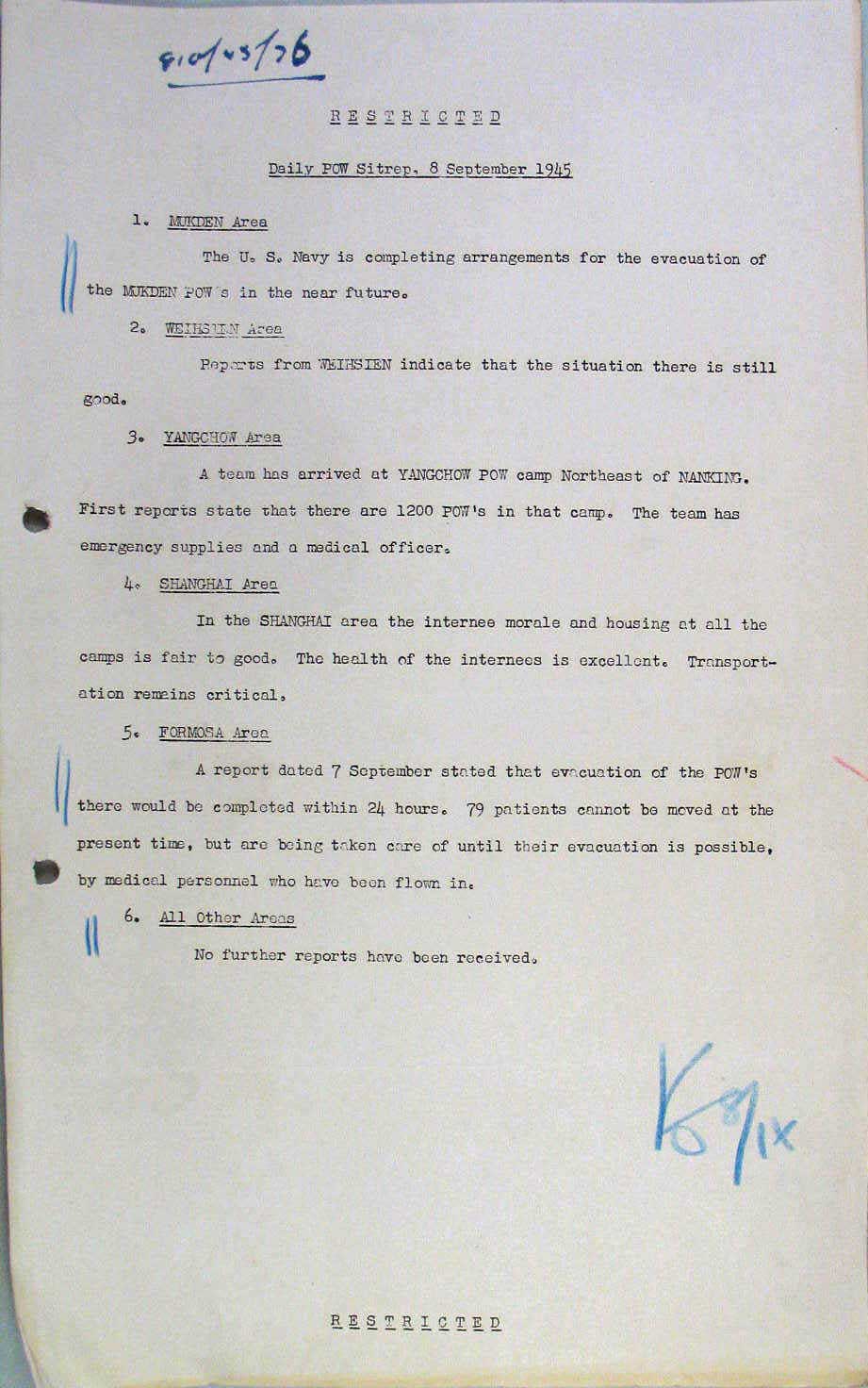
RESTRICTED
Daily POW Sitrep. 8 September 1945
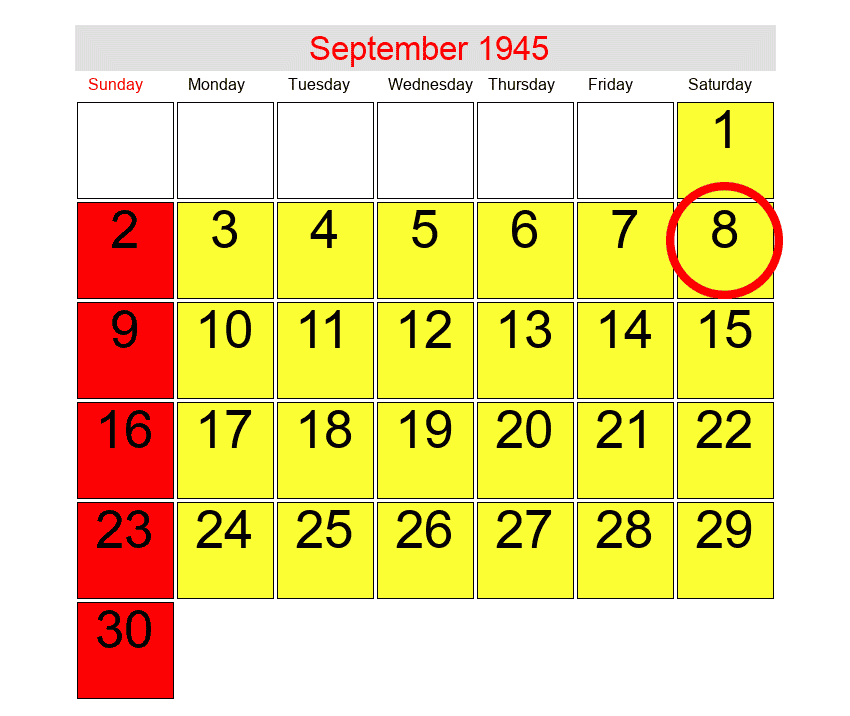 1.
1.
MUKDEN Area
The U.S. Navy is completing arrangements for the evacuation of the MUKDEN POWs in the near future.
2.
WEIHSIEN Area
Reports from WEIHSIEN indicate that the situation there is still good.
3.
YANGCHOW Area
A team has arrived at YANGCHOW POW camp Northeast of NANKING. First reports state that there are 1200 POWs in that camp. The team has emergency supplies and a medical officer.
4.
SHANGHAI Area
In the SHANGHAI area the internee morale and housing at all the camps is fair to good. The health of the internees is excellent. Transportation remains critical.
5.
FORMOSA Area
A report dated 7 September stated that evacuation of the POWs there would be completed within 24 hours. Seventy-nine patients cannot be moved at the present time, but are being taken care of until their evacuation is possible, by medical personnel who hew been flown in.
6.
All Other Areas
No further reports have been received.
RESTRICTED

September 10, 1945
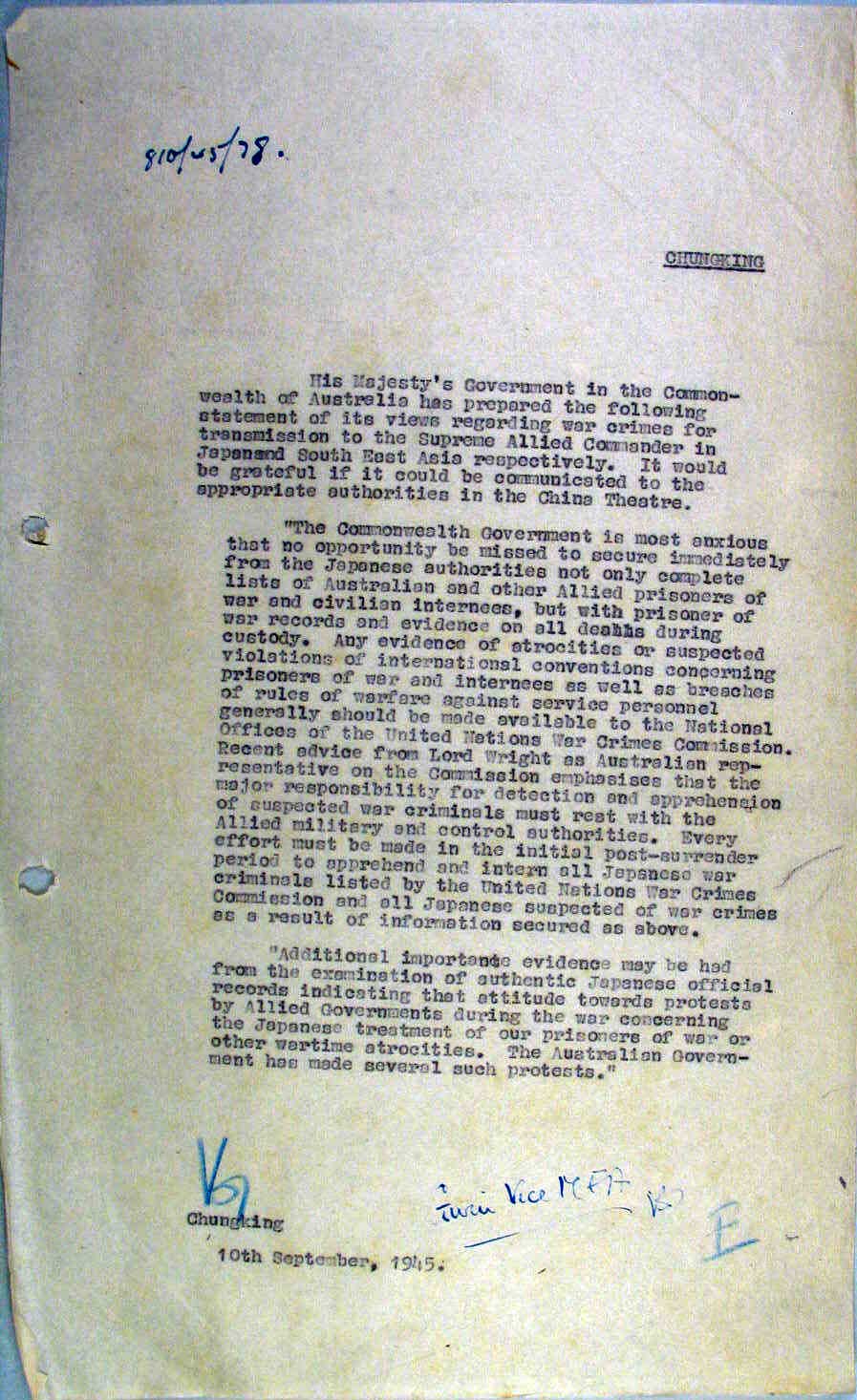
CHUNGKING
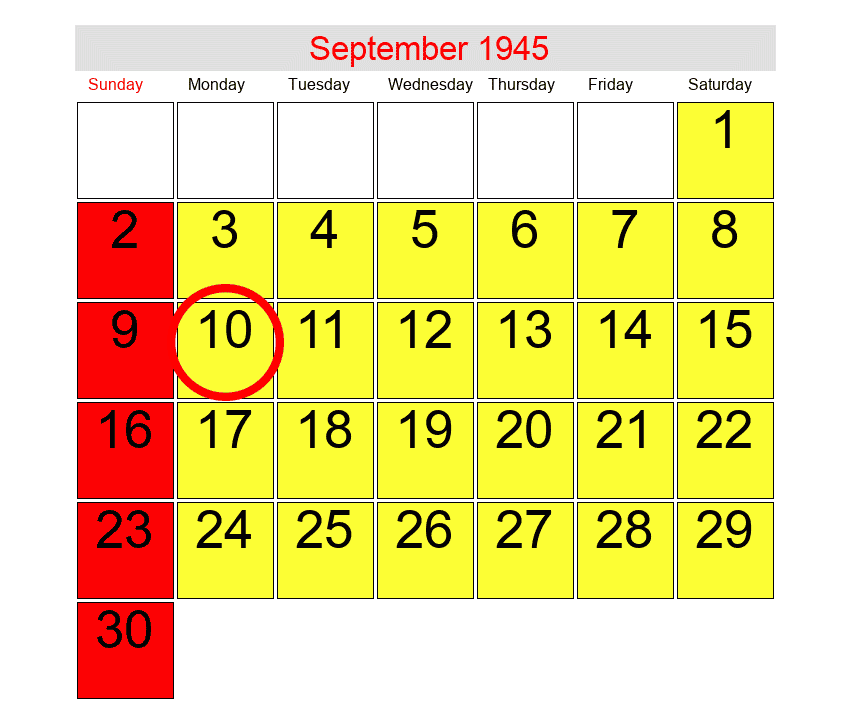 His Majesty's Government in the Commonwealth of Australia has prepared the following statement of its views regarding war crimes for transmission to the Supreme Allied Commander in Japan and South-East Asia respectively. It would be greateful if it could be communicated to the appropriate authorities in the China Theatre.
His Majesty's Government in the Commonwealth of Australia has prepared the following statement of its views regarding war crimes for transmission to the Supreme Allied Commander in Japan and South-East Asia respectively. It would be greateful if it could be communicated to the appropriate authorities in the China Theatre.
"The Commonwealth Government is most anxious that no opportunity be missed to secure immediately from the Japanese authorities not only complete list of Australian and other Allied prisoners of war and civilian internees, but with prisoners of war records and evidence on all deaths during custody. Any evidence of atrocities or suspected violations of international conventions concerning prisoners of war and internees as well as breaches of rules of warfare against service personnel generally should be made available to the National Offices of the United Nations War Crimes Commission.
Recent advice from Lord Wright as Australian representative on the Commission emphasises that the major responsibility for detection one apprehension of suspected war criminals must rest with the Allied military and control authorities. Every effort must be made in the initial post-surrender period to apprehend and intern all Japanese war criminals listed by the United Nations War Crimes Commission and all Japanese suspected of war crimes as a result of information secured as above.
"Additional important evidence may be had from the examination of authentic Japanese official records indicating that attitude towards protests by Allied Governments during the war concerning the Japanese treatment of our prisoners of war or other wartime atrocities. The Australian Government has made several such protests."
Chungking 10 September 1945.

September 11, 1945
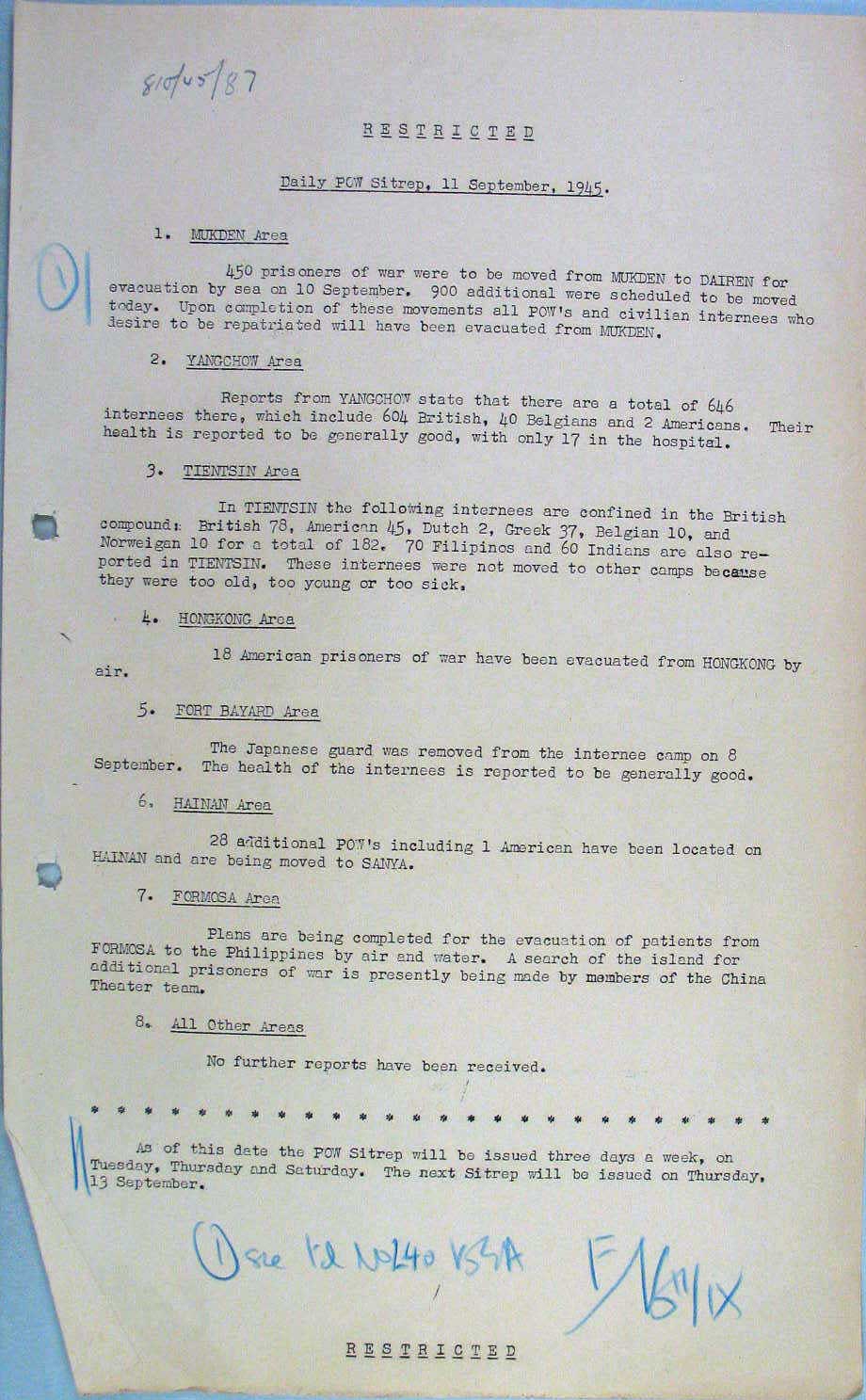
RESTRICTED
Daily POW Sitrep, 11 September 1945.
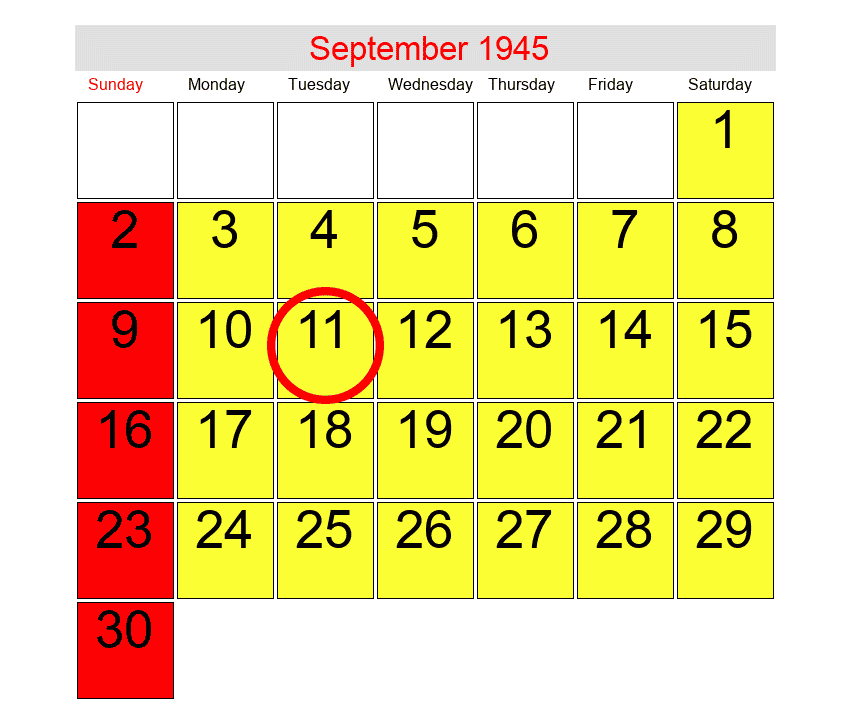 1.
1.
MUKDEN Area
Four hundred and fifty prisoners of war were to be moved from MUKDEN to DAIREN for evacuation by sea on 10 September. Nine hundred additional were scheduled to be moved today. Upon completion of these movements, all POWs and civilian internees who desire to be repatriated will have been evacuated from MUKDEN.
2.
YANGCHOW Area
Reports foot YANGCHOW state that there are a total of 646 internees there, which include 604 British, 40 Belgians and 2 Americans. Their health is reported to be generally good, with only 17 in the hospital.
3.
TIENTSIN Area
In TIENTSIN the following internees are confined in the British compound: British 78, American 45, Dutch 2, Greek 37, Belgian 10, and Norwegian 10 for a total of 182. 70 Filipinos and 60 Indians arc also reported in TIENTSIN. These internees were not moved to other camps because they were too old, too young or too sick.
4.
HONG KONG Area
18 American prisoners of war have been evacuated from HONG KONG by air.
5.
FORT BAYARD Area
The Japanese guard was removed from the internee camp on 8 September. The health of the internees is reported to be generally good.
6.
HAINAN Area
Twenty-eight additional POWs including 1 American have been located on HAINAN and are being moved to SANYA.
7.
FORMOSA Area
Plans are being completed for the evacuation of patients from FORMOSA to the Philippines by air and water. A search of the island for additional prisoners of war is presently being made by members of the China Theater team.
8.
All Other areas
No further reports have been received.
***************************************************
As of this date, the P0W Sitrep will be issued three days a week, on Tuesday, Thursday and Saturday. The text Sitrep wi11 be issued on Thursday, 13 September 1945.
RESTRICTED

September 13, 1945
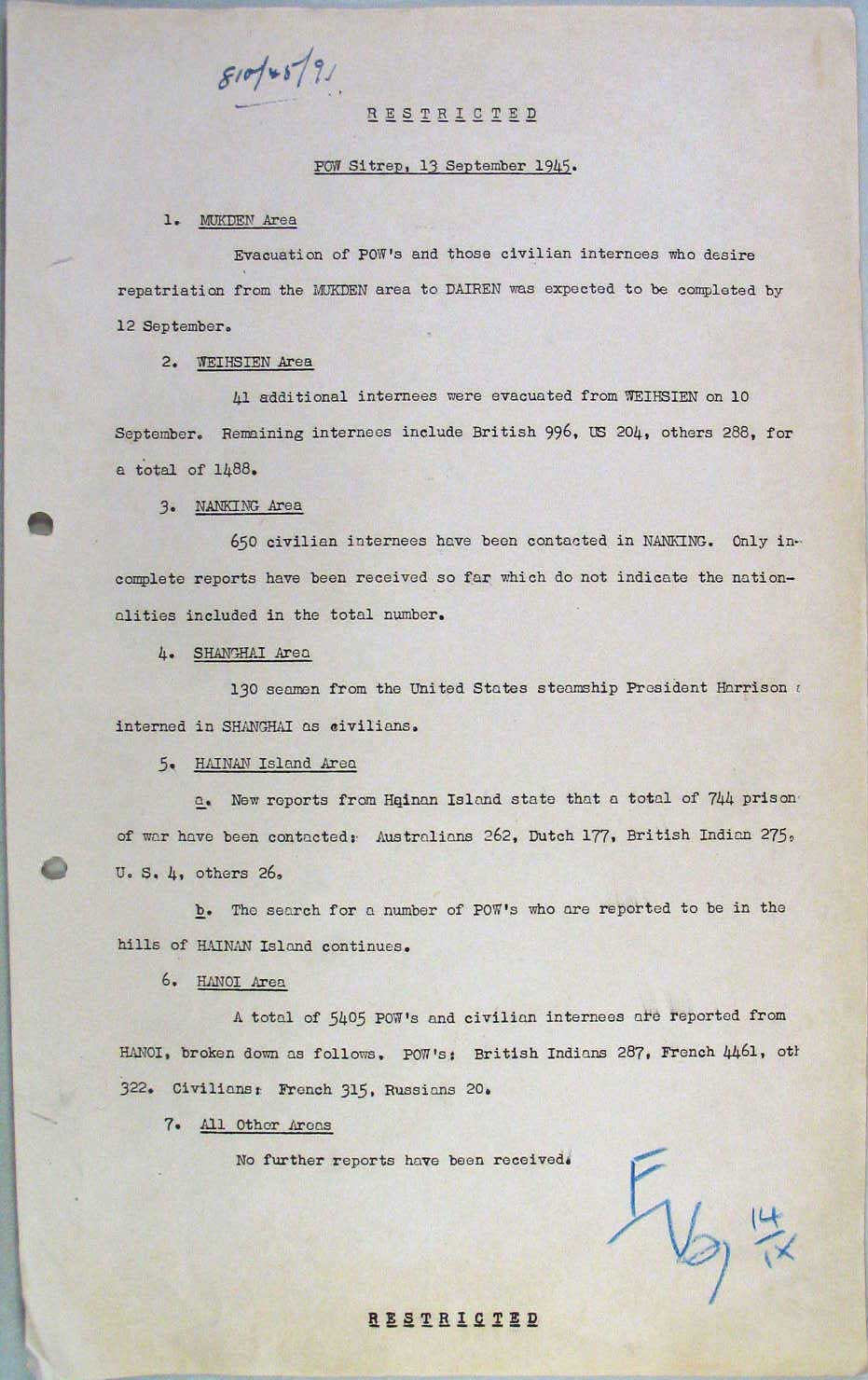
RESTRICTED
POW Sitrep, 13 September 1945.
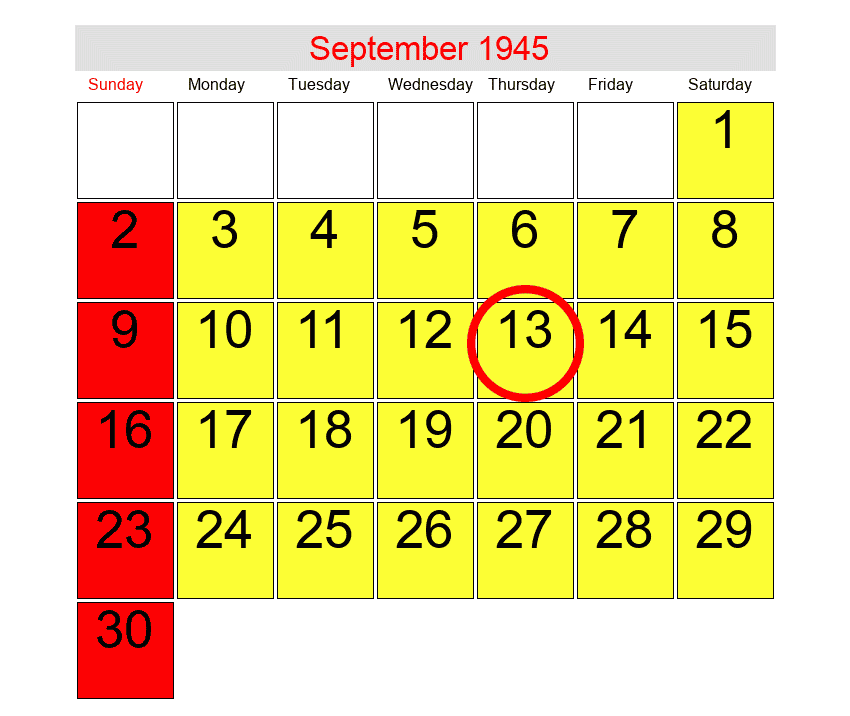 1.
1.
MUKDEN Area
Evacuation of POWs and those civilian internees who desire repatriation from the MUKDEN area to DAIREN was expected to be completed by 12 September.
2.
WEIHSIEN Area
Forty-one additional internees were evacuated from WEIHSIEN on 10 September. Remaining internees include British 996, US 204, other 288, for a total of 1488.
3.
NANKING Area
Six hundred and fifty civilian internees have been contacted in NANKING. Only incomplete reports have been received so far which do not indicate the nationalities included in the total number.
4.
SHANGHAI Area
One hundred and thirty seamen from the United States steamship President Harrison interned in SHANGHAI as civilians.
5.
HAINAN Island Area
a.
New reports from Hainan Island state that a total of 744 prisoners of war have been contacted: Australians 262, Dutch 177, British Indian 275, U. S. 4, other 26.
b.
The search for a number of POWs who are reported to be in the hills of HAINAN Island continues.
6.
HANOI Area
A total of 5405 POWs and civilian internees are reported from HANOI, broken down as follows. POWs: British Indians 287. French 4461, other 322. Civilians: French 315, Russians 20.
7.
All Other Areas
No further reports have been received.
RESTRICTED

September 15, 1945
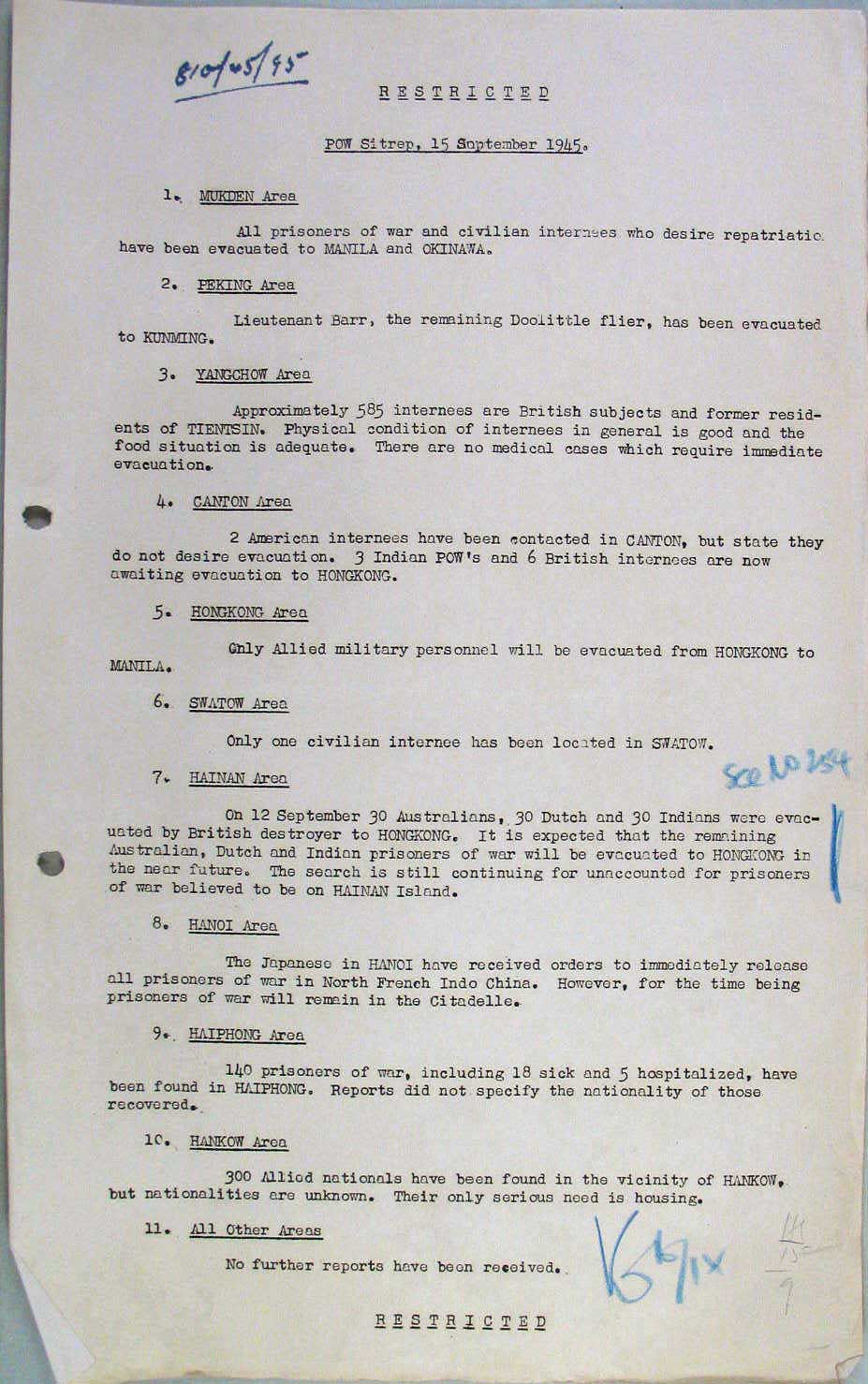
RESTRICTED
POW Sitrep, 15 September 1945.
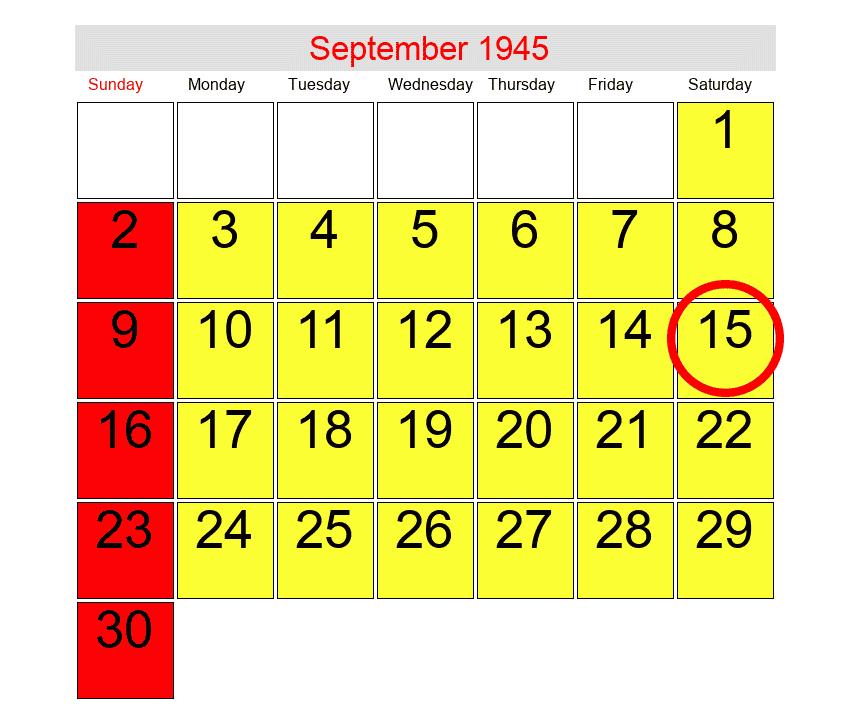 1.
1.
MUKDEN Area
All prisoners of war and civilian internees who desire repatriation have been evacuated to MANILA and OKINAWA.
2.
PEKING Area
Lieutenant Barr, the remaining Doolittle flier, has been evacuated to KUNMING.
3.
YANGCHOW Area
Approximately 585 internees are British subjects and former residents of TIENTSIN. Physical condition of internees in general is good and the food situation is adequate. There are no medical cases which require immediate evacuation.
4.
CANTON Area
Two American internees have been contacted in CANTON, but state they do not desire evacuation. 3 Indian POWs and 6 British internees are now awaiting evacuation to HONG KONG.
5.
HONG KONG Area
Only Allied military personnel will be evacuated from HONG KONG to MANILA.
6.
SWATOW Area
Only one civilian internee has been located in SWATOW.
7.
HAINAN Area
On 12 September 30 Australians, 30 Dutch and 30 Indians were evacuated by the British destroyer to HONG KONG. It is expected that the remaining Australian, Dutch and Indian prisoners of war will be evacuated to HONG KONG le the near future. The search is still continuing for unaccounted prisoners of war believed to be on HAINAN Island.
8.
HANOI Area
The Japanese in HANOI have received orders to immediately release all prisoners of war in North French Indo-China. However, for the time being prisoners of war will remain in the Citadelle.
9.
HAIPHONG Area
One hundred and forty prisoners of war, including 18 sick and 5 hospitalised, have been found in HAIPHONG. Reports did not specify the nationality of those recovered.
10.
HANKOW Area
Three hundred Allied nationals have been found in the vicinity of HANKOW, but nationalities are unknown. Their only serious need is housing.
11.
All Other Areas
No further reports have been received.
RESTRICTED

September 18, 1945
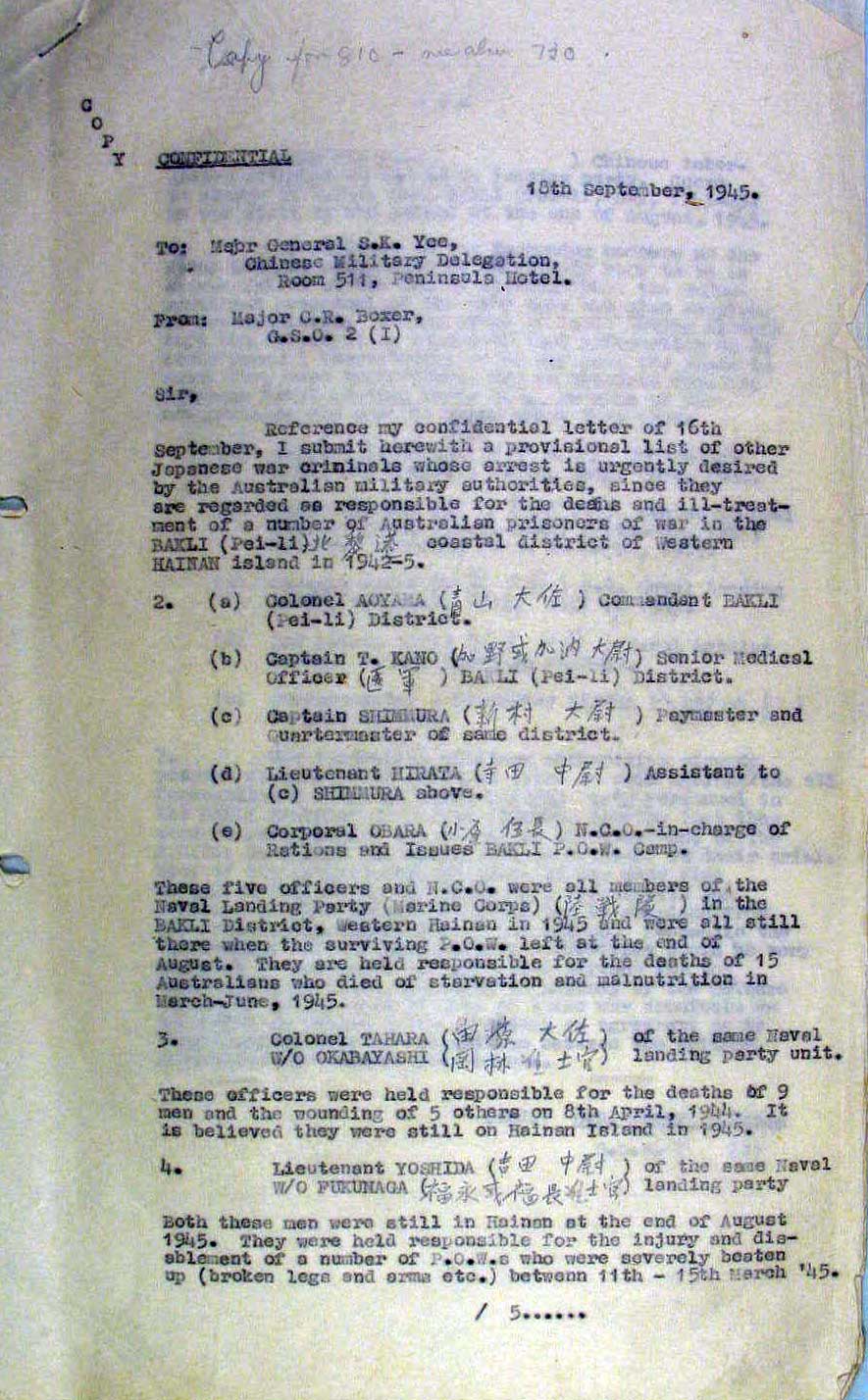
CONFIDENTIAL
COPY
18 September 1945
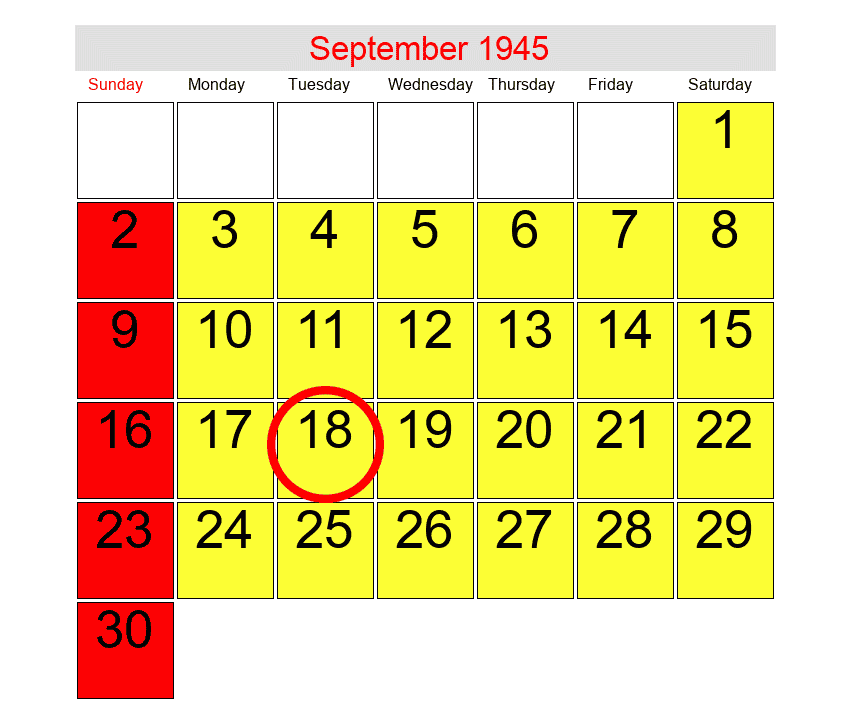 To: Major General S.K. Yee,
To: Major General S.K. Yee,
Chinese Military Delegation,
Room 511, Peninsula Hotel
From: Major C.R. Boxer,
G.S.O. 2 (1)
Sir,
Reference my confidential letter of 16th September; I submit herewith a provisional list of other Japanese war criminals whose arrest is urgently desired by the Australian military authorities, since they are regarded as responsible for the deaths and ill-treatment of a number of Australian prisoners of war in the BAKLI (Pei-li) coastal district of Western HAINAN island in 1942-45.
2.
(a) Colonel AOYAMA () Commandant BAKLI (Pei-li) District
(b) Captain T.KANO () Senior Medical Officer () BAKLI (Pei-li) District.
(c) Captain SHIMMURA () Paymaster and Quartermaster of same district.
(d) Lieutenant HIRATA () Assistant to (c) SHIMMURA above.
(e) Corporal OBARA () N.C.O.-in-charge of Rations and Issues BAKLI P.O.W. Camp.
These five officers and N.C.O. were all members of the Naval Landing Party (Marine Corps) () in the BAKLI District, Western HAINAN in 1945 and were all still there when the surviving POW left at the end of August. They are held responsible for the deaths of 15 Australians who died of starvation and malnutrition in March-June 1945.
3.
Colonel TAHARA () of the same Naval W/O OKABAYASHI () landing party unit.
These officers were held responsible for the deaths of 9 men and the wounding of 5 others on 8 April 1944. It is believed they were still on Hainan Island in 1945.
4.
Lieutenant YOSHIDA () of the same Naval W/O FUKUNAGA () landing party.
Both these men were still in Hainan at the end of August 1945. They were held responsible for the injury and disablement of a number of POWs who were severely beaten up (broken legs and arms, etc.) between 11th-15th March '45.
…

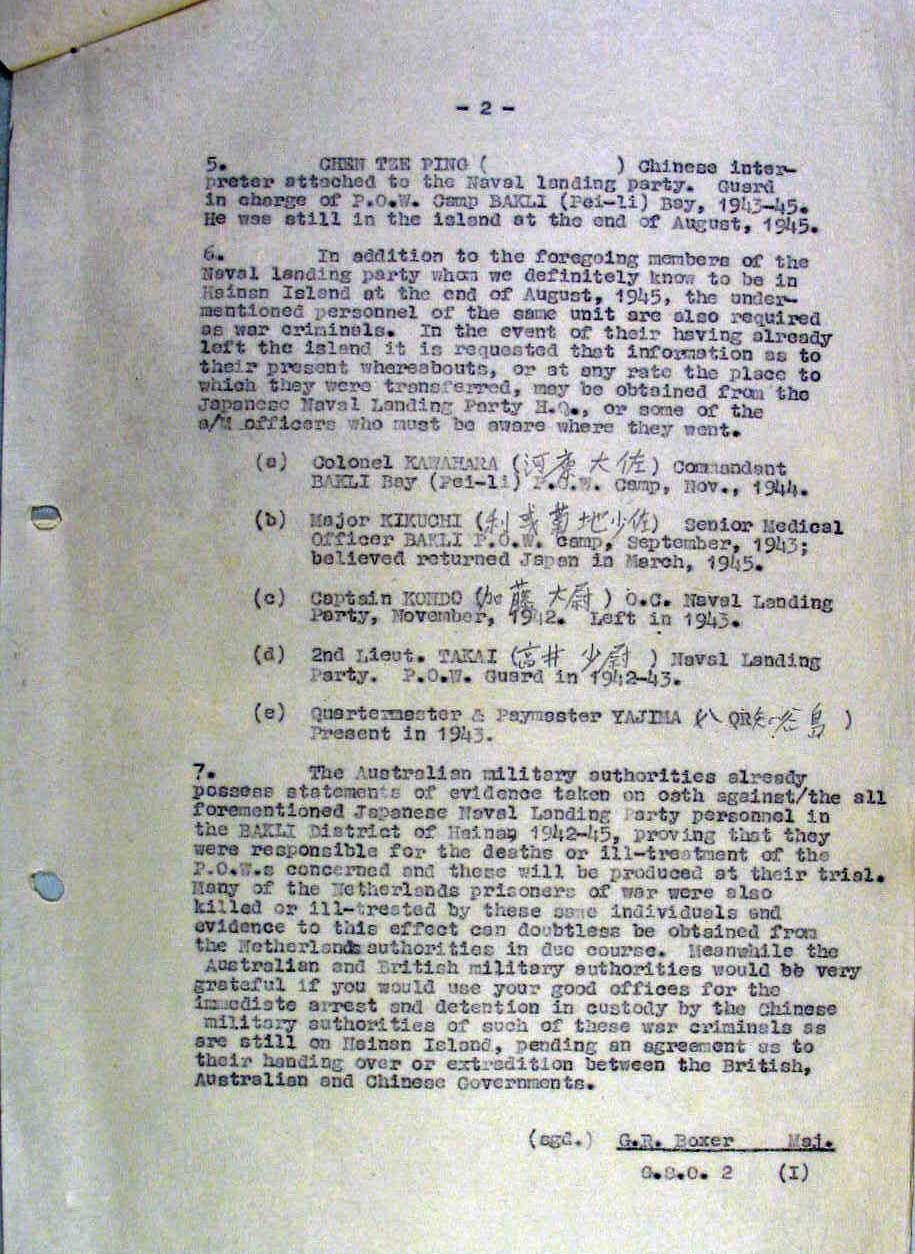
…
5.
CHEN TEE PING () Chinese interpreter attached to the Naval landing party. Guard in charge of POW Camp BAKLI (Pei-li) Bay, 1943-45. He was still in the island at the end of August 1945.
6.
In addition to the foregoing members of the Naval landing party whom we definitely know to be in HAINAN Island at the end of August 1945, the undermentioned personnel of the same unit are also required as war criminals. In the event of their having already left the island, it is requested that information as to their present whereabouts, or at any rate the place to which they were transferred, may be obtained from the Japanese Naval Landing Party H.Q., or some of the a/M officers who must be aware where they went.
(a) Colonel KAWAHARA () Commandant BAKLI Bay (Pei-li) POW Camp, Nov. 1944.
(b) Major KIKUCHI () Senior Medical Officer BAKLI POW camp, September 1943; believed returned Japan in March 1945.
(c) Captain KONDO () O.C. Naval Landing Party, November 1942. Left in 1943.
(d) 2nd. Lieut. TAKAI () Naval Landing Party. POW Guard in 1942-43.
(e) Quartermaster & Paymaster YAJIMA () Present in 1943.
7.
The Australian military authorities already possess statements of evidence taken on oath against the all fore-mentioned Japanese Naval Landing Party personnel in the BAKLI District of HAINAN, 1942-45, providing that they were responsible for the deaths or ill-treatment of the POWs concerned and these will be produced at their trial.
Many of the Netherlands prisoners of war were also killed or ill-treated by these same individuals and evidence to this effect can doubtless be obtained from the Netherlands authorities in due course. Meanwhile the Australian and British military authorities would be very grateful if you would use your good offices for the immediate arrest and detention in custody by the Chinese military authorities of such of these war criminals as are still on Hainan Island, pending an agreement as to their handing over or extradition between the British, Australian and Chinese Governments.
(sgd.) G.R. Boxer Maj. G.S.O. 2 (I)
⚠ in brackets, "()" are the Chinese trascriptions of the forementioned names. GoTo the documents in question to read them.
September 19, 1945
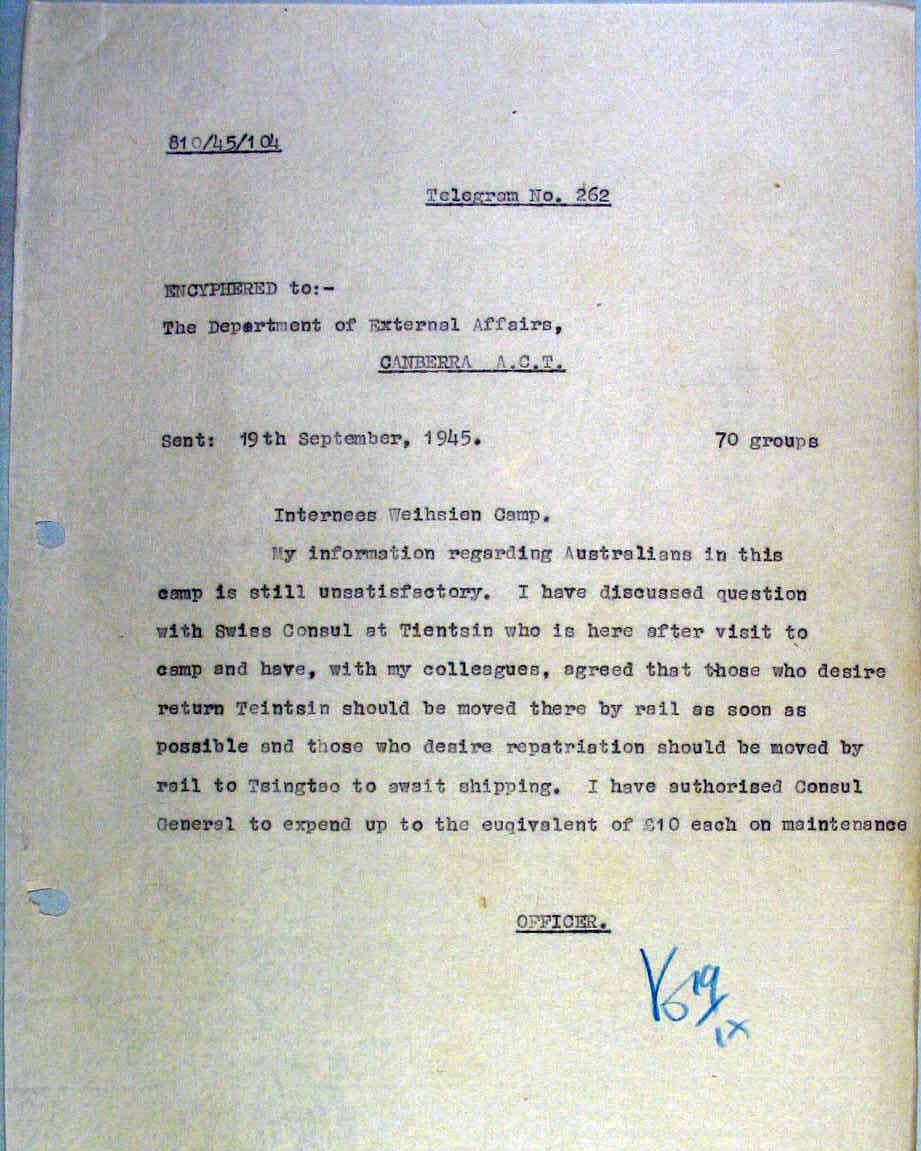
810/45/1 04
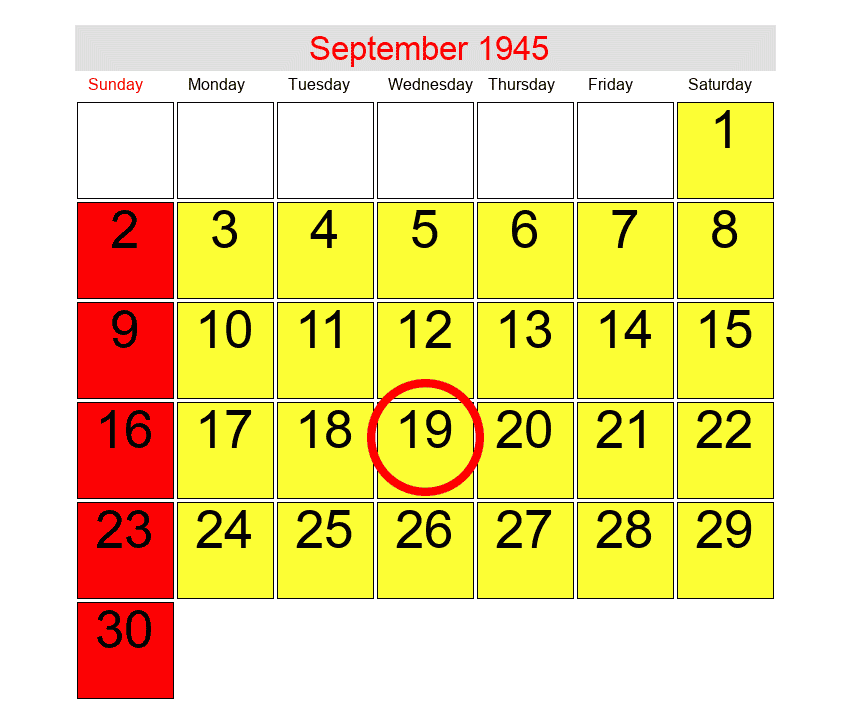 Telegram No. 262
Telegram No. 262
ENCYPHERED to:-
The Department of External Affairs,
CANBERRA A.C.T.
Sent: 19 September 1945.
70 groups
Internees Weihsien Camp.
My information regarding Australians in this camp is still unsatisfactory. I have discussed question with Swiss Consul at Tientsin who is here after a visit to camp and has, with my colleagues, agreed that those who desire return Tientsin should be moved there by rail as soon as possible and those who desire repatriation should be moved by rail to Tsingtao to await shipping. I have authorised Consul General to expend up to the equivalent of £10 each on maintenance.
OFFICER

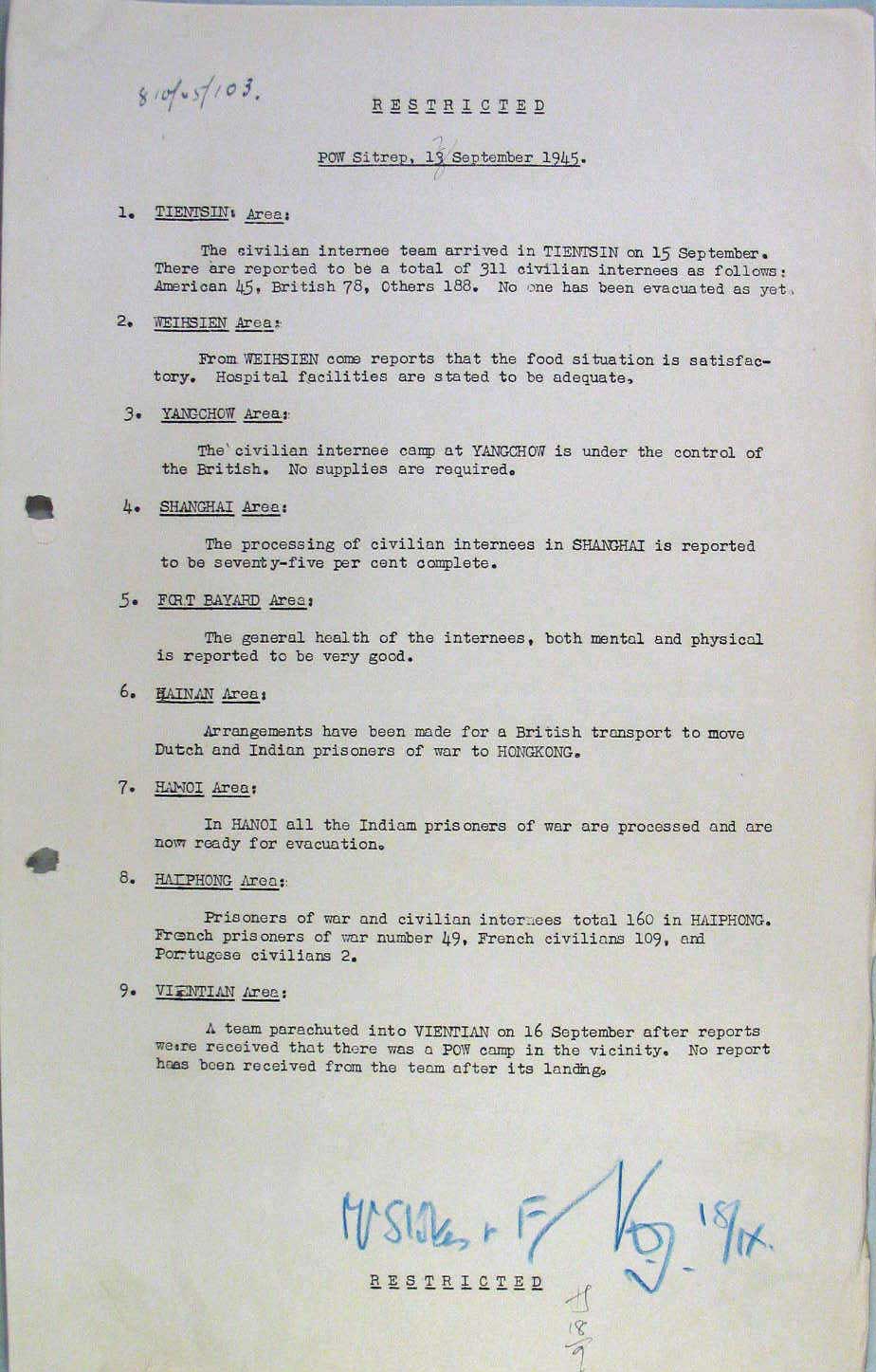
RESTRICTED
POW Sitrep, 19 September 1945.
1.
TIENTSIN Area:
The civilian internee team arrived in TIENTSIN on 15 September. There is reported to be a total of 311 civilian internees as follows: American 45, British 78, Other 188. No one has been evacuated as yet.
2.
WEIHSIEN Area:
From WEIHSIEN come reports that the food situation is satisfactory. Hospital facilities are stated to be adequate.
3.
YANGCHOW Area:
The civilian internee camp at YANGCHOW is under the control of the British. No supplies are required.
4.
SHANGHAI Area:
The processing of civilian internees in SHANGHAI is reported to be seventy-five per cent complete.
5.
FORT BAYARD Area:
The general health of the internees, both mental and physical is reported to be very good.
6.
HAINAN Area:
Arrangements have been made for a British transport to move Dutch and Indian prisoners of war to HONG KONG.
7.
HANOI Area:
In HANOI all the Indian prisoners of war are processed and are now ready for evacuation.
8.
HAIPHONG Area:
Prisoners of war and civilian internees total 160 in HAIPHONG. French prisoners of war number 49, French civilians 109, and Portuguese civilians 2.
9.
VIENTIANE Area:
A team parachuted into VIENTIANE on 16 September after reports were received that there was a POW camp in the vicinity. No report has been received from the team after its landing.
RESTRICTED.
September 20, 1945
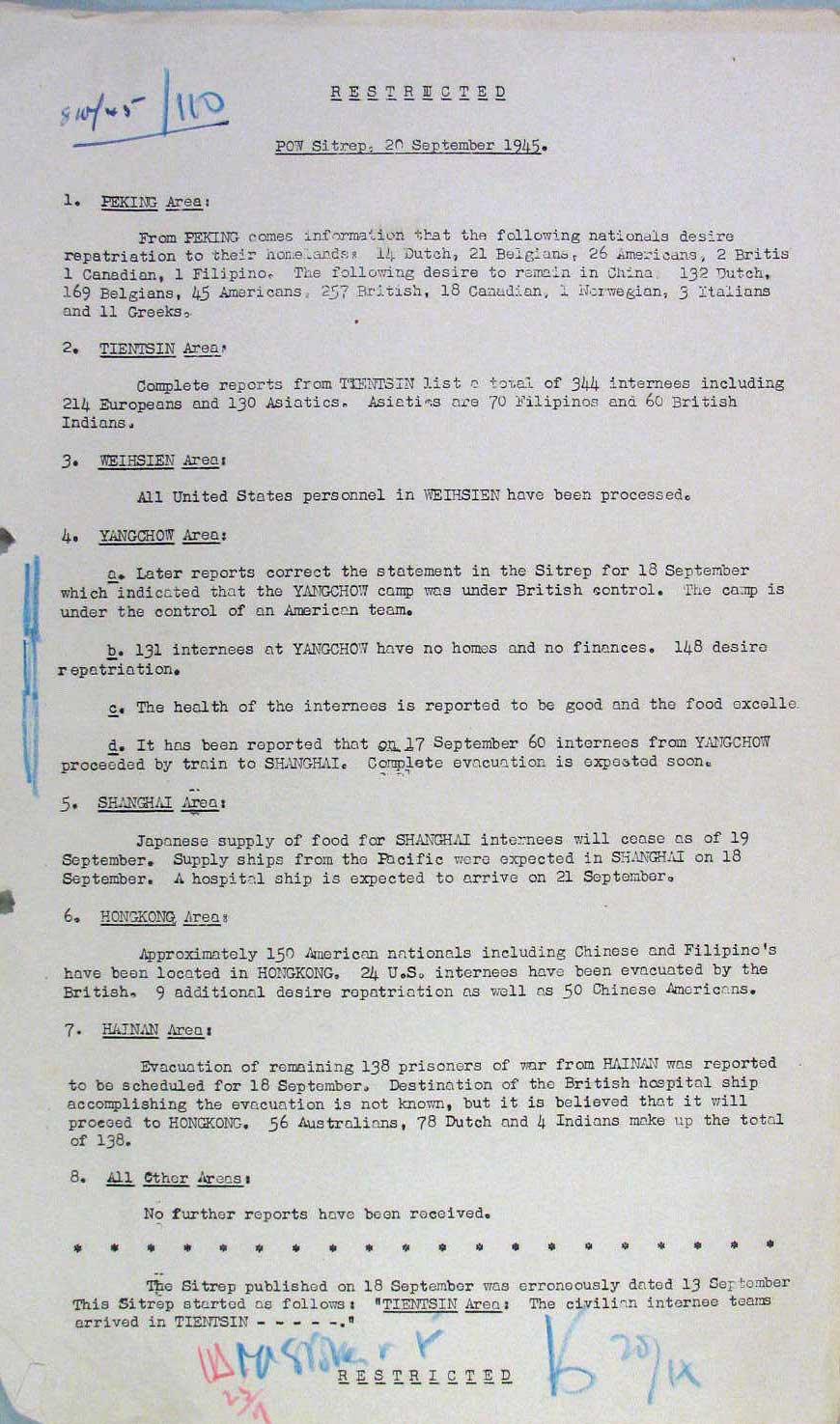
RESTRICTED
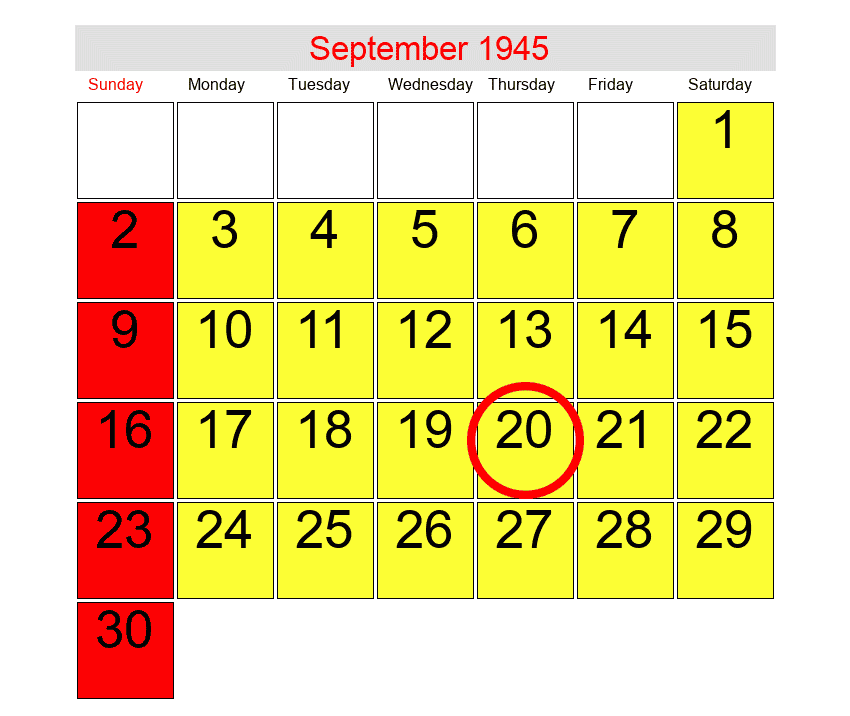 POW Sitrep, 20 September 1945.
POW Sitrep, 20 September 1945.
1.
PEKING Area:
From PEKING comes information that the following nationals desire repatriation to their homelands: 14 Dutch, 21 Belgians, 26 Americans, 2 British 1 Canadian, 1 Filipino. The following desire to remain in China 132 Dutch, 169 Belgians, 45 Americans, 257 British, 18 Canadian, 1 Norwegian, 3 Italians and 11 Greeks.
2.
TIENTSIN Area:
Complete reports from TIENTSIN list a total of 344 internees including 214 Europeans and 130 Asiatics. Asiatics are 70 Filipinos and 60 British Indians.
3.
WEIHSIEN Area:
All United States personnel in WEIHSIEN have been processed.
4.
YANGCHOW Area:
a.
Later reports correct the statement in the Sitrep for 18 September which indicated that the YANGCHOW camp was under British control. The camp is under the control of an American team.
b.
One hundred and thirty-one internees at YANGCHOW have no homes and no finances. One hundred and forty-eight desire repatriation.
c.
The health of the internees is reported to be good and the food excellent.
d.
It has been reported that on 17 September 60 internees from YANGCHOW proceeded by train to SHANGHAI. Complete evacuation is expected soon.
5.
SHANGHAI Area:
Japanese supply of food for SHANGHAI internees will cease as of 19 September. Supply ships from the Pacific were expected in SHANGHAI on 18 September. A hospital ship is expected to arrive on 21 September.
6.
HONG KONG Area:
Approximately 150 American nationals including Chinese and Filipinos have been located in HONG KONG. Twenty-four U.S. internees have been evacuated by the British. Nine additional desire repatriation as well as 50 Chinese Americans.
7.
HAINAN Area:
Evacuation of remaining 138 prisoners of war from HAINAN was reported to be scheduled for 18 September. Destination of the British hospital ship accomplishing the evacuation is not known, but it is believed that it will proceed to HONG KONG. Fifty-six Australians, 78 Dutch and 4 Indians make up the total of 138.
8.
All Other Areas:
No further reports have been received.
* * * * * * * * * * * * * * * * * * * * * * * * * * * * * * * * * *
The Sitrep published on 18 September was erroneously dated 13 September This Sitrep started as follows: "TIENTSIN Area: The civilian internee teams arrived in TIENTSIN, etc."
RESTRICTED

September 25, 1945
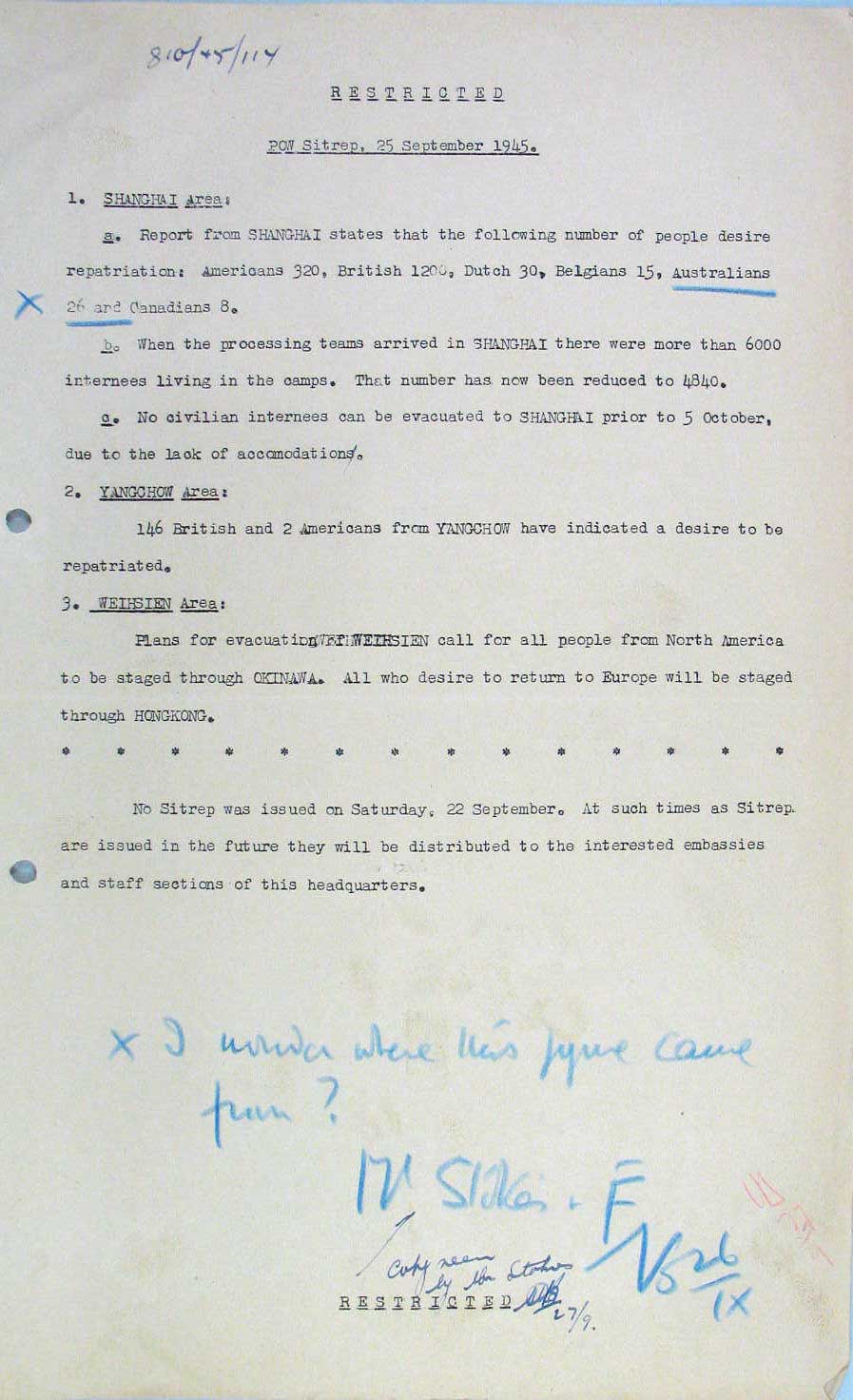
RESTRICTED
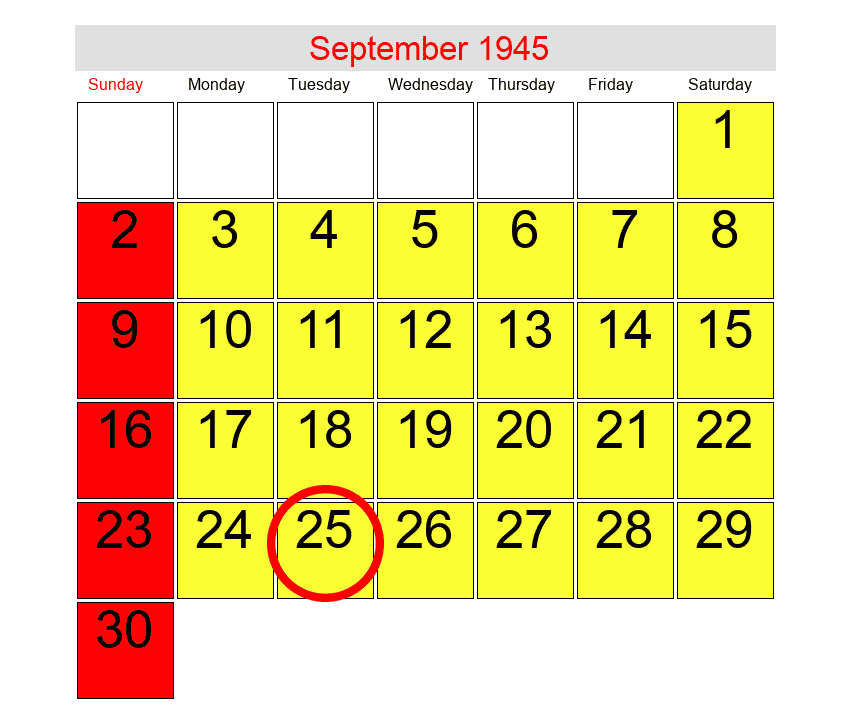 POW Sitrep, 25 September 1945.
POW Sitrep, 25 September 1945.
1.
SHANGHAI Area:
a.
Report from SHANGHAI states that the following number of people desire repatriation: Americans 320, British 1206, Dutch 30, Belgians 15, Australians 26 and Canadians 8.
b.
When the processing teams arrived in SHANGHAI there were more than 6000 internees living in the camps. That number has now been reduced to 4840.
c.
No civilian internees can he evacuated to SHANGHAI prior to 5 October, due to the lack, of accommodation.
2.
YANGCHOW Area:
146 British and 2 Americans from YANGCHOW have indicated a desire to be repatriated.
3.
WEIHSIEN Area:
Plans for evacuation of WEIHSIEN call for all people from North America to be staged through OKINAWA. All who desire to return to Europe will be staged through HONG KONG.
* * * * * * * * * * * * * * * * * * * * * * * * * * * * * * *
No Sitrep was issued on Sunday, 22 September. At such times as Sitrep are issued in the future, they will be distributed to the interested embassies and staff sections of this headquarters.
RESTRICTED

October 9, 1945
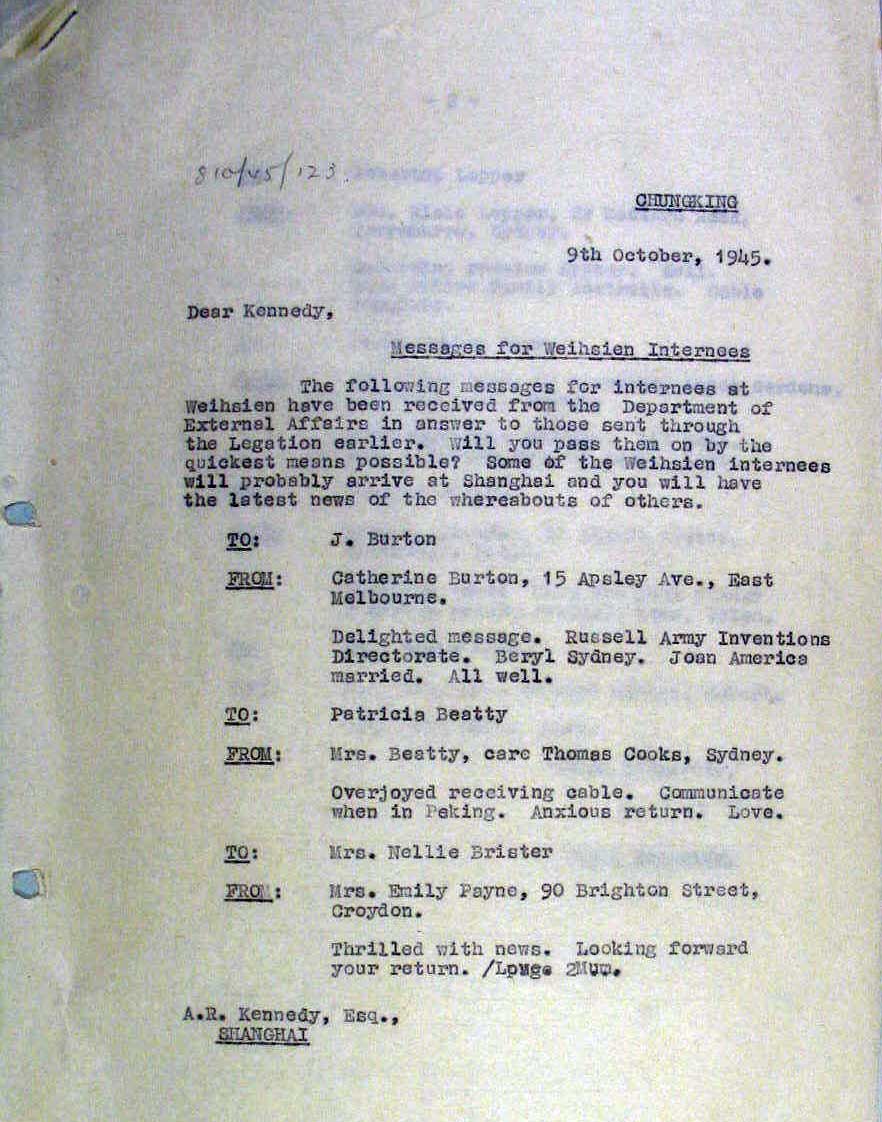
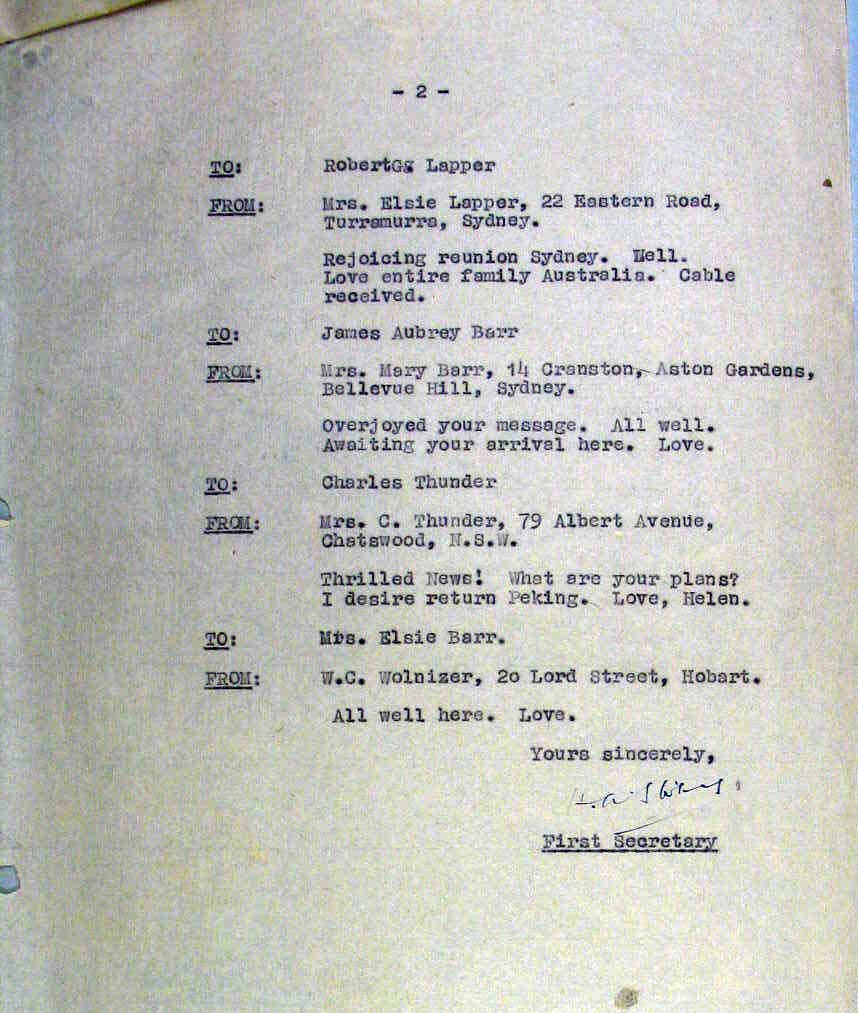
CHUNGKING
9th October, 1945.
Dear Kennedy,
Messages for Weihsien Internees
The following messages for internees at Weihsien have been received from the Department of External Affairs in answer to those sent through the Legation earlier. Will you pass them on by the quickest means possible? Some of the Weihsien internees will probably arrive at Shanghai and you will have the latest news of the whereabouts of others.
TO: J. Burton
FROM: Catherine Burton, 15 Apsley Ave., East
Melbourne.
Delighted message. Russell Army Inventions Directorate. Beryl Sydney. Joan America married. All well.
T0: Patricia Beatty
FROM: Mrs. Beatty, care Thomas Cooks, Sydney.
Overjoyed receiving cable. Communicate when in Peking. Anxious return. Love.
TO: Mrs. Nellie Brister
FROM : Mrs. Emily Payne, 90 Brighton Street,
Croydon.
Thrilled with news. Looking forward your return. /Love 2Mum.
A.R. Kennedy, Esq., SHANGHAI
TO: Roberts Lapper
FROM: Mrs. Elsie Lapper, 22 Eastern Road,
Turramurra, Sydney.
Rejoicing reunion Sydney. Well. Love entire family Australia. Cable received.
T0: James Aubrey BarrFrom:
FROM: Mrs.. Mary Barr, 14 Cranston, Aston Gardens,
Bellevue Hill, Sydney.
Overjoyed your message. All well. Awaiting your arrival here. Love.
TO: Charles Thunder
FROM: Mrs. C. Thunder, 79 Albert Avenue,
Chatswood, N.S.W.
Thrilled News! What are your plans? I desire return Peking. Love, Helen.
TO: Mrs. Elsie Barr.
FROM: W.C. Wolnizer, 20 Lord Street, Hobart.
All well here. Love.
Yours sincerely,
(signed) … First Secretary
October 25, 1945
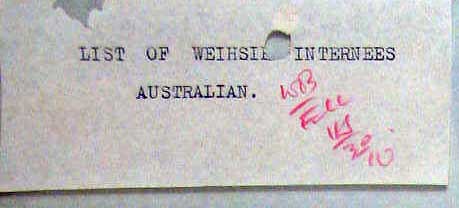
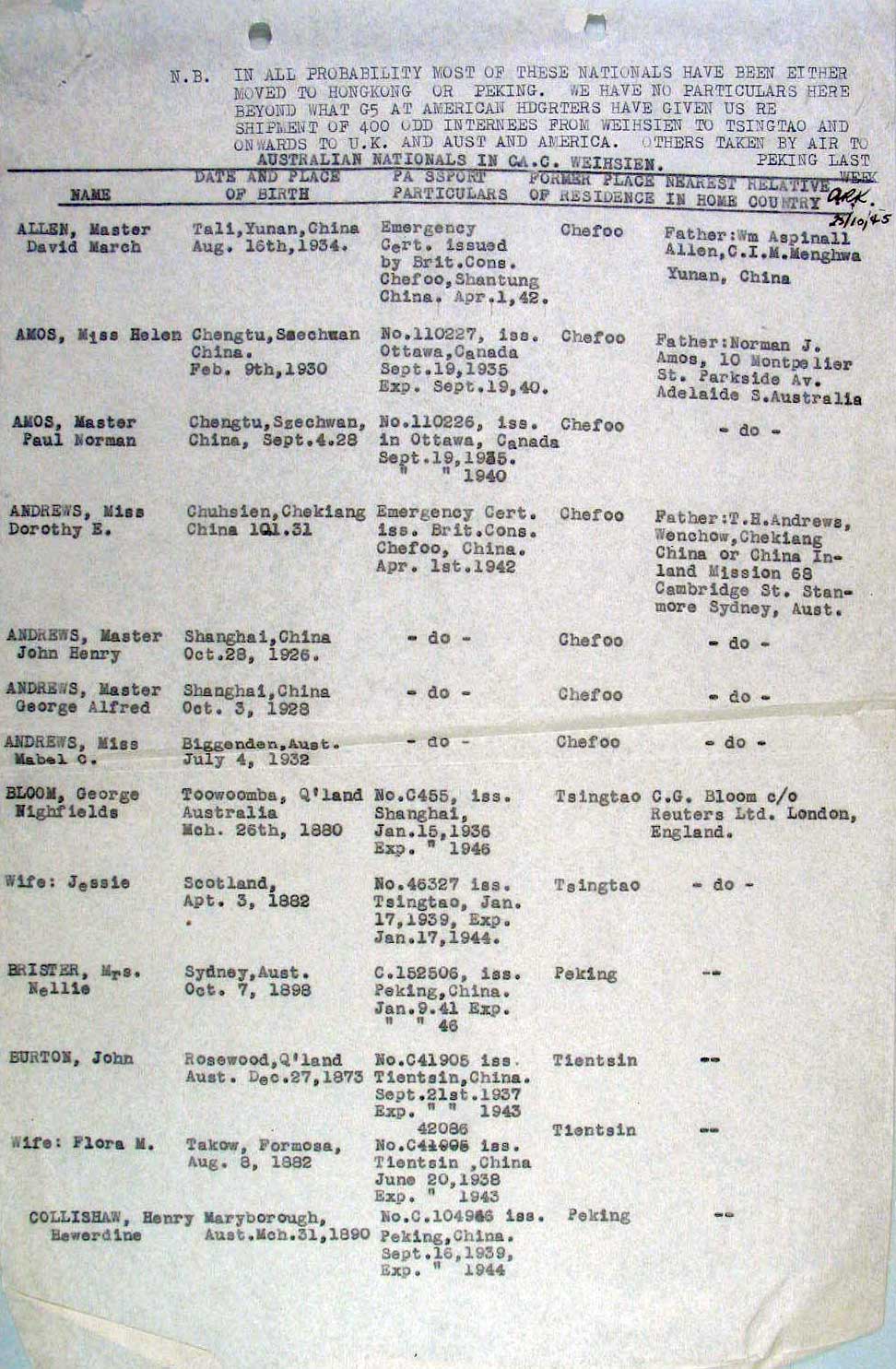
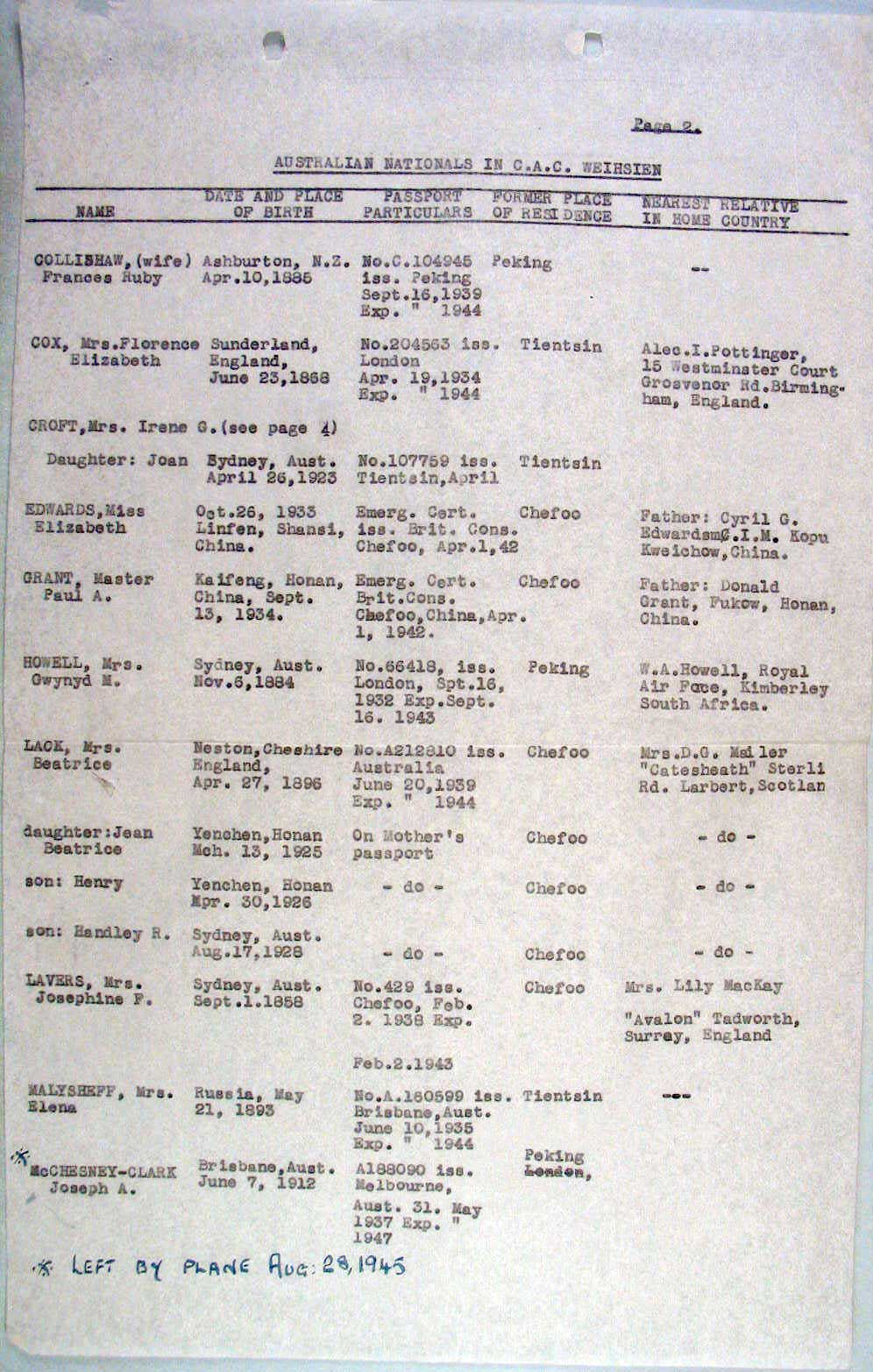
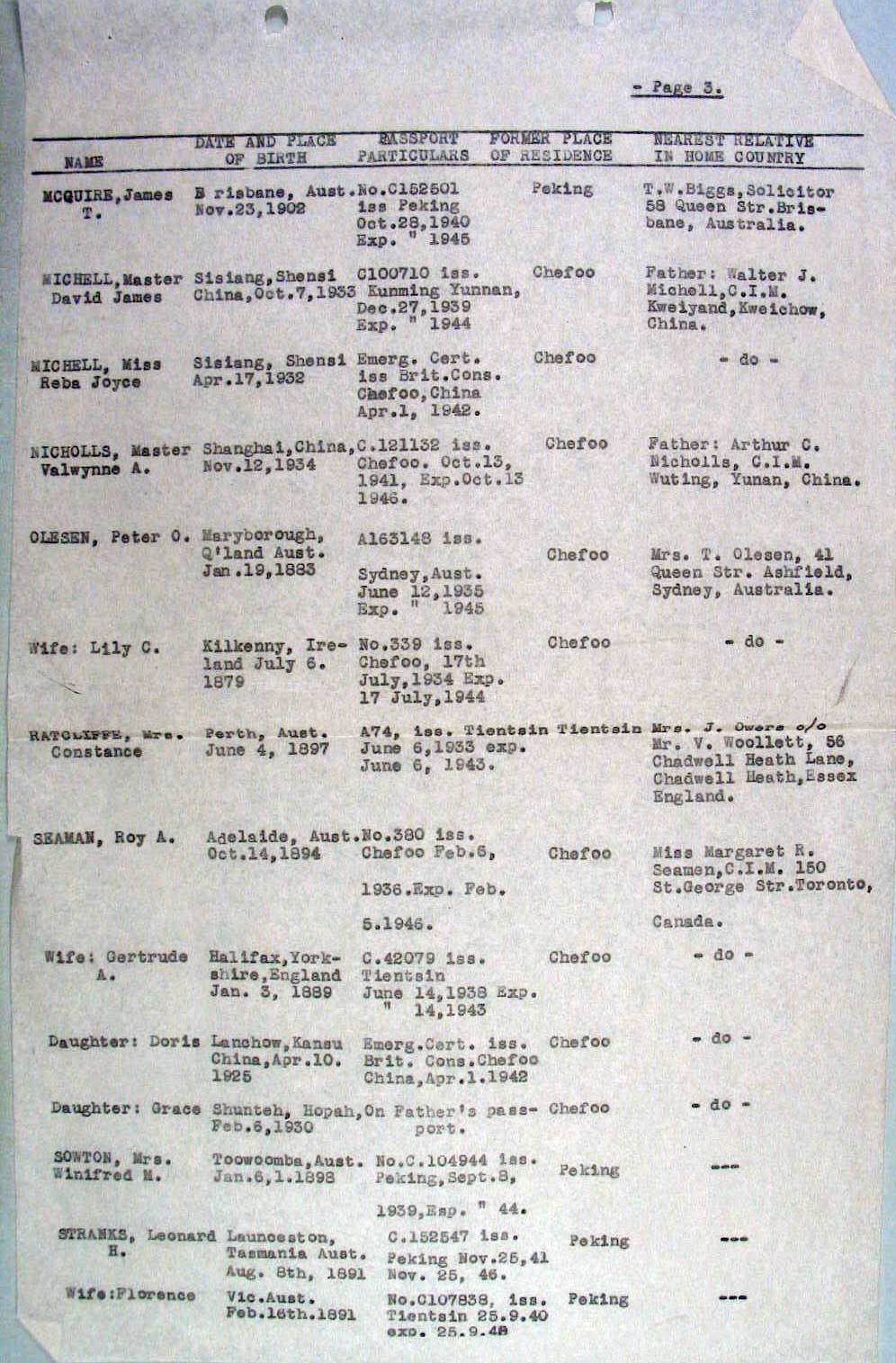
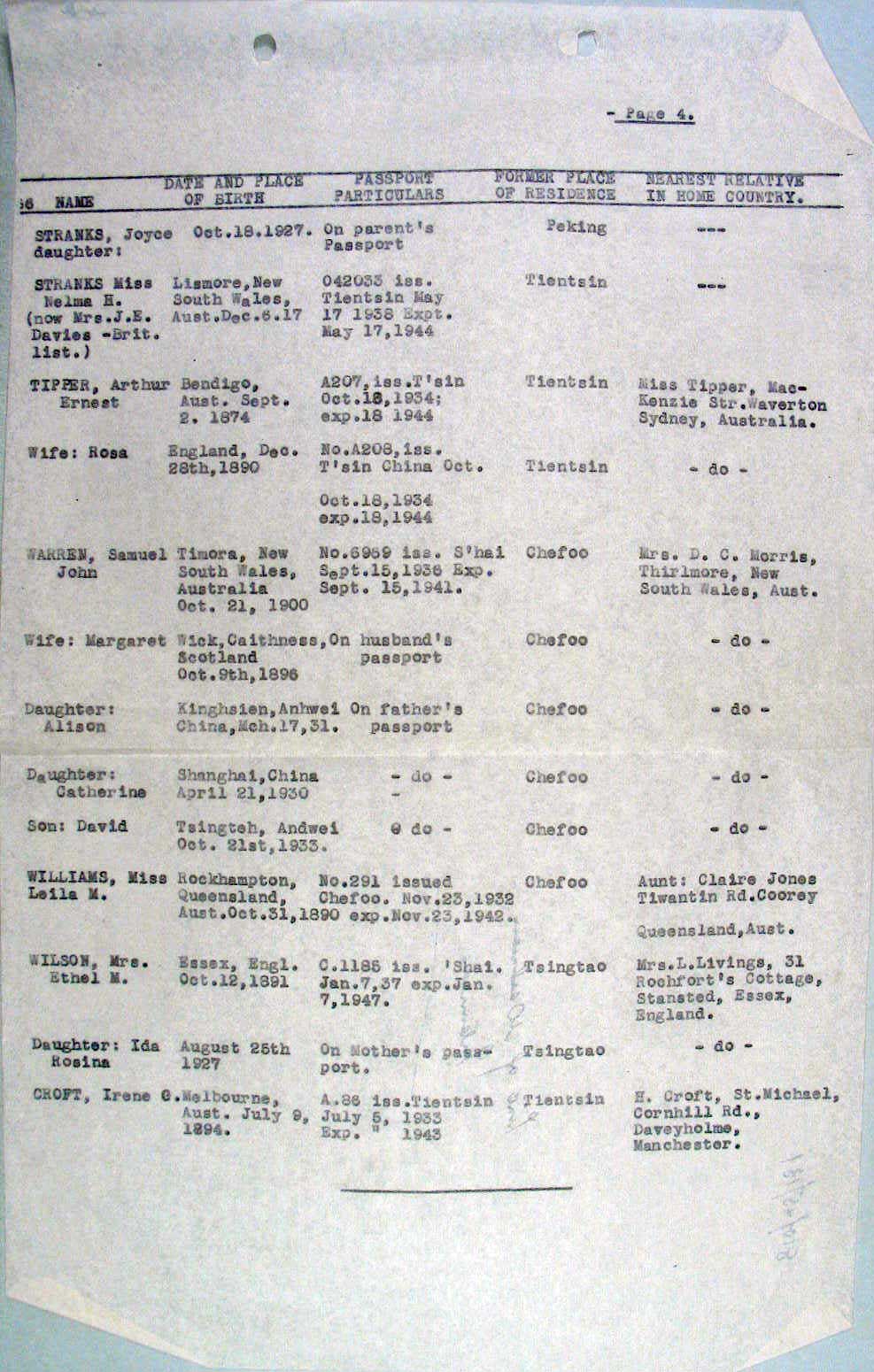
November 16, 1945
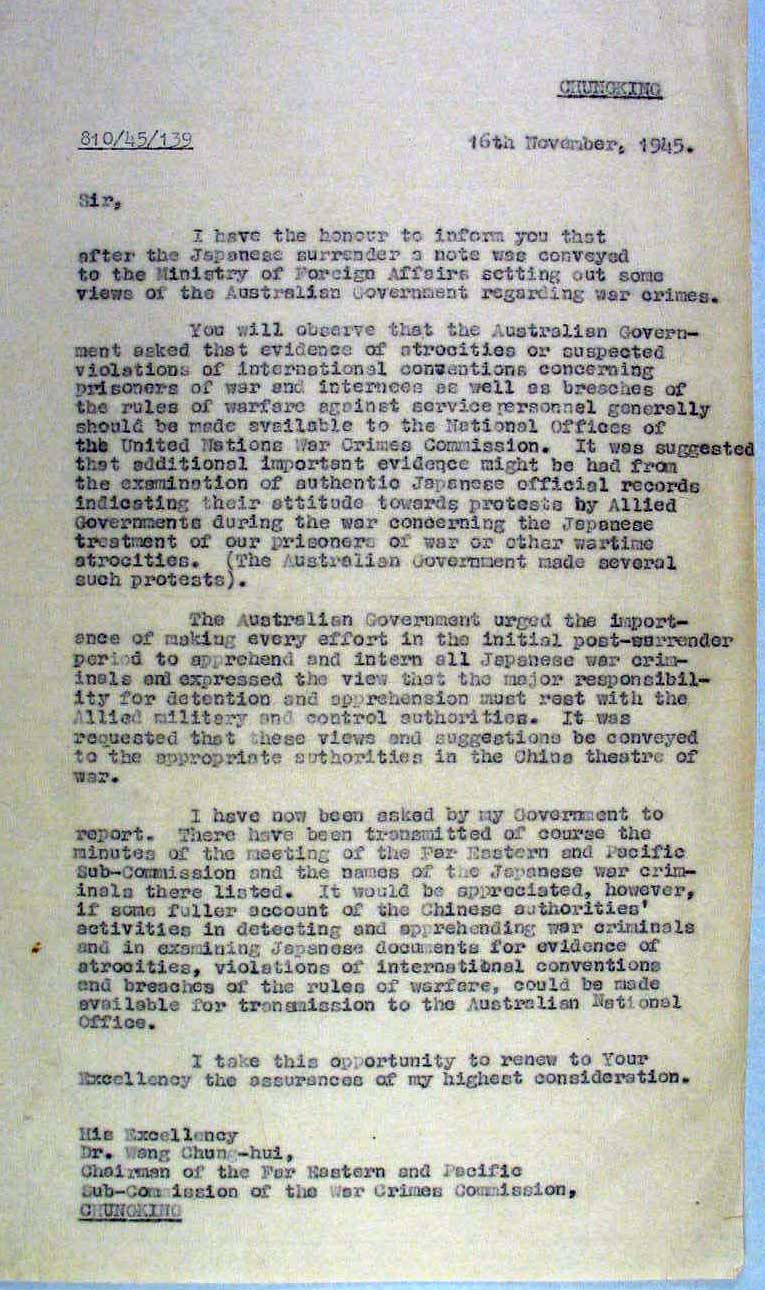
810/45/139
CHUNGKING
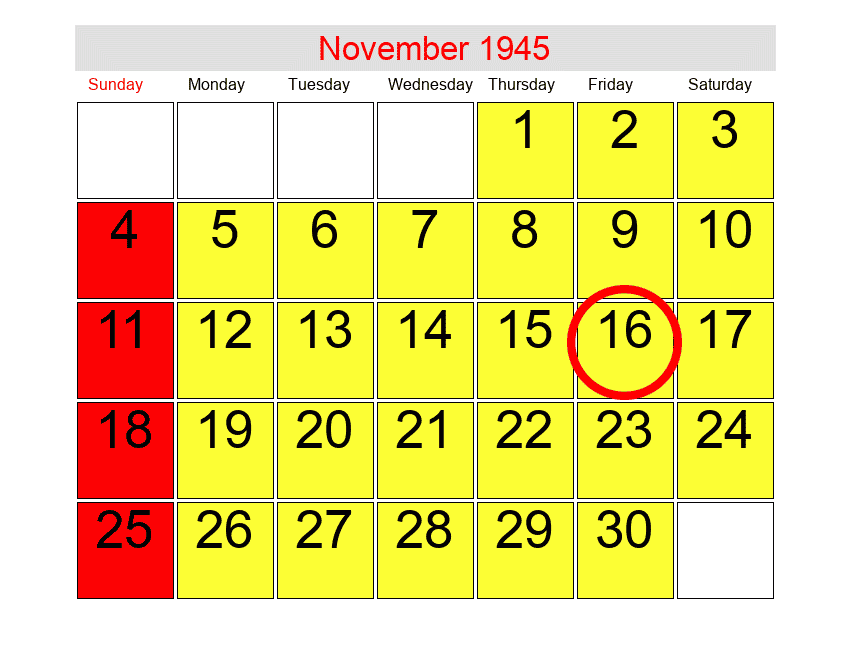 16 November 1945.
16 November 1945.
Sir,
I have the honour to inform you that after the Japanese surrender a note was conveyed to the Ministry of Foreign Affairs setting out some views of the Australian Government regarding war crimes.
You will observe that the Australian Government asked that evidence of atrocities or suspected violations of international conventions concerning prisoners of war and internees as well as breaches of the rules of warfare against service personnel generally should be made available to the National offices of the United Nations War Crimes Commission. It was suggested that additional important evidence might be had from the examination of authentic Japanese official records indicating their attitude toward protests by Allied Governments during the war concerning the Japanese treatment of our prisoners of war or other wartime atrocities. (The Australian Government made several such protests.)
The Australian Government urged the importance of making every effort in the initial post-surrender period to apprehend and intern all Japanese war criminals and expressed the view that the major responsibility for detention and apprehension must rest with the Allied military and control authorities in the China theatre of war.
I have now been asked by my Government to report. There have been transmitted, of course, the minutes of the meeting of the Far Eastern and Pacific Sub-Commission and the names of the Japanese war criminals there listed. It would be appreciated, however, if some fuller account of the Chinese authorities’ activities in detecting and apprehending war criminals and in examining Japanese documents for evidence of atrocities, violations of international conventions and breaches of the rules of warfare, could be made available for transmission to the Australian National Office.
I take this opportunity to renew to Your Excellency the assurance of my highest consideration.
His Excellency
Dr. Wang Chung-hui,
Chairman of the Far Eastern and Pacific
Sub-Commission of the War Crimes Commission,
CHUNGKING






